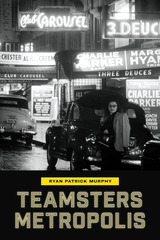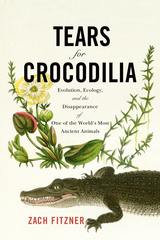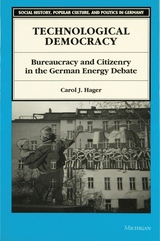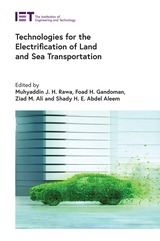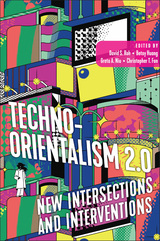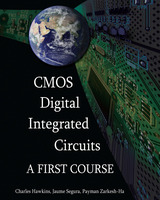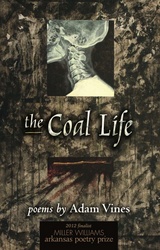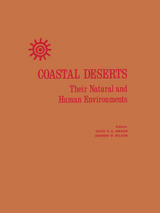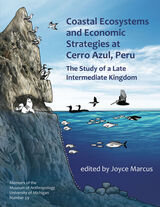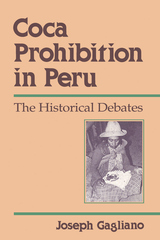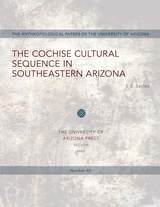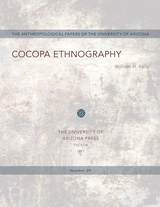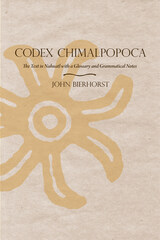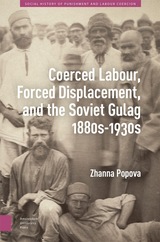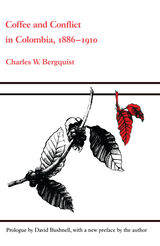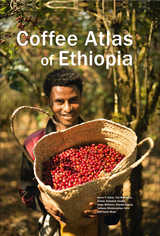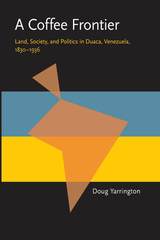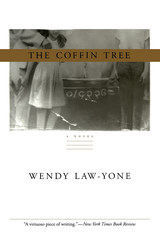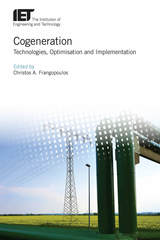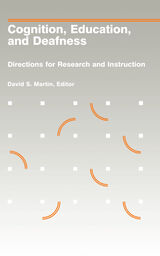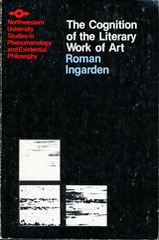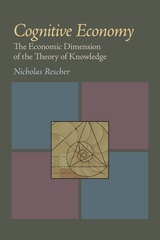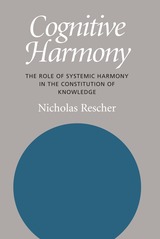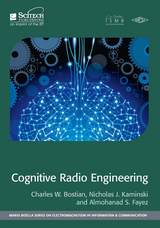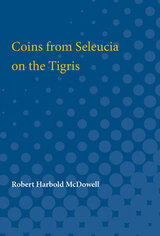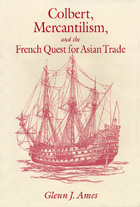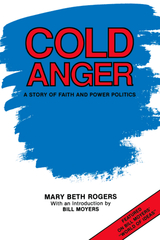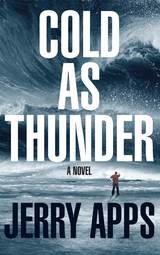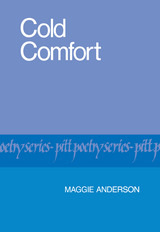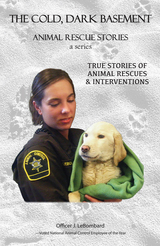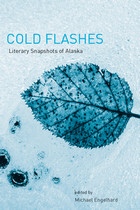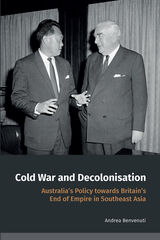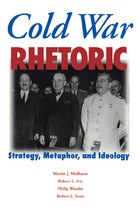 Clutch: An Education at Work
Linda Pawlenty
Ohio State University Press, 2025 Driving a concrete mixer throughout graduate school, Linda Pawlenty became accustomed to being the odd one out: as a working-class laborer in academia and as a woman and an academic in the construction industry. But from the moment she became a truck driver, Pawlenty loved the satisfaction of proving herself, the thrill of coaxing large machines into place with precision and care. Similarly, when beginning a PhD program in literature, she maneuvered her way through the strange territory of the university, proud to be the first in her family to attempt the degree. In Clutch, she recounts her time shuttling between worlds, delivering with bracing clarity a rare perspective on gender, class, labor, and whiteness—and how the implications of each shift according to context. From enduring sexual harassment at construction sites and classist comments from professors to the joys of driving a truck and finding academic fulfillment, Pawlenty takes stock of her disparate experiences to ask hard questions about power and acceptance, providing a beacon for those fighting for presence in places they are not expected—and not always welcome—to be.
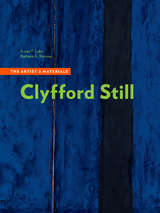 Clyfford Still: The Artist’s Materials
Susan F. Lake
J. Paul Getty Trust, The, 2022 This groundbreaking book provides the first detailed account of the materials and techniques of perhaps the most radical—and until now, least studied—major American Abstract Expressionist.
Among the most radical of the great American Abstract Expressionist painters, Clyfford Still has also long been among the least studied. Still severed ties with the commercial art world in the early 1950s, and his estate at the time of his death in 1980 comprised some 3,125 artworks—including more than 800 paintings—that were all but unknown to the art world. Susan F. Lake and Barbara A. Ramsay were granted access to this collection by the estate and by the Clyfford Still Museum in Denver, which houses this immense corpus today.
This volume, based on the authors’ materials research and enriched by their unprecedented access to Still’s artworks, paints, correspondence, studio records, and personal library, provides the first detailed account of his materials, working methods, and techniques. Initial chapters provide an engaging and erudite overview of the artist's life. Subsequent chapters trace the development of his visionary style, offer in-depth materials analysis of selected works from each decade of his career, and suggest new approaches to the care and conservation of his paintings. There is also a series of technical appendices as well as a full bibliography.
CMOS Digital Integrated Circuits: A first course
Charles Hawkins
The Institution of Engineering and Technology, 2013 This undergraduate textbook for electrical and computer engineering students is dedicated solely to digital CMOS electronics. It covers many of the topics of graduate level textbooks, but in an introductory style specifically crafted (and course tested) for undergraduates. Students will not need a prerequisite in analog electronics, allowing instructors flexibility in course scheduling. This book blends the academic and industrial experience of the authors to define a base of electronics instruction for the CMOS chip industry.
 CMOS-Based Sensors and Actuators for Life Science Applications
Ebrahim Ghafar-Zadeh
The Institution of Engineering and Technology, 2024 Emerging complementary metal-oxide semiconductor (CMOS) technologies and their ongoing downscaling trend have opened an avenue to developing integrated systems for life sciences. They offer great advantages for the monolithic integration of several active elements, and the implementation of millions of biosensors along with their transducers and readout circuits on a single chip. Benefits include the ability to make highly dense systems with high signal-to-noise ratios (SNRs), good accessibility and reliability. Moreover, the huge investment in CMOS foundries and the possibility of the batch production of various devices using CMOS have established it as an economical technology appropriate for the fabrication of affordable platforms for end-users. All these features make CMOS electronics a valuable technology for the implementation of integrated bio-systems such as lab-on-chips (LoCs) and point-of-care (PoC) devices.
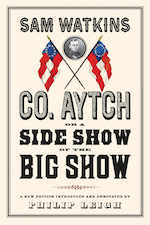 Co. Aytch, or a Side Show of the Big Show: A New Edition Introduced and Annotated by Philip Leigh
Sam Watkins
Westholme Publishing, 2013 “Company H,” the Classic Civil War Memoir in a New Edition, Completely Annotated for the First Time and Illustrated with Twenty-Four Maps
Co. Aytch, or a Side Show of the Big Show is perhaps the finest memoir of an ordinary Confederate soldier. According to Margaret Mitchell, “a better book there never was.” Sam Watkins served in Company H of the First Tennessee Infantry for the duration of the Civil War. Remarkably, he survived some of the most intense battles of the war, including Shiloh, Chickamauga, Kennesaw Mountain, Atlanta, and Franklin. He was one of only seven of the original members of Company H when it surrendered in April 1865. Watkins’s memoir was written in the winter of 1882–83. The humor and depth of writing at times rises to a level resembling Mark Twain; thus, twenty-first-century readers can still discover the everlasting treasures of Private Sam Watkins’s story just as it was. It is this reason that excerpts were featured frequently in Ken Burns’s documentary on the Civil War. However, since most of Sam’s original readers—or some of their family members—actually lived through the Civil War, much of the context for the narrative was common knowledge. But what was once received history has gradually disappeared, and presently only specialists can fully understand and appreciate Sam’s tale.
The chief aim for this new annotated edition of Co. Aytch—the first of its kind—is to amplify the experience for today’s readers by providing the missing context. Over 240 annotations clarify the situational backgrounds, personalities, and terminology that might not be familiar to most readers. The annotations also identify and explain errors mostly resulting from Sam’s occasionally faulty memory or limited perspective. Similarly, twentyfour battlefield and war theater maps enable readers to track Sam’s combat participation as well as his journeys while marching with the army. Finally fifteen photographs and prints illustrate some of the battles, people, towns, buildings, tools of war, and ruins that Sam witnessed. As someone once cleverly observed, “It’s not an adventure until something goes wrong.” If nothing else, Sam’s memoir is a foot soldier’s view of the resulting horrors, heroics, and healing humor when war planning routinely goes awry.
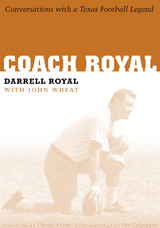 Coach Royal: Conversations with a Texas Football Legend
By Darrell Royal, with John Wheat
University of Texas Press, 2005 Many legendary men have been associated with University of Texas football, but for most fans one man will always be "Coach"—Darrell K Royal. One of the most successful coaches in college football, Royal led the Longhorns to three national championships and eleven Southwest Conference titles during his twenty years (1956-1976) as UT's head coach. He coached some of the Horns' best players, including future Heisman Trophy winner Earl Campbell, and was named NCAA Coach of the Year three times. In 1969, an ABC-TV poll of sportswriters called Royal the Coach of the Decade. In 1996 UT recognized his unrivalled contribution to Longhorn football when it designated Memorial Stadium the Darrell K Royal-Texas Memorial Stadium in his honor. Now, for the first time, Darrell Royal tells his life story in his own words. He remembers growing up poor in Hollis, Oklahoma, during the Great Depression, and describes playing college football for the University of Oklahoma and then coaching a succession of college teams and one pro team before settling in at UT for the rest of his career. He gives a fascinating, behind-the-scenes look at Longhorn football during his time-recruiting strategies, coaching techniques, the famous wishbone offense, unforgettable wins and losses, and his impressions of rival teams and coaches, including Bear Bryant of Texas A&M and Alabama and Frank Broyles of Arkansas. Proving that he's still the same straight shooter as always, Darrell Royal even discusses some of the controversies he's dealt with, including early charges of racism in the UT football program, the impact of Title IX on college athletics, his association with Jim Bob Moffett and the Freeport-MacMoRan Corporation, his longtime friendship with Willie Nelson, and his decision to retire from coaching. But whether he's describing the tough times he's faced professionally and personally or the rewards of being UT's most beloved coach and goodwill ambassador, Royal maintains the same plainspoken honesty and sense of honor that—as much as the winning seasons—have made him a legend to so many people.
 Coaching Copyright
Erin L. Ellis
American Library Association, 2019 From researching to remixing, library users need your guidance on a wide range of copyright topics. The way to move beyond “yes, you can” or “no, you can’t” is to become a copyright coach. In this collection librarian and attorney Smith teams up with information literacy expert Ellis to offer a framework for coaching copyright, empowering users to take a practical approach to specific situations. Complete with in-depth case studies, this collection provides valuable information rooted in pragmatic techniques, including - in-depth discussion of the five questions that will help you clarify any copyright situation;
- storytelling techniques to enliven copyright presentations, plus ways to use music or YouTube to hook students into copyright topics;
- three coaching scenarios that tie into ACRL’s Framework for Information Literacy for Higher Education and bring real-world applications to your library instruction;
- how-to guidance on leading mock negotiations over real journal publishing agreements;
- a 90-minute lesson plan on author rights for writers in a student journal;
- tips for teaching instructional designers how to apply copyright and fair use principles to course management systems; and
- an LIS copyright course assessment model.
This resource will help you become a copyright coach by showing you how to discern the most important issues in a situation, determine which questions you need to ask, and give a response that is targeted to the specific need.
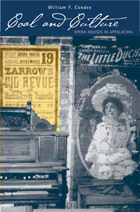 Coal and Culture: Opera Houses in Appalachia
William Faricy Condee
Ohio University Press, 2005 Opera houses were fixtures of Appalachian life from the end of the Civil War through the 1920s. Most towns and cities had at least one opera house during this golden age. Coal mining and railroads brought travelers, money, and change to the region. Many aspects of American life converged in the opera house. Coal and Culture: Opera Houses in Appalachia is a critical appreciation of the opera house in the coal-mining region of Appalachia from the mid-1860s to the early 1930s. Author William Faricy Condee demonstrates that these were multipurpose facilities that were central to the life of their communities. In the era before radio, movies, television, and malls, these buildings were essential. They housed little, if any, opera, but were used for almost everything else, including traveling theater, concerts, religious events, lectures, commencements, boxing matches, benefits, union meetings, and—if the auditorium had a flat floor—skating and basketball. The only book on opera houses that stresses their cultural context, Condee’s unique study will interest cultural geographers, scholars of Appalachian studies, and all those who appreciate the gaudy diversity of the American scene.
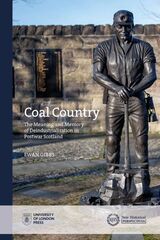 Coal Country: The Meaning and Memory of Deindustrialization in Postwar Scotland
Ewan Gibbs
University of London Press, 2022 The flooding and subsequent closure of Scotland’s last deep coal mine in 2002 was a milestone event in the nation’s deindustrialization. Villages and towns across the densely populated Central Belt of Scotland owe their existence to coal mining’s expansion during the nineteenth century and its maturation in the twentieth. Colliery closures and job losses were not just experienced in economic terms: they also had profound social, cultural, and political implications. Coal Country documents this process of deindustrialization and its effects, drawing on archival records from the UK government, the nationalized coal industry, trade unions, and transcripts from an extensive oral history project. Deindustrialization, we learn, progressed slowly but powerfully across the second half of the twentieth century. Coal Country explains the deep roots of economic changes and their political reverberations, which continue to be felt to this day.
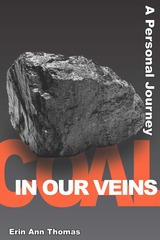 Coal in our Veins: A Personal Journey
Erin Ann Thomas
Utah State University Press, 2012 In Coal in Our Veins, Erin Thomas employs historical research, autobiography, and journalism to intertwine the history of coal, her ancestors' lives mining coal, and the societal and environmental impacts of the United States' dependency on coal as an energy source. In the first part of her book, she visits Wales, native ground of British coal mining and of her emigrant ancestors. The Thomases' move to the coal region of Utah—where they witnessed the Winter Quarters and Castle Gate mine explosions, two of the worst mining disasters in American history—and the history of coal development in Utah form the second part. Then Thomas investigates coal mining and communities in West Virginia, near her East Coast home, looking at the Sago Mine collapse and more widespread impacts of mining, including population displacement, mountain top removal, coal dust dispersal, and stream pollution, flooding, and decimation. The book's final part moves from Washington D.C.—and an examination of coal, CO2, and national energy policy—back to Utah, for a tour of a coal mine, and a consideration of the Crandall Canyon mine cave-in, back to Wales and the closing of the oldest operating deep mine in the world and then to a look at energy alternatives, especially wind power, in West Virginia and Pennsylvania.
The Coal Life: Poems
Adam Vines
University of Arkansas Press, 2012 Miller Williams Arkansas Poetry Prize Finalist
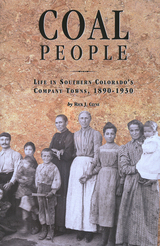 Coal People: Life in Southern Colorado's Company Towns, 1890-1930
Rick J. Clyne
University Press of Colorado, 1999 This study takes a fresh look into the lives of families living in the coal camps of southern Colorado between 1890 and the Great Depression. Historian Rick J. Clyne examines the experiences of the men, women, and children who lived and worked in these isolated, company-dominated towns. With the dangerous nature of mining coal a daily reality, the fear of death and injury was pervasive—not only for the miners venturing into the earth day after day, but for their dependents as well. Clyne reveals that a strong sense of community and tolerance existed in the camps, into which families journeyed from such far-flung locales as eastern and southern Europe to carve out a living. The shared immigrant experience—and the shared risks of mining—more often than not strengthened the bonds between both miners and families. Coal People contains historic images of coal-town life culled from the collections of the Colorado Historical Society, as well as the author's own photographs of how several of these camps appear today.
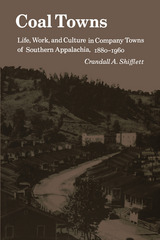 Coal Towns: Life, Work, and Culture in Company Towns of Southern Appalachia, 1880–1960
Crandall A. Shifflett
University of Tennessee Press, 1995 Using oral histories, company records, and census data, Crandall A. Shifflett paints a vivid portrait of miners and their families in southern Appalachian coal towns from the late nineteenth into the mid-twentieth century. He finds that, compared to their earlier lives on subsistence farms, coal-town life was not all bad. Shifflett examines how this view, quite common among the oral histories of these working families, has been obscured by the middle-class biases of government studies and the Edenic myth of preindustrial Appalachia propagated by some historians.
From their own point of view, mining families left behind a life of hard labor and drafty weatherboard homes. With little time for such celebrated arts as tale-telling and quilting, preindustrial mountain people strung more beans than dulcimers. In addition, the rural population was growing, and farmland was becoming scarce. What the families recall about the coal towns contradicts the popular image of mining life. Most miners did not owe their souls to the company store, and most mining companies were not unusually harsh taskmasters. Former miners and their families remember such company benefits as indoor plumbing, regular income, and leisure activities. They also recall the United Mine Workers of America as bringing not only pay raises and health benefits but work stoppages and violent confrontations.
Far from being mere victims of historical forces, miners and their families shaped their own destiny by forging a new working-class culture out of the adaptation of their rural values to the demands of industrial life. This new culture had many continuities with the older one. Out of the closely knit social ties they brought from farming communities, mining families created their own safety net for times of economic downturn. Shifflett recognizes the dangers and hardships of coal-town life but also shows the resilience of Appalachian people in adapting their culture to a new environment.
Crandall A. Shifflett is an associate professor of history at Virginia Polytechnic Institute and State University.
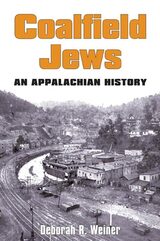 Coalfield Jews: An Appalachian History
Deborah R. Weiner
University of Illinois Press, 2006 The stories of vibrant eastern European Jewish communities in the Appalachian coalfields Coalfield Jews explores the intersection of two simultaneous historic events: central Appalachia’s transformative coal boom (1880s-1920), and the mass migration of eastern European Jews to America. Traveling to southern West Virginia, eastern Kentucky, and southwestern Virginia to investigate the coal boom’s opportunities, some Jewish immigrants found success as retailers and established numerous small but flourishing Jewish communities. Deborah R. Weiner’s Coalfield Jews provides the first extended study of Jews in Appalachia, exploring where they settled, how they made their place within a surprisingly receptive dominant culture, how they competed with coal company stores, interacted with their non-Jewish neighbors, and maintained a strong Jewish identity deep in the heart of the Appalachian mountains. To tell this story, Weiner draws on a wide range of primary sources in social, cultural, religious, labor, economic, and regional history. She also includes moving personal statements, from oral histories as well as archival sources, to create a holistic portrayal of Jewish life that will challenge commonly held views of Appalachia as well as the American Jewish experience.
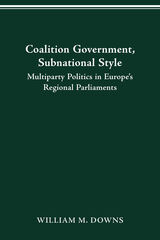 COALITION GOVERNMENT, SUBNATIONAL STYLE: Multiparty Politics in Europe’s Regional Parliaments
William M. Downs
Ohio State University Press, 1998 Coalition Government, Subnational Style examines parliamentary democracy in subnational legislative assemblies. Comparing three different European democracies—Germany, France, and Belgium—William M. Downs provides a powerful account of the ways politicians and political parties negotiate the composition of new governments following elections in which no single party wins a clear majority. Downs argues that postelection alliance building is a window onto many of the political processes fundamental to representative democracy: the interpretations of electoral verdicts; the compromises of campaign pledges; the trade-offs between policy and power; the temporary cooperation between long-term adversaries; the collective decision making; and the blurring of lines of accountability through collective responsibility.
The study reports findings from an unprecedented collection of information, including cross-national survey responses, interviews with political elites, and three decades of postelection studies of coalition building in the German state parliaments, the French regional assemblies, and the Belgian provincial councils and regional parliaments. Coalition Government, Subnational Style conclusively demonstrates that the struggles for government status at subnational levels are profoundly important to both parties and voters and that the outcomes of these struggles can result in governments of varying political complexions. Downs's findings question key assumptions of democratic theory and raise important concerns about individual and organizational behavior in changing institutional and electoral environments, ultimately allowing for a deeper understanding of representation, power, and cooperation outside the more familiar arena of national parliamentary politics.
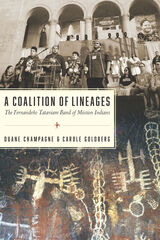 A Coalition of Lineages: The Fernandeño Tataviam Band of Mission Indians
Duane Champagne and Carole Goldberg
University of Arizona Press, 2021 The Fernandeño Tataviam Band of California Mission Indians have lived in Southern California in the area now known as Los Angeles and Ventura Counties from time immemorial. Throughout history, these Indigenous Californians faced major challenges as colonizers moved in to harvest the resources of the California lands. Through meticulous archival research, authors Duane Champagne and Carole Goldberg trace the history of the Fernandeño Tataviam Band from the time before the Spanish arrived in the Americas to the present day.
The history of Southern California’s Indigenous communities is mapped through the story of family and their descendants, or lineages. The authors explain how politically and culturally independent lineages merged and strengthened via marriage, creating complex and enduring coalitions among Indigenous communities. The Indigenous people of Southern California faced waves of colonizers—the Spanish, then the Mexicans, followed by Americans—and their coalitions allowed them to endure to today.
Champagne and Goldberg are leading experts in Native sovereignty policies and histories. They worked in collaboration with members of the Fernandeño Tataviam Band of Mission Indians to illustrate how the community formed and persisted. A Coalition of Lineages is not only the story of a Native Southern California community, it is also a model for multicultural tribal development for recognized and nonrecognized Indian nations in the United States and elsewhere.
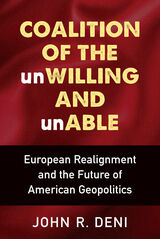 Coalition of the unWilling and unAble: European Realignment and the Future of American Geopolitics
John R. Deni
University of Michigan Press, 2022 Why does the United States need European allies, and why is it getting more difficult for those allies to partner with Washington in standing up to China, pushing back against Russia, and pursuing other common interests around the world? This book addresses the economic, demographic, political, and military trends that are fundamentally upending the ability and willingness of European allies to work with Washington. Brexit and its impact on Britain’s economy and its military, Germany’s seemingly relentless economic and political rise, France’s continuing economic malaise, Italy’s aging population and its withdrawal from major overseas operations, and Poland’s demographic decline and single-minded obsession with Russia will combine to make partnership with Washington nearly impossible. In short, the constellation of allies and partners the United States has relied on since 9/11 will look very different a decade from now. How should Washington respond? It doesn’t hold all the cards, but this book offers an array of practical recommendations for American leaders. By leveraging these proposals, U.S. policy-makers can avoid the worst-case scenarios and make the most of limited opportunities.
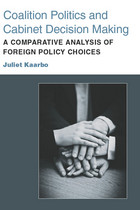 Coalition Politics and Cabinet Decision Making: A Comparative Analysis of Foreign Policy Choices
Juliet Kaarbo
University of Michigan Press, 2013 Every day, coalition cabinets make policy decisions critical to international politics. Juliet Kaarbo examines the dynamics of these multiparty cabinets in parliamentary democracies in order to assess both the quality of coalition decision making and the degree to which coalitions tend to favor peaceful or military solutions. Are coalition cabinets so riddled by conflict that they cannot make foreign policy effectively, or do the multiple voices represented in the cabinet create more legitimate and imaginative responses to the international system? Do political and institutional constraints inherent to coalition cabinets lead to nonaggressive policies? Or do institutional and political forces precipitate more belligerent behavior? Employing theory from security studies and political psychology as well as a combination of quantitative cross-national analyses and twelve qualitative comparative case studies of foreign policy made by coalition cabinets in Japan, the Netherlands, and Turkey, Kaarbo identifies the factors that generate highly aggressive policies, inconsistency, and other policy outcomes. Her findings have implications not merely for foreign policy but for all types of decision making and policy-making by coalition governments.
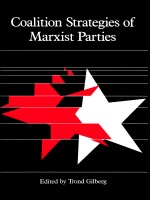 Coalition Strategies of Marxist Parties
Trond Gilberg, ed.
Duke University Press, 1988 During the early part of this decade, many individuals, both policy makers and scholars, wondered about the "new look" of some communist parties as they billed themselves as potential participants in the pluralistic game of politics in many parts of the world. This image was certainly different from the old notion of dedicated revolutionaries who scornfully rejected the existing order and plotted its overflow. How genuine was the new look? Were the communists sincere when they discussed interaction with other elements of political order in which they operated? What were their tactical policies in pursuit of these strategic goals? Some of us began to examine these questions more systematically. We ran a panel at an academic conference, enjoyed the feedback from our colleagues, and began the process of writing this book. Now, several years later, it is a finished product, after many full-scale revisions and updates. The topic is still very relevant, and that shows the enduring importance of the questions asked a number of years ago. Scholars will need to return to this question in the future; perhaps the best strategy is a continuous examination of this crucial subject.
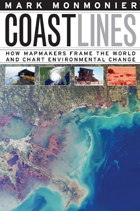 Coast Lines: How Mapmakers Frame the World and Chart Environmental Change
Mark Monmonier
University of Chicago Press, 2008 In the next century, sea levels are predicted to rise at unprecedented rates, causing flooding around the world, from the islands of Malaysia and the canals of Venice to the coasts of Florida and California. These rising water levels pose serious challenges to all aspects of coastal existence—chiefly economic, residential, and environmental—as well as to the cartographic definition and mapping of coasts. It is this facet of coastal life that Mark Monmonier tackles in Coast Lines. Setting sail on a journey across shifting landscapes, cartographic technology, and climate change, Monmonier reveals that coastlines are as much a set of ideas, assumptions, and societal beliefs as they are solid black lines on maps.
Whether for sailing charts or property maps, Monmonier shows, coastlines challenge mapmakers to capture on paper a highly irregular land-water boundary perturbed by tides and storms and complicated by rocks, wrecks, and shoals. Coast Lines is peppered with captivating anecdotes about the frustrating effort to expunge fictitious islands from nautical charts, the tricky measurement of a coastline’s length, and the contentious notions of beachfront property and public access.
Combing maritime history and the history of technology, Coast Lines charts the historical progression from offshore sketches to satellite images and explores the societal impact of coastal cartography on everything from global warming to homeland security. Returning to the form of his celebrated Air Apparent, Monmonier ably renders the topic of coastal cartography accessible to both general readers and historians of science, technology, and maritime studies. In the post-Katrina era, when the map of entire regions can be redrawn by a single natural event, the issues he raises are more important than ever.
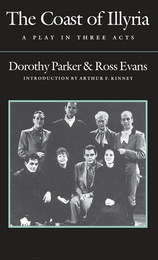 The Coast of Illyria: A Play in Three Acts
Dorothy Parker
University of Iowa Press, 1990 Dorothy Parker is a figure of legendary literary reputation, a fabled member of the Algonquin Round Table, and a highly visible literary personality of the twenties and thirties. Brendan Gill called her "a writer whose robust and acid lucidities were much feared and admired." This play, long forgotten and unpublished until now, will bring new attention to her stirring work. The Coast of Illyria may represent Parker's most mature writing. Based on the story of Charles and Mary Lamb, this play shares the deeply felt theme of abandonment which gives Parker's poetry its haunting quality, along with the rich understanding of despair that characterizes her stories and other plays. Here these issues are explored with a depth, a sensibility, and a subtlety unlike anything else she wrote. As Arthur Kinney describes in his detailed introduction, when Parker and her putative coauthor, Ross Evans, sat through rehearsals revising the script, it was generally felt that Parker saw herself, at least potentially, as the tragic Mary Lamb. "I am Mary Lamb," she told the actress who played the role, "do you see that?"
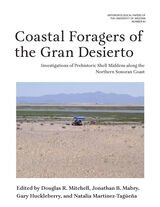 Coastal Foragers of the Gran Desierto: Investigations of Prehistoric Shell Middens along the Northern Sonoran Coast
Douglas R. Mitchell, Jonathan B. Mabry, Gary Huckleberry, and Natalia Martínez-Tagüeña
University of Arizona Press, 2024 The result of nearly twenty years of interdisciplinary research, this volume contributes to the archaeological and paleoenvironmental knowledge of an important but lightly investigated hyperarid coastline at the heart of the Sonoran Desert.
Focused on the coast near Puerto Peñasco, Sonora, Mexico, Coastal Foragers of the Gran Desierto examines the diverse groups occupying the coast for salt, abundant food sources, and shells for ornament manufacturing. The archaeological patterns demonstrated by the data gathered lead to the conclusion that, since ancient times, this coastal landscape was not a marginal zone but rather an important source of food and trade goods, and a pilgrimage destination that influenced broad and diverse communities across the Sonoran Desert and beyond.
Contributors
Jenny L. Adams
Karen R. Adams
Thomas Bowen
Tessa L. Branyan
Bill Broyles
Richard C. Brusca
David L. Dettman
Michael S. Foster
Gary Huckleberry
Jonathan B. Mabry
Natalia Martínez-Tagüeña
Richard J. Martynec
Douglas R. Mitchell
Kirsten Rowell
Melissa R. Schwan
M. Steven Shackley
R. J. Sliva
Kayla B. Worthey
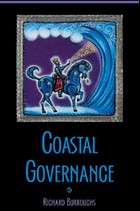 Coastal Governance
Richard Burroughs
Island Press, 2011 Coastal Governance provides a clear overview of how U.S. coasts are currently managed and explores new approaches that could make our shores healthier. Drawing on recent national assessments, Professor Richard Burroughs explains why traditional management techniques have ultimately proved inadequate, leading to polluted waters, declining fisheries, and damaged habitat. He then introduces students to governance frameworks that seek to address these shortcomings by considering natural and human systems holistically.
The book considers the ability of sector-based management, spatial management, and ecosystem-based management to solve critical environmental problems. Evaluating governance successes and failures, Burroughs covers topics including sewage disposal, dredging, wetlands, watersheds, and fisheries. He shows that at times sector-based management, which focuses on separate, individual uses of the coasts, has been implemented effectively. But he also illustrates examples of conflict, such as the incompatibility of waste disposal and fishing in the same waters. Burroughs assesses spatial and ecosystem-based management’s potential to address these conflicts.
The book familiarizes students not only with current management techniques but with the policy process. By focusing on policy development, Coastal Governance prepares readers with the knowledge to participate effectively in a governance system that is constantly evolving. This understanding will be critical as students become managers, policymakers, and citizens who shape the future of the coasts.
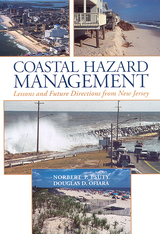 Coastal Hazard Management: Lessons and Future Directions from New Jersey
Psuty, Norbert P.
Rutgers University Press, 2002 As with most shorelines around the world, New Jersey beaches are slowly, but inexorably, being eroded, threatening coastal structures and development. In some years more sand is deposited than removed, but all of the state’s monitoring devices show that sea level is gradually rising and pushing the New Jersey shoreline inland. The shore is a valuable resource, and its natural, cultural, and economic attractions draw a multitude of permanent and temporary residents each year, extending housing and commercial development onto areas that were once swampland. Not surprisingly, development at the water’s edge has been accompanied by an increasing exposure to the natural hazards of the coastal zone--erosion, flooding, and wind damage. In this book, Norbert Psuty and Douglas Ofiara incorporate perspectives from the areas of coastal sciences, economics, public policy, and land-use planning in creating a systematic plan for coastal management and protection. It has been more than a decade since New Jersey developed the nation’s first state shore protection plan, and this volume provides a timely evaluation of its achievements and future challenges. This self-contained book provides all of the relevant theories, models, and examples so the reader will not need to refer to any other literature to gain an understanding of the issues and policies surrounding shore protection. It is the authoritative handbook for practitioners and policy makers in many fields, including coastal science and management and engineering, as well as public policy and economics.
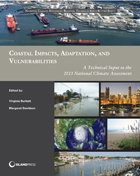 Coastal Impacts, Adaptation, and Vulnerabilities: A Technical Input to the 2013 National Climate Assessment
Virginia Burkett and Margaret Davidson
Island Press, 2013 Developed to inform the 2013 National Climate Assessment, and a landmark study in terms of its breadth and depth of coverage and conducted under the auspices of the U.S. Global Change Research Program, Coastal Impacts, Adaptation, and Vulnerabilities examines the known effects and relationships of climate change variables on the coasts of the U.S.
This state of the art assessment comes from a broad range of experts in academia, private industry, state and local governments, NGOs, professional societies, and impacted communities. It includes case studies on topics such as adaptive capacity; climate change effects on. It highlights past climate trends, projected climate change and vulnerabilities, and impacts to specific sectors.
Rich in science and case studies, it examines the latest climate change impacts, scenarios, vulnerabilities, and adaptive capacity for nine major coastal regions of the United States and provides essential guidance for decision-makers – as well as environmental academics, professionals, and advocates – who seek to better understand how climate variability and change impact the US coasts and its communities.
 Coastal Landscapes: South Jersey from the Air
Kenneth W. Able
Rutgers University Press, 2023 New Jersey has roughly one hundred and thirty miles of coastline, including a wide array of habitats from marshes to ocean beaches, each hosting a unique ecosystem. Yet these coastal landscapes are quite dynamic, changing rapidly as a result of commercial development, environmental protection movements, and of course climate change. Now more than ever, it is vital to document these landscapes before they disappear.
Based on numerous aerial images from helicopter and drone flights between 2015 and 2021, this book provides extensive photographs and maps of the New Jersey coast, from the Pine Barrens to the ocean beaches. The text associated with each exceptional image describes it in detail, including its location, ecological setting, and relative position within the larger landscape. Author Kenneth Able, director of the Rutgers University Marine Field Station for over thirty years, has thoroughly ground-truthed each image by observations made through kayaks, boats, and wading through marshes. Calling upon his decades of expertise, Able paints a compelling portrait of coastal New Jersey’s stunning natural features, resources, history, and possible futures in an era of rising sea levels.
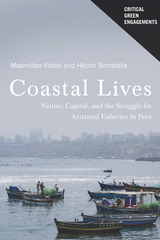 Coastal Lives: Nature, Capital, and the Struggle for Artisanal Fisheries in Peru
Maximilian Viatori and Héctor Bombiella
University of Arizona Press, 2019 Peru’s fisheries are in crisis as overfishing and ecological changes produce dramatic fluctuations in fish stocks. To address this crisis, government officials have claimed that fishers need to become responsible producers who create economic advantages by taking better care of the ocean ecologies they exploit.
In Coastal Lives, Maximilian Viatori and Héctor Bombiella argue that this has not made Peru’s fisheries more sustainable. Through a fine-grained ethnographic and historical account of Lima’s fisheries, the authors reveal that new government regimes of entrepreneurial agency have placed overwhelming burdens on the city’s impoverished artisanal fishers to demonstrate that they are responsible producers and have created failures that can be used to justify closing these fishers’ traditional use areas and to deny their historically sanctioned rights. The result is a critical examination of how neoliberalized visions of nature and individual responsibility work to normalize the dispossessions that have enabled ongoing capital accumulation at the cost of growing social dislocations and ecological degradation.
The authors’ innovative approach to the politics of constructing and degrading coastal lives will interest a wide range of scholars in cultural anthropology, environmental humanities, and Latin American studies, as well as policymakers and anyone concerned with inequality, global food systems, and multispecies ecologies.
 Coastal Marshes: Ecology and Wildlife Management
Robert H. Chabreck
University of Minnesota Press, 1988 Coastal Marshes was first published in 1988. Minnesota Archive Editions uses digital technology to make long-unavailable books once again accessible, and are published unaltered from the original University of Minnesota Press editions. The coastal regions of the United States form a highly diversified environment. In addition to sandy beaches and rocky shorelines, there are lagoons, rivers, estuaries, and marshes. The last are a dominant features of many coastal areas and serve as a transition between sea and uplands. Coastal marshes have been a zone for human development, attractive to industrial and residential building because they provide water frontage. But the public is becoming aware of the great value of these wetlands to fisheries and wildlife and to the local economy that depends on them. This book describes coastal marshes in terms of form, function, ecology, wildlife value, and management. Robert H. Chabreck's emphasis is on the marshes of the northern coast of the Gulf of Mexico (there are 5,500 square miles of marshland in Louisiana alone), but he also deals with marshes on the Atlantic and Pacific coasts. Plant and animal communities are each given a chapter, and the book concludes with considerations of future uses and needs. The author provides references, a glossary, and a list of scientific names, along with numerous illustrations, including a section of color photographs. For thirty years, Robert H. Chabreck has been engaged in research and management of coastal marshes and has often served as a consultant in wetland ecology. He is a professor of wildlife at Louisiana State University.
 Coastal Metropolis: Environmental Histories of Modern New York City
Carl A. Zimring and Steven H. Corey
University of Pittsburgh Press, 2020 Built on an estuary, New York City is rich in population and economic activity but poor in available land to manage the needs of a modern city. Since consolidation of the five boroughs in 1898, New York has faced innumerable challenges, from complex water and waste management issues, to housing and feeding millions of residents in a concentrated area, to dealing with climate change in the wake of Superstorm Sandy, and everything in between. Any consideration of sustainable urbanism requires understanding how cities have developed the systems that support modern life and the challenges posed by such a concentrated population. As the largest city in the United States, New York City is an excellent site to investigate these concerns. Featuring an array of the most distinguished and innovative urban environmental historians in the field, Coastal Metropolis offers new insight into how the modern city transformed its air, land, and water as it grew.
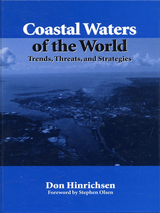 Coastal Waters of the World: Trends, Threats, and Strategies
Don Hinrichsen; Foreword by Stephen Olsen
Island Press, 1998 Nearly 60% of the world's population lives and works within 100 miles of a coast, and even those who don't are connected to the world's oceans through an intricate drainage of rivers and streams. Ultimately the whole of humankind is coastal. Coastal Waters of the World is a comprehensive reference source on the state of the world's coastal areas. It focuses on the tremendous pressures facing coastal areas and the management systems and strategies needed to cope with them. Don Hinrichsen explores the origins and implications of three related issues: the overwhelming threats to our coastal resources and seas from population and pollution; the destruction of critical resources through unsustainable economic activity; and the inability of governments to craft and implement rational coastal management plans. Introductory chapters present a concise summary of our coastal problems, including coastal habitat degradation and the fisheries crisis, along with a discussion of better management options. Three case studies of successful coastal governance focus on some of the problems and bring to life potential solutions. Following that are regional profiles that provide detailed information on the main population, resource, and management challenges facing each of the world's thirteen major coastal waters and seas. The profiles are presented in a standard format to allow for ease of comparison between regions, and accessibility of information. The book ends with a realistic and practical agenda for action that can be implemented immediately. Safeguarding these complex, interlinked ecosystems is humanity's most challenging management job. Coastal Waters of the World will help raise our awareness of coastal area concerns and provide a constructive contribution to the ongoing debate over how to manage these ever-changing areas, both for ourselves and for future generations. It will serve as a valuable reference tool and an up-to-date resource for policymakers, management specialists, and students interested in sustainable coastal governance.
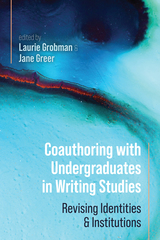 Coauthoring with Undergraduates in Writing Studies: Revising Identities and Institutions
Laurie Grobman
Utah State University Press, 2025 Coauthoring with Undergraduates in Writing Studies focuses on the largely unnoticed and unexplored tradition of faculty/undergraduate publication in writing studies. Coauthoring makes new authorial identities and relationships available to both faculty and students and demonstrates promise as a way to increase access to meaningful research experiences for undergraduates from communities that have been historically underserved in higher education, creating more inclusive learning environments.
In this book, faculty and undergraduates describe and theorize about their coauthoring experiences within a variety of institutional contexts including land-grant universities, Historically Black Colleges and Universities, Hispanic-Serving Institutions, religiously affiliated research universities, and regional campuses of statewide higher education systems. They explore the relationships between undergraduates and faculty that lead to coauthoring opportunities in a range of courses—first-year writing classes, general educational requirements in various disciplines, and upper-level offerings for English majors—as well as in other institutional spaces such as writing centers, community engagement initiatives, and assessment offices. The collection offers faculty and undergraduates models, ideas, and strategies for how to coauthor together while also preparing them for the challenges—pragmatic, intellectual, and ethical—that they may encounter.
Coauthoring with Undergraduates in Writing Studies showcases why and how coauthorship between faculty and undergraduates is a vital site for scholarly engagement, professional development, and socially just education. It boldly enacts rhetoric and composition’s commitment to collaborative scholarship and is significant for graduate students and faculty in rhetoric and writing studies, especially in community-engaged writing, undergraduate education, collaborative writing, and mentorship, as well as those interested in WAC, WID, and the scholarship of teaching and learning.
Coaxial Electrical Circuits for Interference-Free Measurements
Shakil Awan
The Institution of Engineering and Technology, 2011 The authors have between them more than 60 years of experience in making electrical measurements in National Measurement Laboratories. These laboratories are the source of measurement standards and techniques for science and engineering and are dedicated to maintaining the international system of units (SI) by establishing and disseminating the values of measurement standards with the lowest possible uncertainty. Careful attention to detail is required in designing measurement systems that eliminate electrical interference and are as simple and as close to first principles as possible. This book draws on their experience by offering guidance and best practice for designing sensitive electrical measurement circuits.
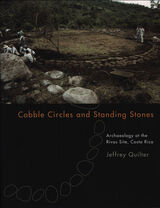 Cobble Circles and Standing Stones: Archaeology at the Rivas Site, Costa Rica
Jeffrey Quilter
University of Iowa Press, 2004 In this first-person tale of archaeological adventure in the tropical forest, Jeffrey Quilter tells the story of his excavation of Rivas, a great ceremonial center at the foot of the Talamanca Mountain range, which flourished between A.D. 900 and 1300, and its fabled gold-filled cemetery, the Panteón de La Reina. Beginning with the 1992 field season and ending with the last excavations in 1998, Quilter discusses Rivas’ builders and users, theories on chiefdom societies, and the daily interactions and surprises of modern archaeological fieldwork.
Writing in the first person with a balance between informal language and academic theory, Quilter concludes that Rivas was a ceremonial center for mortuary rituals to bury chiefly elite on the Panteón. Through use of his narrative technique, he provides the reader with accounts of discoveries as they occurred in fieldwork and the development of interpretations to explain the ancient refuse and cobble architecture his team uncovered. As his story progresses amid the enchantment of the Costa Rican landscape, research plans are adjusted and sometimes completely overturned as new discoveries, often serendipitous ones, are made. Such changing circumstances lead to new insights into the rise and fall of the people who built the cobble circles and raised the standing stones at Rivas, a thousand years ago.
The only book in English that focuses on a single archaeological site in Costa Rica, which continues to develop as a destination for archaeological tourism, Cobble Stones and Standing Circles will appeal to laypeople and professionals alike.
Coca Prohibition in Peru: The Historical Debates
Joseph A. Gagliano
University of Arizona Press, 1994 The first book to provide a historical overview of coca. In tracing the arguments of the participants in the coca debates during the last four centuries, it surveys the role of the leaf in Peru's sociopolitical history, focusing on coca usage as a source of controversy for the policy makers among the coastal elites who have dominated Peruvian politics and economics since the Spanish conquest.
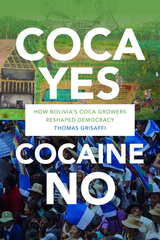 Coca Yes, Cocaine No: How Bolivia's Coca Growers Reshaped Democracy
Thomas Grisaffi
Duke University Press, 2019 In Coca Yes, Cocaine No Thomas Grisaffi traces the political ascent and transformation of the Movement toward Socialism (MAS) from an agricultural union of coca growers into Bolivia's ruling party. When Evo Morales—leader of the MAS—became Bolivia's president in 2006, coca growers celebrated his election and the possibility of scaling up their form of grassroots democracy to the national level. Drawing on a decade of ethnographic fieldwork with coca union leaders, peasant farmers, drug traffickers, and politicians, Grisaffi outlines the tension that Morales faced between the realities of international politics and his constituents, who, even if their coca is grown for ritual or medicinal purposes, are implicated in the cocaine trade and criminalized under the U.S.-led drug war. Grisaffi shows how Morales's failure to meet his constituents' demands demonstrates that the full realization of alternative democratic models at the local or national level is constrained or enabled by global political and economic circumstances.
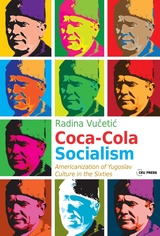 Coca-Cola Socialism: Americanization of Yugoslav Culture in the Sixties
Radina Vucetic
Central European University Press, 2018 This book is about the Americanization of Yugoslav culture and everyday life during the nineteen-sixties. After falling out with the Eastern bloc, Tito turned to the United States for support and inspiration. In the political sphere the distance between the two countries was carefully maintained, yet in the realms of culture and consumption the Yugoslav regime was definitely much more receptive to the American model. For Titoist Yugoslavia this tactic turned out to be beneficial, stabilising the regime internally and providing an image of openness in foreign policy.
Coca-Cola Socialism addresses the link between cultural diplomacy, culture, consumer society and politics. Its main argument is that both culture and everyday life modelled on the American way were a major source of legitimacy for the Yugoslav Communist Party, and a powerful weapon for both USA and Yugoslavia in the Cold War battle for hearts and minds.
Radina Vučetić explores how the Party used American culture in order to promote its own values and what life in this socialist and capitalist hybrid system looked like for ordinary people who lived in a country with communist ideology in a capitalist wrapping. Her book offers a careful reevaluation of the limits of appropriating the American dream and questions both an uncritical celebration of Yugoslavia’s openness and an exaggerated depiction of its authoritarianism.
 Cocaine Addiction: Theory, Research and Treatment
Jerome J. Platt
Harvard University Press, 1997 It inspired written testimonials from William McKinley, Thomas Edison, and Sarah Bernhardt; merited a medal from Pope Leo XIII; produced "exhilaration and lasting euphoria" in Sigmund Freud. Once the stimulant of choice of the enlightened and the elite, cocaine has become, a century later, a plague, ravaging the lives of millions. This book is the first to draw together all the facts about this pervasive drug--from its natural occurrence in a tea-like native South American plant to its devastating appearance as crack in the inner cities of the United States.
Drawing on the latest work in medicine, psychiatry, neuroscience, pharmacology, epidemiology, social work, and sociology, the volume is a highly accessible reference on the history and use of cocaine, its physical and psychological effects, and the etiology and epidemiology of cocaine addiction. It also provides a critical evaluation of the pharmaceutical agents and psychosocial interventions that have been used to treat this addiction. Author Jerome J. Platt answers such basic questions as: What is cocaine? What forms does it come in? How is it administered? What does it do? What are the medical complications of cocaine addiction? What are the treatments, and how successful are they?
Uniquely comprehensive, Cocaine Addiction makes all the latest information on this urgent subject readily available to medical professionals and practitioners, social workers and scholars, and anyone who cares to know more about this perennially troubling drug.
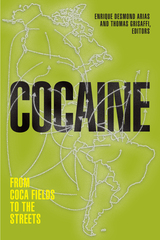 Cocaine: From Coca Fields to the Streets
Enrique Desmond Arias and Thomas Grisaffi, editors
Duke University Press, 2021 The contributors to Cocaine analyze the contemporary production, transit, and consumption of cocaine throughout the Americas and the illicit economy's entanglement with local communities. Based on in-depth interviews and archival research, these essays examine how government agents, acting both within and outside the law, and criminal actors seek to manage the flow of illicit drugs to both maintain order and earn profits. Whether discussing the moral economy of coca cultivation in Bolivia, criminal organizations and drug traffickers in Mexico, or the routes cocaine takes as it travels into and through Guatemala, the contributors demonstrate how entire ways of life are built around cocaine commodification. They consider how the authority of state actors is coupled with the self-regulating practices of drug producers, traffickers, and dealers, complicating notions of governance and of the relationships between economic and moral economies. The collection also outlines a more progressive drug policy that acknowledges the important role drugs play in the lives of those at the urban and rural margins.
Contributors. Enrique Desmond Arias, Lilian Bobea, Philippe Bourgois, Anthony W. Fontes, Robert Gay, Paul Gootenberg, Romain Le Cour Grandmaison, Thomas Grisaffi, Laurie Kain Hart, Annette Idler, George Karandinos, Fernando Montero, Dennis Rodgers, Taniele Rui, Cyrus Veeser, Autumn Zellers-León
The Cocaine Salesman
Conny Braam
Haus Publishing Lucien Hirschland, travelling salesman for the flourishing Nederlandsche Cocaine Fabriek, brings in a big order from an English pharmaceutical company. Soon after this he closes a deal with a buyer for the German army. Cocaine and war, love and vengeance, The Cocaine Salesman is an unparalleled novel based on historical events.
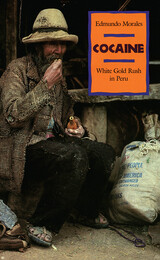 Cocaine: White Gold Rush in Peru
Edmundo Morales
University of Arizona Press, 1989 Cocaine: Much is known about the damage done by this drug in the United States; yet how much is actually known of its impact at its source? Though most processed cocaine comes from Colombia, more than half of the coca paste from which the drug is made originates in the vast jungle slopes shared by Bolivia and Peru. People here have chewed coca leaves for centuries, but only over the last twenty years has coca become a major cash crop. Now it supports local economies, feeds inflation, and affects the social behavior of Peruvians. Edmundo Morales, a Peruvian who is now a drug researcher in the United States, has conducted an extensive study of this underground economy to show how cocaine has changed the social, cultural, economic, and political climate of Peru--and why government efforts are unable to stop it. With statistics on coca agriculture, a description of coca-paste manufacturing, and an examination of the industry's social structure, Morales's book is an inside look at the "white gold rush" that only a Peruvian could have written. It offers a new perspective for understanding a problem that is usually seen only as it affects our own society, and it proposes a new look at policies directed toward its control.
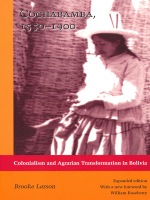 Cochabamba, 1550-1900: Colonialism and Agrarian Transformation in Bolivia
Brooke Larson
Duke University Press, 1998 Winner of the 1990 Best Book Award from the New England Council on Latin American Studies This study of Bolivia uses Cochabamba as a laboratory to examine the long-term transformation of native Andean society into a vibrant Quechua-Spanish-mestizo region of haciendas and smallholdings, towns and villages, peasant markets and migratory networks caught in the web of Spanish imperial politics and economics. Combining economic, social, and ethnohistory, Brooke Larson shows how the contradictions of class and colonialism eventually gave rise to new peasant, artisan, and laboring groups that challenged the evolving structures of colonial domination. Originally published in 1988, this expanded edition includes a new final chapter that explores the book’s implications for understanding the formation of a distinctive peasant political culture in the Cochabamba valleys over the eighteenth and nineteenth centuries.
The Cochise Cultural Sequence in Southeastern Arizona
E. B. Sayles
University of Arizona Press, 1983 The Anthropological Papers of the University of Arizona is a peer-reviewed monograph series sponsored by the School of Anthropology. Established in 1959, the series publishes archaeological and ethnographic papers that use contemporary method and theory to investigate problems of anthropological importance in the southwestern United States, Mexico, and related areas.
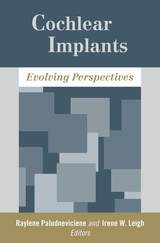 Cochlear Implants: Evolving Perspectives
Raylene Paludneviciene
Gallaudet University Press, 2011 The cochlear implant debate has changed, as evidenced in this cogent collection that presents 13 chapters by 20 experts, including several who communicate through sign language but also utilize cochlear implants. The impetus for this change stems from recognition that both visual and aural input can enhance the education of deaf children. Divided into four sections, Cochlear Implants: Evolving Perspectives first focuses on the impact of implants in the Deaf community. Chapters in this section examine the issues driving the cochlear implant debate, the ethics of genetic engineering, experiences of implanted adult deaf signers, reflections of deaf mothers who have had their children implanted, and the effects of implants on deaf identity. The second section delves into the mechanics of bimodal processing, including listening strategies that can benefit signing children with cochlear implants. The third section surveys combined aural/visual educational approaches, such as teaching implanted children in an ASL/English bilingual classroom, and applying auditory rehabilitation to a signed communication context. The final section challenges readers to reframe the debate first by exploring sensory politics, then by envisioning an emerging world that requires the Deaf community to connect with it to secure its future. With this information, readers will reach their own conclusions about cochlear implants and auditory and visual approaches to the mastery of both spoken and signed languages.
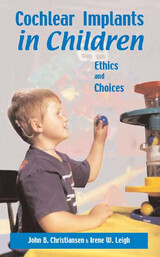 Cochlear Implants in Children: Ethics and Choices
John B. Christiansen
Gallaudet University Press, 2002 Cochlear Implants in Children: Ethics and Choices addresses every facet of the ongoing controversy about implanting cochlear hearing devices in children as young as 12 months old and in some cases, younger. Authors John B. Christiansen and Irene W. Leigh and contributors Jay Lucker and Patricia Elizabeth Spencer analyzed the sensitive issues connected with the procedure by reviewing 439 responses to a survey of parents with children who have cochlear implants. They followed up with interviews of the parents of children who have had a year's experience using their implants, and also the children themselves. Their findings shape the core of this useful and telling study. Cochlear Implants begins with a history of their development and an explanation of how implants convert sound into electric impulses that stimulate the brain. The second section focuses on pediatric implants, starting with the ways parents coped with the discovery that their child was deaf. Parents share how they learned about cochlear implants and how they chose an implant center. They also detail their children's experiences with the implants after surgery, and their progress with language acquisition and in school. The final part treats the controversy associated with cochlear implants, particularly the reaction of the Deaf community and the ethics of implanting young children without their consent. Cochlear Implants concludes with sage observations and recommendations for parents and professionals that complete it as the essential book on the pros and cons of this burgeoning technology.
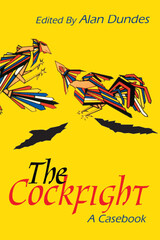 The Cockfight: A Casebook
Edited by Alan Dundes
University of Wisconsin Press, 1994 Originating more than 2500 years ago, cockfighting is one of the oldest documented sports in the world. It has continued to flourish despite bans against it in many countries. In The Cockfight: A Casebook, folklorist Alan Dundes brings together a diverse array of writing on this male-dominated ritual.
Vivid descriptions of cockfights from Puerto Rico, Tahiti, Ireland, Spain, Brazil, and the Philippines complement critical commentaries, from the fourth-century reflections of St. Augustine to contemporary anthropological and psychoanalytic interpretations. The various essays discuss the intricate rules of the cockfight, the ethical question of pitting two equally matched roosters in a fight to the death, the emotional involvement of cockfighters and fans, and the sexual implications of the sport. The result is an enlightening collection for anthropologists, folklorists, sociologists, and psychologists, as well as followers of this ancient blood sport.
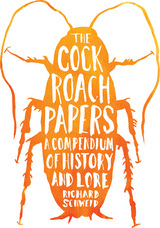 The Cockroach Papers: A Compendium of History and Lore
Richard Schweid
University of Chicago Press, 2015 Skittering figures of urban legend—and a ubiquitous reality—cockroaches are nearly as abhorred as they are ancient. Even as our efforts to exterminate them have developed into ever more complex forms of chemical warfare, roaches’ basic design of six legs, two hypersensitive antennae, and one set of voracious mandibles has persisted unchanged for millions of years. But as Richard Schweid shows in The Cockroach Papers, while some species of these evolutionary superstars do indeed plague our kitchens and restaurants, exacerbate our asthma, and carry disease, our belief in their total villainy is ultimately misplaced.
Traveling from New York City to Louisiana, Mexico, Nicaragua, and Morocco, Schweid blends stories of his own squirm-inducing roach encounters with meticulous research to spin a tale both humorous and harrowing. As he investigates roaches’ more nefarious interactions with our species—particularly with those of us living at the margins of society—Schweid also explores their astonishing diversity, how they mate, what they’ll eat, and what we’ve written about them (from Kafka and Nelson Algren to archy and mehitabel). Knowledge soon turns into respect, and Schweid looks beyond his own fears to arrive at an uncomfortable truth: We humans are no more peaceful, tidy, or responsible about taking care of the Earth or each other than these tiny creatures that swarm in the dark corners of our minds, homes, and cereal boxes.
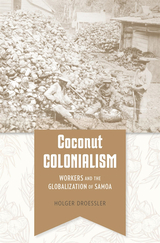 Coconut Colonialism: Workers and the Globalization of Samoa
Holger Droessler
Harvard University Press, 2022 A new history of globalization and empire at the crossroads of the Pacific.
Located halfway between Hawai‘i and Australia, the islands of Samoa have long been a center of Oceanian cultural and economic exchange. Accustomed to exercising agency in trade and diplomacy, Samoans found themselves enmeshed in a new form of globalization after missionaries and traders arrived in the middle of the nineteenth century. As the great powers of Europe and America competed to bring Samoa into their orbits, Germany and the United States eventually agreed to divide the islands for their burgeoning colonial holdings.
In Coconut Colonialism, Holger Droessler examines the Samoan response through the lives of its workers. Ordinary Samoans—some on large plantations, others on their own small holdings—picked and processed coconuts and cocoa, tapped rubber trees, and built roads and ports that brought cash crops to Europe and North America. At the same time, Samoans redefined their own way of being in the world—what Droessler terms “Oceanian globality”—to challenge German and American visions of a global economy that in fact served only the needs of Western capitalism. Through cooperative farming, Samoans contested the exploitative wage-labor system introduced by colonial powers. The islanders also participated in ethnographic shows around the world, turning them into diplomatic missions and making friends with fellow colonized peoples. Samoans thereby found ways to press their own agendas and regain a degree of independence. Based on research in multiple languages and countries, Coconut Colonialism offers new insights into the global history of labor and empire at the dawn of the twentieth century.
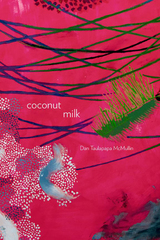 Coconut Milk
Dan Taulapapa McMullin
University of Arizona Press, 2013 Coconut Milk is a fresh, new poetry collection that is a sensual homage to place, people, love, and lust. The first collection by Samoan writer and painter Dan Taulapapa McMullin, the poems evoke both intimate conversations and provocative monologues that allow him to explore the complexities of being a queer Samoan in the United States.
McMullin seamlessly flows between exposing the ironies of Tiki kitsch–inspired cultural appropriation and intimate snapshots of Samoan people and place. In doing so, he disrupts popular notions of a beautiful Polynesia available for the taking, and carves out new avenues of meaning for Pacific Islanders of Oceania. Throughout the collection, McMullin illustrates various manifestations of geopolitical, cultural, linguistic, and sexual colonialism. His work illuminates the ongoing resistance to colonialism and the remarkable resilience of Pacific Islanders and queer-identified peoples.
McMullin’s Fa’a Fafine identity—the ability to walk between and embody both the masculine and feminine—creates a grounded and dynamic voice throughout the collection. It also fosters a creative dialogue between Fa’a Fafine people and trans-Indigenous movements. Through a uniquely Samoan practice of storytelling, McMullin contributes to the growing and vibrant body of queer Indigenous literature.
Cocopa Ethnography
William H. Kelly
University of Arizona Press, 1977 The Anthropological Papers of the University of Arizona is a peer-reviewed monograph series sponsored by the School of Anthropology. Established in 1959, the series publishes archaeological and ethnographic papers that use contemporary method and theory to investigate problems of anthropological importance in the southwestern United States, Mexico, and related areas.
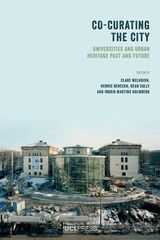 Co-Curating the City: Universities and Urban Heritage Past and Future
Edited by Clare Melhuish, Henric Benesch, Dean Sully, and Ingrid Martins Holmberg
University College London, 2022 A significant contribution to knowledge about university spatial development in urban contexts.
Co-Curating the City explores the role of universities in the construction and mobilization of heritage discourses in urban development and regeneration processes, with a focus on six case study sites ranging from Sweden to Brazil. The book expands the field of critical heritage studies in the urban domain, arguing that universities should position themselves as significant institutions in the development of urban heritage narratives and heavily influence urban development. The case studies investigate how universities, as mixed communities of interest dispersed across buildings and urban sites, utilize strategies of engagement with local people and neighborhoods and ask how this could contribute to a reshaping of ideas, narratives, and lived experience of urban heritage in which universities have a distinctive agency.
Coda
Steven Seidenberg
Omnidawn, 2025 Experimental lyric and narrative poetry that brings together philosophy, theology, and humor.
The nameless narrator of Coda attempts to trace the origins of linguistic and perceptual differentiation by experimenting with contemporary lyric and narrative forms. Moving between extravagant prosody and obsessive disquisition, Seidenberg’s poetry works to reconfigure conceptual imperatives found throughout philosophy and theology. With a focus on the structure of memory and the decadence of the body, Seidenberg describes the epistemological regress of desire, intention, knowledge, and discernment.
Seidenberg brings together the language and concerns of figures including Spinoza, Kant, Hegel, and Wittgenstein, alongside elements of raucous humor drawn from the tradition of Rabelais, Beckett, Lispector, and Sterne.
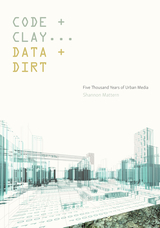 Code and Clay, Data and Dirt: Five Thousand Years of Urban Media
Shannon Mattern
University of Minnesota Press, 2017 For years, pundits have trumpeted the earthshattering changes that big data and smart networks will soon bring to our cities. But what if cities have long been built for intelligence, maybe for millennia? In Code and Clay, Data and Dirt Shannon Mattern advances the provocative argument that our urban spaces have been “smart” and mediated for thousands of years. Offering powerful new ways of thinking about our cities, Code and Clay, Data and Dirt goes far beyond the standard historical concepts of origins, development, revolutions, and the accomplishments of an elite few. Mattern shows that in their architecture, laws, street layouts, and civic knowledge—and through technologies including the telephone, telegraph, radio, printing, writing, and even the human voice—cities have long negotiated a rich exchange between analog and digital, code and clay, data and dirt, ether and ore. Mattern’s vivid prose takes readers through a historically and geographically broad range of stories, scenes, and locations, synthesizing a new narrative for our urban spaces. Taking media archaeology to the city’s streets, Code and Clay, Data and Dirt reveals new ways to write our urban, media, and cultural histories.
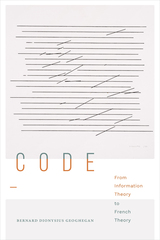 Code: From Information Theory to French Theory
Bernard Dionysius Geoghegan
Duke University Press, 2022 In Code Bernard Dionysius Geoghegan reconstructs how Progressive Era technocracy as well as crises of industrial democracy and colonialism shaped early accounts of cybernetics and digital media by theorists including Norbert Wiener, Warren Weaver, Margaret Mead, Gregory Bateson, Claude Lévi-Strauss, Roman Jakobson, Jacques Lacan, Roland Barthes, and Luce Irigaray. His analysis casts light on how media-practical research forged common epistemic cause in programs that stretched from 1930s interwar computing at MIT and eugenics to the proliferation of seminars and laboratories in 1960s Paris. This mobilization ushered forth new fields of study such as structural anthropology, family therapy, and literary semiology while forming enduring intellectual affinities between the humanities and informatics. With Code, Geoghegan offers a new history of French theory and the digital humanities as transcontinental and political endeavors linking interwar colonial ethnography in Dutch Bali to French sciences in the throes of Cold War-era decolonization and modernization.
 Code Name Puritan: Norman Holmes Pearson at the Nexus of Poetry, Espionage, and American Power
Greg Barnhisel
University of Chicago Press, 2024 An insightful biography of an unassuming literary scholar—and spy—who transformed postwar American culture.
Although his impact on twentieth-century American cultural life was profound, few people know the story of Norman Holmes Pearson. Pearson’s life embodied the Cold War alliances among US artists, scholars, and the national-security state that coalesced after World War II. As a Yale professor and editor, he helped legitimize the study of American culture and shaped the public’s understanding of literary modernism—significantly, the work of women poets such as Hilda Doolittle and Gertrude Stein. At the same time, as a spy, recruiter, and cultural diplomat, he connected the academy, the State Department, and even the CIA.
In Code Name Puritan, Greg Barnhisel maps Pearson’s life, from his childhood injury that led to a visible, permanent disability to his wartime counterespionage work neutralizing the Nazis’ spy network to his powerful role in the cultural and political heyday sometimes called the American Century. Written with clarity and informed by meticulous research, Barnhisel’s revelatory portrait of Pearson details how his unique experiences shaped his beliefs about the American character, from the Puritans onward.
 The Code of Codes: Scientific and Social Issues in the Human Genome Project
Daniel Kevles
Harvard University Press, 1992 The human genome is the key to what makes us human. Composed of the many different genes found in our cells, it defines our possibilities and limitations as members of the species. The ultimate goal of the pioneering project outlined in this book is to map our genome in detail—an achievement that will revolutionize our understanding of human development and the expression of both our normal traits and our abnormal characteristics, such as disease. The Code of Codes is a collective exploration of the substance and possible consequences of this project in relation to ethics, law, and society as well as to science, technology, and medicine.
The many debates on the Human Genome Project are prompted in part by its extraordinary cost, which has raised questions about whether it represents the invasion of biology by the kind of Big Science symbolized by high-energy accelerators. While addressing these matters, this book recognizes that far more than money is at stake. Its intent is not to advance naive paeans for the project but to stimulate thought about the serious issues—scientific, social, and ethical—that it provokes. The Code of Codes comprises incisive essays by stellar figures in a variety of fields, including James D. Watson and Walter Gilbert and the social analysts of science Dorothy Nelkin and Evelyn Fox Keller. An authoritative review of the scientific underpinnings of the project is provided by Horace Freeland Judson, author of the bestselling Eighth Day of Creation.
The book’s broad and balanced coverage and the expertise of its contributors make The Code of Codes the most comprehensive and compelling exploration available on this history-making project.
 Code of Peace: Ethics and Security in the World of the Warlord States
Dorothy V. Jones
University of Chicago Press, 1991 Is it possible, in our world of differing beliefs and diverse cultures, to find an ethical framework that can guide actual international relations? In Code of Peace, Dorothy V. Jones sets forth her surprising answer to this perplexing question: Not only is a consensus on ethical principles possible, but it has already been achieved.
Jones focuses on the progressive development of international law to disclose an underlying code of ethics that enjoys broad support in the world community. Unlike studies that concentrate on what others think that states ought to do, Code of Peace analyzes what states themselves consider proper behavior. Using history as both narrative and argument, Jones shows how the existing ethical code has evolved cumulatively since World War I from a complex interplay between theory and practice. More than an abstract treatise or a merely technical analysis, Jones's study is grounded in the circumstances of war and peace in this century. Treaties and agreements, she argues, are forging a consensus on such principles as human rights, self-determination, and cooperation between states. Jones shows how leaders and representatives of nations, drawing on a rich heritage of philosophical thoughts as well as on their own experiences in a violent world of self-interested conflict, have shaped their thought to the taming of that world in the cause of peace. That is the striking thing about this code: states whose relations are marked by so frequent a recourse to war that they can fairly be called "warlords" have created and pledged themselves to a code of peace.
The implications of Code of Peace for establishing a normative foundation for peace are profound. Historically sound and timely, impeccably researched and elegantly written, the book will be of immediate and lasting value to anyone concerned with the stability of the modern world.
Code of Practice: Competence for Safety Related Systems Practitioners
The Institution of Engineering and Technology
The Institution of Engineering and Technology, 2017 This Code of Practice is designed to help companies assess and maintain the competence of their engineering staff particularly in safety critical areas and industries. It sets out the competencies expected and evidence required to prove competence in specific tasks and helps organisations create schemes for monitoring and measuring the competencies of its employees. Human error is still recognised as the most frequent cause of problems and the field of safety critical systems and functional safety continues to develop along with the complexity of systems.
Code of Practice for Building Automation and Control Systems
The Institution of Engineering and Technology
The Institution of Engineering and Technology, 2020 Within the modern built environment, advanced engineering systems allow us to go about our daily lives in a relative degree of safety, comfort and security. Often, we do not give too much thought about what is happening behind the scenes.
Code of Practice for Connected Systems Integration in Buildings
IET Standards TC4.1 Connected Systems Integration
The Institution of Engineering and Technology, 2016 The Code of Practice for Connected Systems Integration in Buildings aims to promote good practice in the specification, design and integration of connected systems in buildings, as well as providing a reference to practitioners on design, integration practice and technological considerations working to meet key functionality and customer requirements.
Code of Practice for Cyber Security in the Built Environment
The Institution of Engineering and Technology
The Institution of Engineering and Technology, 2014 This Code of Practice explains why and how cyber security should be considered throughout a building's lifecycle and explains good practice, focusing on building-related systems and all connections to the wider cyber environment.
Code of Practice for Electric Vehicle Charging Equipment Installation
The Institution of Engineering and Technology
The Institution of Engineering and Technology, 2015 The Code of Practice for Electric Vehicle Charging Equipment Installation, 2nd Edition has been updated to align with the current requirements of BS 7671. This includes updated guidance on the electrical installation requirements of BS 7671:2008 Amendment 2 (Section 722 Electric vehicle charging installations) published in September 2013 and Amendment 3 published in January 2015.
Code of Practice for Electric Vehicle Charging Equipment Installation
The Institution of Engineering and Technology
The Institution of Engineering and Technology, 2018 This Code of Practice provides a clear overview of EV charging equipment, as well as setting out the considerations needed prior to installation and the necessary physical and electrical installation requirements. It also details what needs to be considered when installing electric vehicle charging equipment in various different locations - such as domestic dwellings, on-street locations, and commercial and industrial premises.
Code of Practice for Electric Vehicle Charging Equipment Installation
The Institution of Engineering and Technology
The Institution of Engineering and Technology, 2020 This Code of Practice provides a clear overview of EV charging equipment, as well as setting out the considerations needed prior to installations and the necessary physical and electrical installation requirements. It also details what needs to be considered when installing electric vehicle charging equipment in various different locations - such as domestic dwellings, on-street locations, and commercial and industrial premises.
Code of Practice for Electric Vehicle Charging Equipment Installation
The Institution of Engineering and Technology
The Institution of Engineering and Technology, 2023 This well established and authoritative IET Code of Practice provides a clear explanation of electric vehicle charging equipment and installation. It sets out the considerations and planning needed in advance and the necessary physical and electrical requirements during the installation process. It also details what needs to be considered when undertaking electrical work on charging equipment in various different locations - such as domestic dwellings, on-street locations, and commercial and industrial premises.
Code of Practice for Electrical Energy Storage Systems
The Institution of Engineering and Technology
The Institution of Engineering and Technology, 2017 The purpose of this Code of Practice is to provide a reference to practitioners on the safe, effective and competent application of electrical energy storage systems.
Code of Practice for Electrical Energy Storage Systems
The Institution of Engineering and Technology
The Institution of Engineering and Technology, 2021 Electrical Energy Storage Systems (EESS) provide storage of electrical energy so that it can be used later. EESS may be installed for a variety of reasons, for example increasing the 'self-consumption' of buildings fitted with renewable energy systems; arbitrage services; ancillary services and providing a back-up or alternative power supply.
Code of Practice for Electrical Energy Storage Systems
The Institution of Engineering and Technology
The Institution of Engineering and Technology, 2024 Electrical Energy Storage Systems (EESS) provide storage of electrical energy so that it can be used later. EESS may be installed for a variety of reasons, for example increasing the 'self-consumption' of buildings fitted with renewable energy systems; arbitrage services; ancillary services and providing a back-up or alternative power supply.
Code of Practice for Electrical Safety Management
The Institution of Engineering and Technology
The Institution of Engineering and Technology, 2013 The aim of the Code of Practice for Electrical Safety Management is to provide good practice guidance to enable individuals and their organisations to have a level of knowledge and understanding to manage the risks associated with an electrical system. There are many technical publications that provide guidance on certain aspects of electrical safety but not in a way that provides a process for managing electrical safety.
Code of Practice for Electrical Safety Management
The Institution of Engineering and Technology
The Institution of Engineering and Technology, 2023 The aim of this Code of Practice is to provide good practice guidance to enable individuals and their organisations to have a level of knowledge and understanding to manage the risks associated with an electrical system. There are many technical publications that provide guidance on certain aspects of electrical safety but not in a way that provides a process for managing electrical safety.
Code of Practice for Grid-connected Solar Photovoltaic Systems
The Institution of Engineering and Technology
The Institution of Engineering and Technology, 2023 This Code of Practice sets out the requirements for the design, specification, installation, commissioning, operation, and maintenance of grid-connected solar photovoltaic (PV) systems.
Code of Practice for Grid-connected Solar Photovoltaic Systems: Design, specification, installation, commissioning, operation and maintenance
The Institution of Engineering and Technology
The Institution of Engineering and Technology, 2015 This Code of Practice sets out the requirements for the design, specification, installation, commissioning, operation and maintenance of grid-connected solar photovoltaic (PV) systems installed in the UK. It is aimed at ensuring safe, effective and competently installed solar PV systems.
Code of Practice for the Application of LED Lighting Systems
The Institution of Engineering and Technology
The Institution of Engineering and Technology, 2014 LED lighting is a fast-developing technology that is becoming more popular as people begin to realise the advantages it provides, such as energy efficiency, controllability and longevity. However, poor quality installation of LED lighting systems could negate these advantages and result in inadequate lighting, failure to meet lifetime performance expectations, potential public health and safety issues or even interference with other technology due to poor systems integration.
Code of Practice for the Application of LED Lighting Systems
The Institution of Engineering and Technology
The Institution of Engineering and Technology, 2021 LED lighting is a fast-developing technology with many advantages over filament and gas discharge lighting systems. However, inappropriate design, application and poor-quality installation of LED lighting systems could negate these advantages and result in inadequate lighting, failure to meet lifetime performance expectations, potential public health and safety issues or even interference with other technology due to poor systems integration.
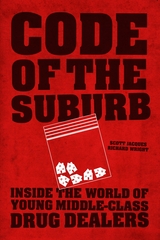 Code of the Suburb: Inside the World of Young Middle-Class Drug Dealers
Scott Jacques and Richard Wright
University of Chicago Press, 2015 When we think about young people dealing drugs, we tend to picture it happening on urban streets, in disadvantaged, crime-ridden neighborhoods. But drugs are used everywhere—even in upscale suburbs and top-tier high schools—and teenage users in the suburbs tend to buy drugs from their peers, dealers who have their own culture and code, distinct from their urban counterparts.
In Code of the Suburb, Scott Jacques and Richard Wright offer a fascinating ethnography of the culture of suburban drug dealers. Drawing on fieldwork among teens in a wealthy suburb of Atlanta, they carefully parse the complicated code that governs relationships among buyers, sellers, police, and other suburbanites. That code differs from the one followed by urban drug dealers in one crucial respect: whereas urban drug dealers see violent vengeance as crucial to status and security, the opposite is true for their suburban counterparts. As Jacques and Wright show, suburban drug dealers accord status to deliberate avoidance of conflict, which helps keep their drug markets more peaceful—and, consequently, less likely to be noticed by law enforcement.
Offering new insight into both the little-studied area of suburban drug dealing, and, by extension, the more familiar urban variety, Code of the Suburb will be of interest to scholars and policy makers alike.
 Coded Encounters: Writing, Gender, and Ethnicity in Colonial Latin America
Francisco Javier Cevallos
University of Massachusetts Press, 1994 Much has been written about the ways in which Columbus's "discovery" of America began a process of inventing a new world in European consciousness. But far less has been published about those on the margins of the dominant European discourse--Amerindians, Africans, and women--whose experience is reflected in documents written during the early years of European rule in Latin America. This volume brings together essays by leading scholars of colonial Latin America who address a series of topics relating to both the marginal and European-dominant discourses. The book is divided into five sections: "Representing the New World," "The Institutionalization of the Colony," "Amerindian Texts," "Women in Colonial Latin America," and "The Later Colony and the Caribbean Experience." The essays range from a consideration of Amerindian codes of mapmaking to the career of a transvestite nun, from confessional "sin lists" used by priests to examine the transgressions of their American charges to a new view of colonial women's lives based on birth records, dowry agreements, and wills. Contributors include Walter Mignolo, Maureen Ahern, Abel Alves, Rolena Adorno, Lúcia Helena Santiago Costigan, Pedro Lasarte, Raquel Chang-Rodríguez, Regina Harrison, Asunción Lavrin, Stephanie Merrim, Nina M. Scott, Antonio Carreño, Julie Greer Johnson, Karen Stolley, and Antonio Benítez-Rojo.
 Codependent Forevermore: The Invention of Self in a Twelve Step Group
Leslie Irvine
University of Chicago Press, 1999 In the same week that his father died, Alex came home to find his live-in fiancée in bed with another man. Paul is a divorced single parent who was recently forced to go on disability. Liz left an abusive husband and then found herself involved with yet another controlling man. These three, along with many others, have found a kind of salvation in Codependents Anonymous. Is this self-indulgent psychobabble or legitimate therapy? Are Twelve Step groups helpful communities or disguised addictions? And what exactly is codependency, the psychological condition that has apparently swept the United States? Leslie Irvine went inside "CoDA" to find out.
Codependent Forevermore is thus an insider's look at the world of people "in recovery" and the society that produced them. Through extensive interviews with CoDA members, case studies, and the meetings she attended regularly, Irvine develops a galvanizing perspective on contemporary Americans' sense of self. She explores the idea that selfhood is a narrative accomplishment, achieved by people telling stories to themselves and about themselves. She shows how Alex, Paul, Liz, and many others create a sense of self by combining elements of autobiography, culture, and social structure all within the adopted language of psycho-spirituality.
By following the progress and tribulations of CoDA members, Irvine gets to the heart of widespread American conceptions of relationships, selfhood, and community. Amidst the increasingly shrill criticism of the Twelve Step ethos, her reasoned and considered analysis of these groups reveals the sources of both their power and their popularity.
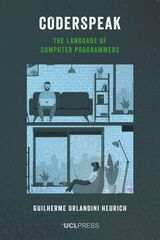 Coderspeak: The Language of Computer Programmers
Guilherme Orlandini Heurich
University College London, 2024 Coderspeak delves into the hidden world of software development, offering a combined anthropological and technical approach that explores the coder community's impact on our digital landscape.
Software applications have taken over our lives. We use and are used by software many times a day. Nevertheless, we know very little about the invisibly ubiquitous workers who write software. Who are they and how do they perceive their practice? How does that shape how they collaborate to build the myriad of apps that we use every day? And how does that impact the users of apps?
Coderspeak provides a critical approach to the digital transformation of our world through an engaging and thoughtful analysis of the people who write software applications. It is a focused and in-depth look at one programming language and its community, Ruby, based on ethnographic research at a London company and conversations with members of the wider Ruby community in Europe, the Americas, and Japan.
This book shows that the place where people write code, the language they write it in, and the stories shared by that community are crucial in questioning and unpacking what it means to be a coder. Understanding this social group is essential if we are to grasp a future (and a present) in which computer programming increasingly dominates our lives.
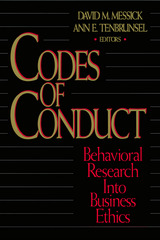 Codes of Conduct: Behavioral Research into Business Ethics
David M. Messick
Russell Sage Foundation, 1996 Despite ongoing efforts to maintain ethical standards, highly publicized episodes of corporate misconduct occur with disturbing frequency. Firms produce defective products, release toxic substances into the environment, or permit dangerous conditions to existin their workplaces. The propensity for irresponsible acts is not confined to rogue companies, but crops up in even the most respectable firms. Codes of Conduct is the first comprehensive attempt to understand these problems by applying the principles of modern behavioral science to the study of organizational behavior. Codes of Conduct probes the psychological and social processes through which companies and their managers respond to a wide array of ethical dilemmas, from risk and safety management to the treatment of employees. The contributors employ a wide range of case studies to illustrate the effects of social influence and group persuasion, organizational authority and communication, fragmented responsibility, and the process of rationalization. John Darley investigates how unethical acts are unintentionally assembled within organizations as a result of cascading pressures and social processes. Essays by Roderick Kramer and David Messick and by George Loewenstein focus on irrational decision making among managers. Willem Wagenaar examines how worker safety is endangered by management decisions that focus too narrowly on cost cutting and short time horizons. Essays by Baruch Fischhoff and by Robyn Dawes review the role of the expert in assessing environmental risk. Robert Bies reviews evidence that employees are more willing to provide personal information and to accept affirmative action programs if they are consulted on the intended procedures and goals. Stephanie Goodwin and Susan Fiske discuss how employees can be educated to base office judgments on personal qualities rather than on generalizations of gender, race, and ethnicity. Codes of Conduct makes an important scientific contribution to the understanding of decisionmaking and social processes in business, and offers clear insights into the design of effective policies to improve ethical conduct.
 Codes of Conduct: Race, Ethics, and the Color of Our Character
Holloway, Karla F. C.
Rutgers University Press, 1995 In Codes of Conduct, Karla Holloway meditates on the dynamics of race and ethnicity as they are negotiated in the realms of power. Her uniquely insightful and intelligent analysis guides us in a fresh way through Anita Hill’s interrogation, the assault on Tawana Brawley, the mass murders of Atlanta’s children, the schisms between the personal and public domains of her life as a black professor, and––in a moving epilogue––the story of her son’s difficulties growing up as a young black male in contemporary society. Its three main sections: “The Body Politic,” “Language, Thought, and Culture,” and “The Moral Lives of Children,” relate these issues to the visual power of the black and female body, the aesthetic resonance and racialized drama of language, and our children’s precarious habits of surviving. Throughout, Holloway questions the consequences in African-American community life of citizenship that is meted out sparingly when one’s ethnicity is colored.
This is a book of a culture’s stories––from literature, public life, contemporary and historical events, aesthetic expression, and popular culture––all located within the common ground of African-American ethnicity. Holloway writes with a passion, urgency, and wit that carry the reader swiftly through each chapter. The book should take its place among those other important contemporary works that speak to the future relationships between whites and blacks in this country.
 Codes of Misconduct: Regulating Prostitution in Late Colonial Bombay
Ashwini Tambe
University of Minnesota Press, 2009 Across the nineteenth and twentieth centuries, legislators in Bombay passed a series of repetitive laws seeking to control prostitution. During the same time, Bombay’s sex industry grew vast in scale. Ashwini Tambe explores why these remarkably similar laws failed to achieve their goal and questions the actual purpose of such lawmaking.
Against the backdrop of the industrial growth of Bombay, Codes of Misconduct examines the relationship between lawmaking, law enforcement, and sexual commerce. Ashwini Tambe challenges linear readings of how laws create effects and demonstrates that the regulation and criminalization of prostitution were not contrasting approaches to prostitution but different modes of state coercion. By analyzing legal prohibitions as productive forces, she also probes the pornographic imagination of the colonial state, showing how regulations made sexual commerce more visible but rendered the prostitute silent.
Codes of Misconduct engages with debates on state control of sex work and traces how a colonial legacy influences contemporary efforts to contain the spread of HIV and decriminalize sex workers in India today. In doing so, Tambe’s work not only adds to our understanding of empire, sexuality, and the law, it also sheds new light on the long history of Bombay’s transnational links and the social worlds of its underclasses.
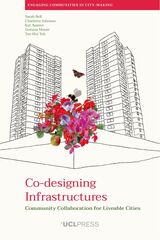 Co-designing Infrastructures: Community Collaboration for Liveable Cities
Sarah Bell, Charlotte Johnson, Kat Austen, Gemma Moore, and Tse-Hui Teh
University College London, 2023 An examination of projects designed to enable community groups to create their own solutions to global crises.
Co-designing Infrastructures tells the story of a research program designed to bring the power of engineering and technology into the hands of grassroots community groups in order to create bottom-up solutions to global crises. The authors examine in detail four projects in London in detail that exemplify collaboration with engineers, designers, and scientists to enact urban change. The projects at the heart of the book are grounded in specific settings that face challenges familiar to urban communities throughout the world. This place-based approach to infrastructure is of international relevance as a foundation for urban resilience and sustainability. The authors document the tools used to deliver this work, providing guidance for others who are working to deliver local technical solutions to complex social and environmental problems around the world.
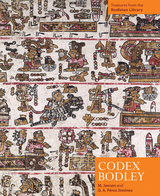 Codex Bodley: A Painted Chronicle from the Mixtec Highlands, Mexico
Maarten Jansen and Gabina Aurora Pérez Jiménez
Bodleian Library Publishing, 2005 Painted shortly before the Spanish conquest of Mexico in 1521, the Codex Bodley has been long recognized as one of the most important Mixtec manuscripts and a premier example of native Mixtec pictorial historiography in all its complexity. The complete manuscript of the Codex Bodley is offered here for the very first time in a single illustrated volume.
Codex Bodley explores the enormous wealth of information contained in the manuscript, which documents precolonial Mixtec genealogical relationships and historical events spanning from 900 AD to 1521. Maarten Jansen and Gabina Aurora Pérez Jiménez provide insightful and expert commentary on the manuscript, explaining its history as they consider key characteristics of Mixtec pictography. They then provide an engaging and masterful interpretation of the manuscript's narrative, with a detailed explanatory reading of its pictograms and their significance. Accompanied by vivid and colorful illustrations, Codex Bodley is an invaluable text for scholars of precolonial Mexican history, art, and culture.
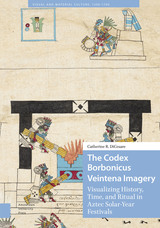 The Codex Borbonicus Veintena Imagery: Visualizing History, Time, and Ritual in Aztec Solar-Year Festivals
Catherine DiCesare
Amsterdam University Press, 2024 The sixteenth-century pictorial manuscript known as the Codex Borbonicus contains a remarkable record of the eighteen Mexica (or “Aztec”) festival periods of twenty days, known as veintenas, celebrated during the 365-day solar year. Because its indigenous artists framed the Borbonicus veintenas with historical year dates, this volume situates the annually recurring rituals within the march of linear, reckoned time, in the singular year “2 Reed” (1507), during the reign of Moteuczoma II. DiCesare attends to the historical dimensions of several unusual scenes, proposing that the veintenas probably varied significantly from year to year in response to historical concerns. She considers particularly whether the Borbonicus veintenas document the confluence of solar year ceremonies with a second set of ritual feast days, governed by the 260-day cycle known as the tonalpohualli, or “count of days.” In this way, DiCesare analyzes how linear and cyclical conceptions of time intersected in Mexica ritual performance.
Codex Chimalpopoca: The Text in Nahuatl with a Glossary and Grammatical Notes
John Bierhorst
University of Arizona Press, 2011 In this companion volume to History and Mythology of the Aztecs, John Bierhorst provides specialists with a transcription of the Nahuatl text, keyed to the translation, and a linguistic apparatus to help elucidate it. The glossary offers definitions for all unusual usages in the codex, as well as careful treatment of many of the commonest (and most semantically flexible) verbs, adverbs, and particles. Detailed discussions of selected features appear in the Grammatical Notes, which complete the work.
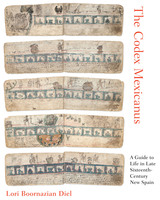 The Codex Mexicanus: A Guide to Life in Late Sixteenth-Century New Spain
By Lori Boornazian Diel
University of Texas Press, 2018 Winner, Roland H. Bainton Book Prize, The Sixteenth Century Society and Conference, 2019 Some sixty years after the Spanish conquest of Mexico, a group of Nahua intellectuals in Mexico City set about compiling an extensive book of miscellanea, which was recorded in pictorial form with alphabetic texts in Nahuatl clarifying some imagery or adding new information altogether. This manuscript, known as the Codex Mexicanus, includes records pertaining to the Aztec and Christian calendars, European medical astrology, a genealogy of the Tenochca royal house, and an annals history of pre-conquest Tenochtitlan and early colonial Mexico City, among other topics. Though filled with intriguing information, the Mexicanus has long defied a comprehensive scholarly analysis, surely due to its disparate contents. In this pathfinding volume, Lori Boornazian Diel presents the first thorough study of the entire Codex Mexicanus that considers its varied contents in a holistic manner. She provides an authoritative reading of the Mexicanus’s contents and explains what its creation and use reveal about native reactions to and negotiations of colonial rule in Mexico City. Diel makes sense of the codex by revealing how its miscellaneous contents find counterparts in Spanish books called Reportorios de los tiempos. Based on the medieval almanac tradition, Reportorios contain vast assortments of information related to the issue of time, as does the Mexicanus. Diel masterfully demonstrates that, just as Reportorios were used as guides to living in early modern Spain, likewise the Codex Mexicanus provided its Nahua audience a guide to living in colonial New Spain.
 Codex Parisinus Graecus 1115 and Its Archetype
Alexander Alexakis
Harvard University Press, 1996 For almost three centuries, scholars have debated the credibility of the information provided in the colophon of Codex Parisinus graecus 1115. According to this inscription, the manuscript was copied in the year 1276 from another manuscript dating back to the year 774/5; the archetype originated in the papal library at Rome and contains a partial record of the Greek holdings of the library.
The majority of the texts included in the manuscript come from florilegia related to the ecumenical councils. This volume examines the use of florilegia—anthologies of earlier writings—by these councils. Analysis of the contents of the manuscript provides new information concerning, among other things, the beginning of the Filioque controversy and the use of Iconophile florilegia by the seventh ecumenical council in 787. Also revealed is the archetype's role in the negotiations between Rome and Constantinople that led to the Union of the Churches, proclaimed at the Council of Lyons II in 1274, and the indirect involvement of Thomas Aquinas through his Contra Errores Graecorurn.
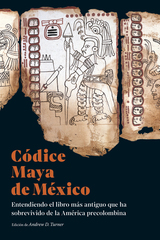 Códice Maya de México: Entendiendo el libro más antiguo que ha sobrevivido de la América precolombina
Andrew D. Turner
J. Paul Getty Trust, The Una exploración profunda de la historia, la autenticación y la relevancia moderna del Códice Maya de México, el libro más antiguo del continente americano.
Los antiguos escribas mayas registraban profecías y observaciones astronómicas en las páginas de libros pintados. Aunque la mayoría se perdieron por el desgaste del paso del tiempo o porque fueron destruidos, se sabía que tres códices mayas prehispánicos habían sobrevivido. Sin embargo, en la década de 1960 apareció en México, en circunstancias misteriosas, un cuarto libro diferente a los demás. Después de cincuenta años de debate sobre su autenticidad, investigaciones recientes con análisis científicos e histórico-artísticos de vanguardia, determinaron que el Códice Maya de México (antes conocido como Códice Grolier) es, de hecho, el libro más antiguo del continente americano: al menos doscientos años más antiguo que los demás.
Este volumen ofrece una introducción multifacética a la creación, el descubrimiento, la interpretación y la autenticación científica del Códice Maya de México. Además, un facsímil a todo color y una guía de la iconografía página por página hacen que un amplio público pueda acceder al códice. Otros temas incluyen los usos y la importancia de los libros sagrados en Mesoamérica, el papel de la astronomía en las antiguas sociedades mayas y la continua relevancia del códice para las comunidades mayas contemporáneas.
La publicación de este volumen acompaña la exposición que se exhibirá en el J. Paul Getty Museum ubicado en el Getty Center del 18 de octubre de 2022 al 15 de enero de 2023.
An in-depth exploration of the history, authentication, and modern relevance of Códice Maya de México, the oldest surviving book of the Americas.
Ancient Maya scribes recorded prophecies and astronomical observations on the pages of painted books. Although most were lost to decay or destruction, three pre-Hispanic Maya codices were known to have survived, when, in the 1960s, a fourth book that differed from the others appeared in Mexico under mysterious circumstances. After fifty years of debate over its authenticity, recent investigations using cutting-edge scientific and art historical analyses determined that Códice Maya de México (formerly known as Grolier Codex) is in fact the oldest surviving book of the Americas, predating all others by at least two hundred years.
This volume provides a multifaceted introduction to the creation, discovery, interpretation, and scientific authentication of Códice Maya de México. In addition, a full-color facsimile and a page-by-page guide to the iconography make the codex accessible to a wide audience. Additional topics include the uses and importance of sacred books in Mesoamerica, the role of astronomy in ancient Maya societies, and the codex's continued relevance to contemporary Maya communities.
This volume is published to accompany an exhibition on view at the J. Paul Getty Museum at the Getty Center from October 18, 2022, to January 15, 2023.
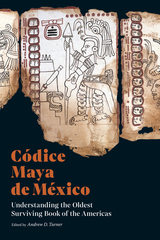 Códice Maya de México: Understanding the Oldest Surviving Book of the Americas
Andrew D. Turner
J. Paul Getty Trust, The, 2022 An in-depth exploration of the history, authentication, and modern relevance of Códice Maya de México, the oldest surviving book of the Americas.
Ancient Maya scribes recorded prophecies and astronomical observations on the pages of painted books. Although most were lost to decay or destruction, three pre-Hispanic Maya codices were known to have survived, when, in the 1960s, a fourth book that differed from the others appeared in Mexico under mysterious circumstances. After fifty years of debate over its authenticity, recent investigations using cutting-edge scientific and art historical analyses determined that Códice Maya de México (formerly known as Grolier Codex) is in fact the oldest surviving book of the Americas, predating all others by at least two hundred years.
This volume provides a multifaceted introduction to the creation, discovery, interpretation, and scientific authentication of Códice Maya de México. In addition, a full-color facsimile and a page-by-page guide to the iconography make the codex accessible to a wide audience. Additional topics include the uses and importance of sacred books in Mesoamerica, the role of astronomy in ancient Maya societies, and the codex's continued relevance to contemporary Maya communities.
This volume is published to accompany an exhibition on view at the J. Paul Getty Museum at the Getty Center from October 18, 2022, to January 15, 2023.
 Coding and Redundancy: Man-Made and Animal-Evolved Signals
Jack P. Hailman
Harvard University Press, 2008 This book explores the strikingly similar ways in which information is encoded in nonverbal man-made signals (e.g., traffic lights and tornado sirens) and animal-evolved signals (e.g., color patterns and vocalizations). The book also considers some coding principles for reducing certain unwanted redundancies and explains how desirable redundancies enhance communication reliability.
Jack Hailman believes this work pioneers several aspects of analyzing human and animal communication. The book is the first to survey man-made signals as a class. It is also the first to compare such human-devised systems with signaling in animals by showing the highly similar ways in which the two encode information. A third innovation is generalizing principles of quantitative information theory to apply to a broad range of signaling systems. Finally, another first is distinguishing among types of redundancy and their separation into unwanted and desirable categories.
This remarkably novel book will be of interest to a wide readership. Appealing not only to specialists in semiotics, animal behavior, psychology, and allied fields but also to general readers, it serves as an introduction to animal signaling and to an important class of human communication.
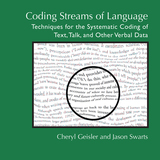 Coding Streams of Language: Techniques for the Systematic Coding of Text, Talk, and Other Verbal Data
Cheryl Geisler
University Press of Colorado, 2020 Coding Streams of Language is a systematic and practical research guide to coding verbal data in all its forms—written texts and oral talk, in print or online, gathered through surveys and interviews, database searches, or audio or video recordings. The thoughtful, detailed advice found in this book will help readers carry out analyses of language that are both systematic and complex. Situating themselves in the relatively new line of mixed methods research, the authors provide guidance on combining context-based inquiry with quantitative tools for examining big picture patterns that acknowledges the complexity of language use. Throughout Coding Streams of Language, exercises, points for discussion, and milestones help guide readers through an analytic project. As a supplement to the book, YouTube videos demonstrate tools and techniques.
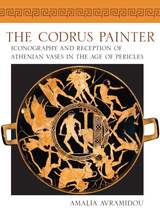 The Codrus Painter: Iconography and Reception of Athenian Vases in the Age of Pericles
Amalia Avramidou
University of Wisconsin Press, 2011 The Codrus Painter was a painter of cups and vases in fifth-century B.C.E. Athens with a distinctive style; he is named after Codrus, a legendary Athenian king depicted on one of his most characteristic vases. He was active as an artist during the rule of Pericles, as the Parthenon was built and then as the troubled times of the Peloponnesian War began. In contrast to the work of fellow artists of his day, the vases of the Codrus Painter appear to have been created almost exclusively for export to markets outside Athens and Greece, especially to the Etruscans in central Italy and to points further west.
Amalia Avramidou offers a thoroughly researched, amply illustrated study of the Codrus Painter that also comments on the mythology, religion, arts, athletics, and daily life of Greece depicted on his vases. She evaluates his style and the defining characteristics of his own hand and of the minor painters associated with him. Examining the subject matter, figure types, and motifs on the vases, she compares them with sculptural works produced during the same period. Avramidou’s iconographic analysis not only encompasses the cultural milieu of the Athenian metropolis, but also offers an original and intriguing perspective on the adoption, meaning, and use of imported Attic vases among the Etruscans.
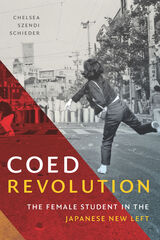 Coed Revolution: The Female Student in the Japanese New Left
Chelsea Szendi Schieder
Duke University Press, 2021 In the 1960s, a new generation of university-educated youth in Japan challenged forms of capitalism and the state. In Coed Revolution Chelsea Szendi Schieder recounts the crucial stories of Japanese women's participation in these protest movements led by the New Left through the early 1970s. Women were involved in contentious politics to an unprecedented degree, but they and their concerns were frequently marginalized by men in the movement and the mass media, and the movement at large is often memorialized as male and masculine. Drawing on stories of individual women, Schieder outlines how the media and other activists portrayed these women as icons of vulnerability and victims of violence, making women central to discourses about legitimate forms of postwar political expression. Schieder disentangles the gendered patterns that obscured radical women's voices to construct a feminist genealogy of the Japanese New Left, demonstrating that student activism in 1960s Japan cannot be understood without considering the experiences and representations of these women.
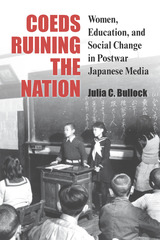 Coeds Ruining the Nation: Women, Education, and Social Change in Postwar Japanese Media
Julia C. Bullock
University of Michigan Press, 2019 In the late 1800s, Japan introduced a new, sex-segregated educational system. Boys would be prepared to enter a rapidly modernizing public sphere, while girls trained to become “good wives and wise mothers” who would contribute to the nation by supporting their husbands and nurturing the next generation of imperial subjects. When this system was replaced by a coeducational model during the American Occupation following World War II, adults raised with gender-specific standards were afraid coeducation would cause “moral problems”—even societal collapse. By contrast, young people generally greeted coeducation with greater composure.
This is the first book in English to explore the arguments for and against coeducation as presented in newspaper and magazine articles, cartoons, student-authored school newsletters, and roundtable discussions published in the Japanese press as these reforms were being implemented. It complicates the notion of the postwar years as a moment of rupture, highlighting prewar experiments with coeducation that belied objections that the practice was a foreign imposition and therefore “unnatural” for Japanese culture. It also illustrates a remarkable degree of continuity between prewar and postwar models of femininity, arguing that Occupation-era guarantees of equal educational opportunity were ultimately repurposed toward a gendered division of labor that underwrote the postwar project of economic recovery. Finally, it excavates discourses of gender and sexuality underlying the moral panic surrounding coeducation to demonstrate that claims of rampant sexual deviance and other concerns were employed as disciplinary mechanisms to reinforce an ideology of harmonious gender complementarity and to dissuade women from pursuing conventionally masculine prerogatives.
 Coerced Contraception?: Moral and Policy Challenges of Long Acting Birth Control
Ellen H. Moskowitz and Bruce Jennings, Editors
Georgetown University Press Long-acting and reversible contraceptives, such as Norplant and Depo-Provera, have been praised as highly effective, moderately priced, and generally safe. Yet, as this book argues, the very qualities that make these contraceptives an important alternative for individual choice in family planning also make them a potential tool of coercive social policy. For example, policymakers have linked their use to welfare benefits, and judges, to probation agreements. In this book, authors from the fields of medicine, ethics, law, and the social sciences probe the unique and vexing ethical and policy issues raised by long-acting contraception. The book offers comprehensive ethical guidelines for health care professionals and policymakers, as well as an ethical framework for analyzing policies and practices concerning long?acting contraceptives. The authors consider cultural, social, and ethical issues pertaining to contraception, and they provide historical and scientific background on today's controversies. They explore alternative conceptual and theoretical frameworks, including analyses of autonomy, coercion, and responsibility in reproductive decisions.
This volume also notes the special concerns that arise when policies promoting long?term birth control target low-income women and women of color, and when these contraceptives are used in developing countries.
Coerced Labour, Forced Displacement, and the Soviet Gulag, 1880s-1930s
Zhanna Popova
Amsterdam University Press, 2024 The Gulag remains one of the key symbols of twentieth-century mass political violence. Thanks to recent archive-based investigations, we now understand the scope of the system, variations between different camp complexes, and modalities of the use of forced labour of convicts. At the same time, the work of historicizing the Gulag and systematically evaluating its position within the global history of repression is still to be done. Exploring the emergence of this vast Soviet system of concentration camps in long-term perspective, this book aims to inscribe this process within global histories of coerced labour, forced displacement, and punishment. It highlights the inextricable interconnection of coerced labour and forced displacement as tools of punishment in the multitude of their historical forms.
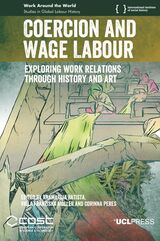 Coercion and Wage Labour: Exploring Work Relations through History and Art
Edited by Anamarija Batista, Viola Müller, and Corinna Peres
University College London, 2023 Novel histories of people who experienced physical, social, political, or cultural compulsion in the course of paid work.
Broad in scope, Coercion and Wage Labour examines diverse areas of work including textile production, war industries, civil service, and domestic labor, in contexts from the Middle Ages to the present day. This book demonstrates that wages have consistently shaped working people’s experiences and failed to protect workers from coercion. Instead, wages emerge as versatile tools to bind, control, and exploit workers. Remuneration mirrors the distribution of power in labor relations, often separating employers physically and emotionally from their employees and disguising coercion.
The book makes historical narratives accessible to interdisciplinary audiences. Most chapters are preceded by illustrations by artists invited to visually conceptualize the book’s key messages and to emphasize the presence of the body and landscape in the realm of work. In turn, the chapter texts reflect back on the artworks, creating an intense intermedial dialogue that offers mutually relational “translations” and narrations of labor coercion. Other contributions written by art scholars discuss how coercion in remunerated labor is constructed and reflected in artistic practice. The collection serves as an innovative and creative tool for teaching and raises awareness that narrating history is always contingent on the medium chosen and its inherent constraints and possibilities.
 Coercion to Speak: Conrad's Poetics of Dialogue
Aaron Fogel
Harvard University Press, 1985 Novelists have individually distinctive ideas of dialogue, Aaron Fogel argues. In this analysis of Conrad's narrative craft he explores--with broad implications--the theory and uses of dialogue.
Conrad's was a distinctive reading of the English language conditioned by his particular idea of forced speech and forced writing. Fogel shows how Conrad shaped ideas and events and interpreted character and institutions by means of dialogues representing not free exchange but various forms of forcing another to respond. He applied this format not only to the obvious political contexts, such as inquisition or spying, but also to seemingly more private relations, such as marriage, commerce, and storytelling. His idea of dialogue shaded the meanings he gave to words even to characters' names. Conrad is particularly interested in scenes in which a speech-forcer is surprised, repudiated, or punished. Fogel concludes that Conrad increasingly saw the punishment of the speech-forcer as classically related to Oedipus inquiries, in which the provoked answers rebound upon and destroy the forcer. This punishment is--as Shakespeare, Scott, and Wordsworth also dramatically intuited--the classical Oedipal dialogue scene.
Fogel's analysis ranges widely over Conrad's fiction but focuses especially on Nostromo, The Secret Agent, and Under Western Eyes. His readings offer a balanced critique of Mikhail Bakhtin's theories about dialogic. Conrad's novels have many of the features Bakhtin identified as dialogical; but he was preoccupied with coercion in dialogue form. Fogel proposes that to understand this form is to begin to reconsider our political and aesthetic assumptions about what dialogue is or ought to be.
 Coercive Commerce: Global Capital and Imperial Governance at the End of the Qing Empire
Stacie A. Kent
Hong Kong University Press, 2025 An extensive analysis of the development of capital in Qing Empire China.
In 1842, the Qing Empire signed a watershed commercial treaty with Great Britain, beginning a century-long period in which geopolitical and global economic entanglements intruded on Qing territory and governance. Previously understood as an era of “semi-colonialism,” Stacie A. Kent reframes this century of intervention by shedding light on the generative force of global capital.
Based on extensive research, conducted with British and Chinese government archives, Coercive Commerce shows how commercial treaties and the regulatory regime that grew out of them catalyzed a revised arts of governance in Qing-administered China. Capital, which had long been present in Chinese merchants’ pocketbooks, came to shape and even govern Chinese statecraft during the “treaty era.” This book contends that Qing administrators alternately resisted and adapted to this new reality through taxation systems such as transit passes and the Imperial Maritime Customs Service by reorganizing Chinese territory into a space where global circuits of capital could circulate and reproduce at an ever greater scale.
Offering a deep dive into the coercive nature of capitalism and the historically specific ways global capital reproduction took root in Qing China, Coercive Commerce will interest historians of capital and modern China alike.
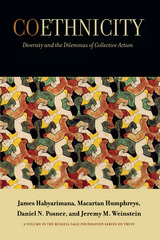 Coethnicity: Diversity and the Dilemmas of Collective Action
James Habyarimana
Russell Sage Foundation, 2009 Ethnically homogenous communities often do a better job than diverse communities of producing public goods such as satisfactory schools and health care, adequate sanitation, and low levels of crime. Coethnicity reports the results of a landmark study that aimed to find out why diversity has this cooperation-undermining effect. The study, conducted in a neighborhood of Kampala, Uganda, notable for both its high levels of diversity and low levels of public goods provision, hones in on the mechanisms that might account for the difficulties diverse societies often face in trying to act collectively. The Mulago-Kyebando Community Study uses behavioral games to explore how the ethnicity of the person with whom one is interacting shapes social behavior. Hundreds of local participants interacted with various partners in laboratory games simulating real-life decisions involving the allocation of money and the completion of joint tasks. Many of the subsequent findings debunk long-standing explanations for diversity's adverse effects. Contrary to the prevalent notion that shared preferences facilitate ethnic collective action, differences in goals and priorities among participants were not found to be structured along ethnic lines. Nor was there evidence that subjects favored the welfare of their coethnics over that of non-coethnics. When given the opportunity to act altruistically, individuals did not choose to benefit coethnics disproportionately when their actions were anonymous. Yet when anonymity was removed, subjects behaved very differently. With their actions publicly observed, subjects gave significantly more to coethnics, expected their partners to reciprocate, and expected that they would be sanctioned for a failure to cooperate. This effect was most pronounced among individuals who were otherwise least likely to cooperate. These results suggest that what may look like ethnic favoritism is, in fact, a set of reciprocity norms—stronger among coethnics than among non-coethnics—that make it possible for members of more homogeneous communities to take risks, invest, and cooperate without the fear of getting cheated. Such norms may be more subject to change than deeply held ethnic antipathies—a powerful finding for policymakers seeking to design social institutions in diverse societies. Research on ethnic diversity typically draws on either experimental research or field work. Coethnicity does both. By taking the crucial step from observation to experimentation, this study marks a major breakthrough in the study of ethnic diversity. A Volume in the Russell Sage Foundation Series on Trust
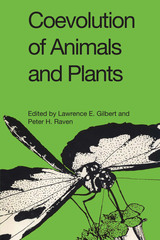 Coevolution of Animals and Plants: Symposium V, First International Congress of Systematic and Evolutionary Biology, 1973
Edited by Lawrence E. Gilbert and Peter H. Raven
University of Texas Press, 1975 It has long been recognized that plants and animals profoundly affect one another’s characteristics during the course of evolution. However, the importance of coevolution as a dynamic process involving such diverse factors as chemical communication, population structure and dynamics, energetics, and the evolution, structure, and functioning of ecosystems has been widely recognized for a comparatively short time. Coevolution represents a point of view about the structure of nature that only began to be fully explored in the late twentieth century. The papers presented here herald its emergence as an important and promising field of biological research. Coevolution of Animals and Plants is the first book to focus on the dynamic aspects of animal-plant coevolution. It covers, as broadly as possible, all the ways in which plants interact with animals. Thus, it includes discussions of leaf-feeding animals and their impact on plant evolution as well as of predator-prey relationships involving the seeds of angiosperms. Several papers deal with the most familiar aspect of mutualistic plant-animal interactions—pollination relationships. The interactions of orchids and bees, ants and plants, and butterflies and plants are discussed. One article provides a fascinating example of more indirect relationships centered around the role of carotenoids, which are produced by plants but play a fundamental part in the visual systems of both plants and animals. Coevolution of Animals and Plants provides a general conceptual framework for studies on animal-plant interaction. The papers are written from a theoretical, rather than a speculative, standpoint, stressing patterns that can be applied in a broader sense to relationships within ecosystems. Contributors to the volume include Paul Feeny, Miriam Rothschild, Christopher Smith, Brian Hocking, Lawrence Gilbert, Calaway Dodson, Herbert Baker, Bernd Heinrich, Doyle McKey, and Gordon Frankie.
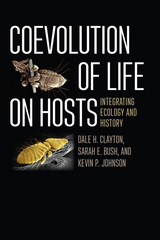 Coevolution of Life on Hosts: Integrating Ecology and History
Dale H. Clayton, Sarah E. Bush, and Kevin P. Johnson
University of Chicago Press, 2015 For most, the mere mention of lice forces an immediate hand to the head and recollection of childhood experiences with nits, medicated shampoos, and traumatic haircuts. But for a certain breed of biologist, lice make for fascinating scientific fodder, especially enlightening in the study of coevolution. In this book, three leading experts on host-parasite relationships demonstrate how the stunning coevolution that occurs between such species in microevolutionary, or ecological, time generates clear footprints in macroevolutionary, or historical, time. By integrating these scales, Coevolution of Life on Hosts offers a comprehensive understanding of the influence of coevolution on the diversity of all life.
Following an introduction to coevolutionary concepts, the authors combine experimental and comparative host-parasite approaches for testing coevolutionary hypotheses to explore the influence of ecological interactions and coadaptation on patterns of diversification and codiversification among interacting species. Ectoparasites—a diverse assemblage of organisms that ranges from herbivorous insects on plants, to monogenean flatworms on fish, and feather lice on birds—are powerful models for the study of coevolution because they are easy to observe, mark, and count. As lice on birds and mammals are permanent parasites that spend their entire lifecycles on the bodies of their hosts, they are ideally suited to generating a synthetic overview of coevolution—and, thereby, offer an exciting framework for integrating the concepts of coadaptation and codiversification.
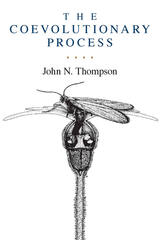 The Coevolutionary Process
John N. Thompson
University of Chicago Press, 1994 Traditional ecological approaches to species evolution have frequently studied too few species, relatively small areas, and relatively short time spans. In The Coevolutionary Process, John N. Thompson advances a new conceptual approach to the evolution of species interactions—the geographic mosaic theory of coevolution. Thompson demonstrates how an integrated study of life histories, genetics, and the geographic structure of populations yields a broader understanding of coevolution, or the development of reciprocal adaptations and specializations in interdependent species.
Using examples of species interactions from an enormous range of taxa, Thompson examines how and when extreme specialization evolves in interdependent species and how geographic differences in specialization, adaptation, and the outcomes of interactions shape coevolution. Through the geographic mosaic theory, Thompson bridges the gap between the study of specialization and coevolution in local communities and the study of broader patterns seen in comparisons of the phylogenies of interacting species.
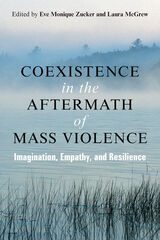 Coexistence in the Aftermath of Mass Violence: Imagination, Empathy, and Resilience
Edited by Eve Monique Zucker and Laura McGrew
University of Michigan Press, 2020 Coexistence in the Aftermath of Mass Violence demonstrates how imagination, empathy, and resilience contribute to the processes of social repair after ethnic and political violence. Adding to the literature on transitional justice, peacebuilding, and the anthropology of violence and social repair, the authors show how these conceptual pathways--imagination, empathy and resilience--enhance recovery, coexistence and sustainable peace. Coexistence (or reconciliation) is the underlying goal or condition desired after mass violence, enabling survivors to move forward with their lives. Imagination allows these survivors--victims, perpetrators, bystanders--to draw guidance and inspiration from their social and cultural imaginaries, to develop empathy, and to envision a future of peace and coexistence. Resilience emerges through periods of violence and its aftermaths through acts of survival, compassion, modes of rebuilding social worlds, and the establishment of a peaceful society. Focusing on society at the grass roots level, the authors discuss the myriad and little understood processes of social repair that allow ruptured societies and communities to move toward a peaceful and stable future. The volume also illustrates some of the ways in which imagination, empathy, and resilience may contribute to the prevention of future violence and the authors conclude with a number of practical and policy recommendations. The cases include Cambodia, Rwanda, Sierra Leone, Somaliland, Columbia, the Southern Cone, Iraq, and Bosnia.
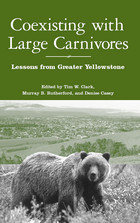 Coexisting with Large Carnivores: Lessons From Greater Yellowstone
Edited by Tim W. Clark, Murray B. Rutherford, and Denise Casey
Island Press, 2005 As in the rest of the United States, grizzly bears, wolves, and mountain lions in and around Yellowstone National Park were eliminated or reduced decades ago to very low numbers. In recent years, however, populations have begun to recover, leading to encounters between animals and people and, more significantly, to conflicts among people about what to do with these often controversial neighbors. Coexisting with Large Carnivores presents a close-up look at the socio-political context of large carnivores and their management in western Wyoming south of Yellowstone National Park, including the southern part of what is commonly recognized as the Greater Yellowstone Ecosystem. The book brings together researchers and others who have studied and worked in the region to help untangle some of the highly charged issues associated with large carnivores, their interactions with humans, and the politics that arise from those interactions. This volume argues that coexistence will be achieved only by a thorough understanding of the human populations involved, their values, attitudes, beliefs, and the institutions through which carnivores and humans are managed. Coexisting with Large Carnivores offers important insights into this complex, dynamic issue and provides a unique overview of issues and strategies for managers, researchers, government officials, ranchers, and everyone else concerned about the management and conservation of large carnivores and the people who live nearby.
 Coffee and Community: Maya Farmers and Fair-Trade Markets
Sarah Lyon
University Press of Colorado, 2010 We are told that simply by sipping our morning cup of organic, fair-trade coffee we are encouraging environmentally friendly agricultural methods, community development, fair prices, and shortened commodity chains. But what is the reality for producers, intermediaries, and consumers? This ethnographic analysis of fair-trade coffee analyzes the collective action and combined efforts of fair-trade network participants to construct a new economic reality. Focusing on La Voz Que Clama en el Desierto-a cooperative in San Juan la Laguna, Guatemala-and its relationships with coffee roasters, importers, and certifiers in the United States, Coffee and Community argues that while fair trade does benefit small coffee-farming communities, it is more flawed than advocates and scholars have acknowledged. However, through detailed ethnographic fieldwork with the farmers and by following the product, fair trade can be understood and modified to be more equitable. This book will be of interest to students and academics in anthropology, ethnology, Latin American studies, and labor studies, as well as economists, social scientists, policy makers, fair-trade advocates, and anyone interested in globalization and the realities of fair trade. Winner of the Society for Economic Anthropology Book Award
Coffee and Conflict in Colombia, 1886-1910
Charles W. Bergquist
Duke University Press, 1978 The appearance of Coffee and Conflict in Colombia, 1886-1910, had several important consequences for the entire field of Latin American history, as well as for the study of Colombia. Through Bergquist's analysis of this transitional period in terms of what has been called the dependency theory, he has left his mark on all subsequent studies in Latin American affairs; questions of economic development and political alignment cannot be dealt with without confronting Bergquist's work. he has also provided a major contribution to Colombian history by his examination of the growth of the coffee industry and Thousand Days War.
 Coffee and Power: Revolution and the Rise of Democracy in Central America
Jeffery M. Paige
Harvard University Press, 1997 In the revolutionary decade between 1979 and 1992, it would have been difficult to find three political systems as different as death-squad-dominated El Salvador, peaceful social-democratic Costa Rica, and revolutionary Sandinista Nicaragua. Yet when the fighting was finally ended by a peace plan initiated by Costa Rica's President Oscar Arias, all three had found a common destination in democracy and free markets. To explain this extraordinary turn of events is the task of this landmark book, which fuses political economy and cultural analysis.
Both the divergent political histories and their convergent outcome were shaped by a single commodity that has dominated these export economies from the nineteenth century to the present--coffee. Jeffery Paige shows that the crises of the 1980s had their roots in the economic and political crises of the 1930s, when the revolutionary left challenged the ruling coffee elites of all three countries. He interweaves and compares the history, economics, and class structures of the three countries, thus clarifying the course of recent struggles. The heart of the book is his conversations with sixty-two leaders of fifty-eight elite dynasties, who for the first time tell their own stories of the experience of Central American revolution.
Paige's analysis challenges not only Barrington Moore's influential theory of dictatorship and democracy but also contemporary approaches to "transitions to democracy." It also shows that a focus on either political economy or culture alone cannot account for the transformation of elite ideology, and that revolution in Central America is deeply rooted in the personal, familial, and class histories of the coffee elites.
Coffee Atlas of Ethiopia
Aaron Davis et al.
Royal Botanic Gardens, Kew, 2018 In Ethiopia, the birthplace of coffee drinking, coffee is more than a bean or a beverage—it’s an entire world. This atlas of Ethiopian coffee features the central elements of coffee production in Ethiopia, from detailed studies of the coffee plant to a large-scale view of its cultivation across Ethiopia. The book provides maps not only of the forests and farms where the bean grows, but the transportation networks that bring this coveted crop to the world. With single-origin coffees on the rise, this book will be a fascinating read to coffee geeks and industry insiders alike.
A Coffee Frontier: Land, Society, and Politics in Duaca, Venezuela, 1830–1936
Douglas Yarrington
University of Pittsburgh Press, 1998 This study views the economic transformation of Duaca, Venezuela into a major coffee export center in the late nineteenth century. Yarrington examines the rise of the peasantry to prosperity, yet they later lost their stature as the local elite allied itself with the state to restructure society and coffee production on its own terms in the twentieth-century. The book is a pioneering study on peasant studies, export-led development, the relationship of state and society, and the consolidation of nation-states in Latin America.
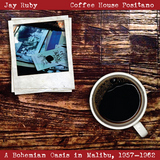 Coffee House Positano: A Bohemian Oasis in Malibu, 1957–1962
Jay Ruby
University Press of Colorado, 2013 This unique auto-ethnographic study of life at the Coffee House Positano—a Bohemian coffee house in Malibu, California—during the late 1950s and early 1960s is a combination of historical reconstruction and personal memoir. An ebook consisting of a collection of memories expressed through multiple formats—text, image, audio, and video—it describes in illuminating detail the great range of people who frequented Positano and the activities that took place there over its short but influential existence. As an ethnographer analyzing his own culture, author Jay Ruby uses a unique ethnographic method known as “studying sideways.” He combines the exploration of self and others with the theoretical framework of anthropology to provide deep insight into the counterculture of late 1950s and early 1960s America. He shares his connection to Positano, where he lived and worked from 1957 to 1959 and again in 1963, and reflects on Positano in the context of US counterculture and the greater role of countercultures in society. This intimate and significant work will be of interest to anthropologists as well as scholars and the general reader interested in California history, Beat culture, and countercultural movements.
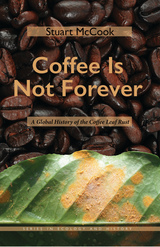 Coffee Is Not Forever: A Global History of the Coffee Leaf Rust
Stuart McCook
Ohio University Press, 2019 The global coffee industry, which fuels the livelihoods of farmers, entrepreneurs, and consumers around the world, rests on fragile ecological foundations. In Coffee Is Not Forever, Stuart McCook explores the transnational story of this essential crop through a history of one of its most devastating diseases, the coffee leaf rust. He deftly synthesizes agricultural, social, and economic histories with plant genetics and plant pathology to investigate the increasing interdependence of the world’s coffee-producing zones. In the process, he illuminates the progress and prognosis of the challenges—especially climate change—that pose an existential threat to a crop that global consumers often take for granted. And finally, in putting a tropical plant disease at the forefront, he has crafted the first truly global environmental history of coffee, pushing its study and the discipline in bold new directions.
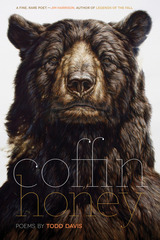 Coffin Honey
Todd Davis
Michigan State University Press, 2022 In Coffin Honey, his seventh book of poems, celebrated poet Todd Davis explores the many forms of violence we do to each other and to the other living beings with whom we share the planet. Here racism, climate collapse, and pandemic, as well as the very real threat of extinction—both personal and across ecosystems—are dramatized in intimate portraits of Rust-Belt Appalachia: a young boy who has been sexually assaulted struggles with dreams of revenge and the possible solace that nature might provide; a girl whose boyfriend has enlisted in the military faces pregnancy alone; and a bear named Ursus navigates the fecundity of the forest after his own mother’s death, literally crashing into the encroaching human world. Each poem in Coffin Honey seeks to illuminate beauty and suffering, the harrowing precipice we find ourselves walking nearer to in the twenty-first century. As with his past prize-winning volumes, Davis, whose work Orion Magazine likens to that of Wendell Berry and Mary Oliver, names the world with love and care, demonstrating what one reviewer describes as his knowledge of “Latin names, common names, habitats, and habits . . . steeped in the exactness of the earth and the science that unfolds in wildness.”
The Coffin Tree
Wendy Law-Yone
Northwestern University Press, 2003 Wendy Law-Yone opens her first novel with the phrase of a survivor, "Living things prefer to go on living." A young woman and her older half-brother are expelled from their home in Burma by a savage political coup. Sent to elusive safety in America, the motherless siblings find themselves engulfed by the indifference, hypocrisy, and cruelty of an American society unable to deal with difference. Her brother's death drives the unnamed narrator into the seclusion of a mental hospital, where memories of her childhood and the strength it ingrained in her are enough to heal her heart and return her to the outside world.
Cogeneration: A user's guide
David Flin
The Institution of Engineering and Technology, 2009 If there are two phrases we have come to know very well, they are 'environmental awareness' and 'credit crunch'. The world is looking for ways to decrease the emission of CO2 into the atmosphere, without incurring major costs in doing so. By increasing efficiencies up to about 90 per cent using well-established and mature technologies, cogeneration represents the best option for short-term reductions in CO2 emission levels.
Cogeneration and District Energy Systems: Modelling, analysis and optimization
Marc A. Rosen
The Institution of Engineering and Technology, 2016 District energy (DE) systems use central heating and/or cooling facilities to provide heating and/or cooling services for communities and can be particularly beneficial when integrated with cogeneration plants for electricity and heat. This book provides information on district energy and cogeneration technologies, and the systems that combine them, with a focus on their modelling, analysis and optimization.
Cogeneration: Technologies, optimization and implementation
Christos A. Frangopoulos
The Institution of Engineering and Technology, 2017 Cogeneration, also called combined heat and power (CHP), refers to the use of a power station to deliver two or more useful forms of energy, for example, to generate electricity and heat at the same time. All conventional, fuel-based plants generate heat as by-product, which is often carried away and wasted. Cogeneration captures part of this heat for delivery to consumers and is thus a thermodynamically efficient use of fuel, and contributes to reduction of carbon emissions. This book provides an integrated treatment of cogeneration, including a tour of the available technologies and their features, and how these systems can be analysed and optimised.
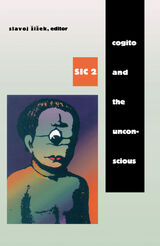 Cogito and the Unconscious: sic 2
Slavoj Žižek, ed.
Duke University Press, 1998 The Cartesian cogito—the principle articulated by Descartes that "I think, therefore I am"—is often hailed as the precursor of modern science. At the same time, the cogito's agent, the ego, is sometimes feared as the agency of manipulative domination responsible for all present woes, from patriarchal oppression to ecological catastrophes. Without psychoanalyzing philosophy, Cogito and the Unconscious explores the vicissitudes of the cogito and shows that psychoanalyses can render visible a constitutive madness within modern philosophy, the point at which "I think, therefore I am" becomes obsessional neurosis characterized by "If I stop thinking, I will cease to exist." Noting that for Lacan the Cartesian construct is the same as the Freudian "subject of the unconscious," the contributors follow Lacan's plea for a psychoanalytic return to the cogito. Along the path of this return, they examine the ethical attitude that befits modern subjectivity, the inherent sexualization of modern subjectivity, the impasse in which the Cartesian project becomes involved given the enigmatic status of the human body, and the Cartesian subject's confrontation with its modern critics, including Althusser, Bataille, and Dennett. In a style that has become familiar to Žižek's readers, these essays bring together a strict conceptual analysis and an approach to a wide range of cultural and ideological phenomena—from the sadist paradoxes of Kant's moral philosophy to the universe of Ayn Rand's novels, from the question "Which, if any, is the sex of the cogito?" to the defense of the cogito against the onslaught of cognitive sciences. Challenging us to reconsider fundamental notions of human consciousness and modern subjectivity, this is a book whose very Lacanian orthodoxy makes it irreverently transgressive of predominant theoretical paradigms. Cogito and the Unconscious will appeal to readers interested in philosophy, psychoanalysis, cultural studies, and theories of ideology. Contributors. Miran Bozovic, Mladen Dolar, Alain Grosrichard, Marc de Kessel, Robert Pfaller, Renata Salecl, Slavoj Žižek, Alenka Zupancic
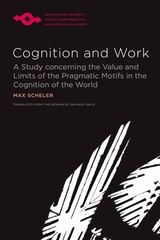 Cognition and Work: A Study concerning the Value and Limits of the Pragmatic Motifs in the Cognition of the World
Max Scheler; Translated from the German by Zachary Davis
Northwestern University Press, 2021 Max Scheler’s Cognition and Work (Erkenntnis und Arbeit) first appeared in German in 1926, just two years before his death. The first part of the book offers one of the earliest critical analyses of American pragmatism, an analysis that would come to have a significant impact on the reception of pragmatism in Germany and western Europe. The second part of the work contains Scheler’s phenomenological account of perception and the experience of reality, an account that is as original as both Husserl’s and Merleau-Ponty’s phenomenologies of perception. Scheler aims to show that the modern mechanistic view of nature fails to account for the dynamic relation that not only the human being but all living beings have to the environment they inhabit. Available in English translation for the first time, Cognition and Work pushes the boundaries of phenomenology as it is traditionally understood and offers insight into Scheler’s distinct metaphysics. This book is essential reading for those interested in phenomenology, pragmatism, perception, and living beings in their relation to the natural world.
Cognition of the Literary Work of Art
Roman Ingarden
Northwestern University Press, 1973 This long-awaited translation of Das literarische Kunstwerk makes available for the first time in English Roman Ingarden's influential study. Though it is inter-disciplinary in scope, situated as it is on the borderlines of ontology and logic, philosophy of literature and theory of language, Ingarden's work has a deliberately narrow focus: the literary work, its structure and mode of existence. The Literary Work of Art establishes the groundwork for a philosophy of literature, i.e., an ontology in terms of which the basic general structure of all literary works can be determined. This "essential anatomy" makes basic tools and concepts available for rigorous and subtle aesthetic analysis.
 Cognitive Behavioral Therapy for Christians with Depression: A Practical Tool-Based Primer
Michelle Pearce
Templeton Press, 2016 Does religion belong in psychotherapy? For anyone in the helping profession, whether as mental health professional or religious leader, this question is bound to arise. Many mental health professionals feel uncomfortable discussing religion. In contrast, many religious leaders feel uncomfortable referring their congregants to professionals who do not know their faith or intent to engage with it. And yet Michelle Pearce, PhD, assistant professor and clinical psychologist at the Center for Integrative Medicine at the University of Maryland, argues that if religion is essential to a client, religion will be a part of psychotherapy, whether it is discussed or not. Clients cannot check their values at the door more than the professionals who treat them. To Pearce, the question isn’t really, “does religion belong?” but rather, “how can mental health professionals help their religious clients engage with and use their faith as a healing resource in psychotherapy?” Cognitive Behavioral Therapy for Christian Clientswith Depression is the answer to that question, as the book’s purpose is to educate mental health professionals and pastoral counselors about religion’s role in therapy, as well as equip them to discuss religious issues and use evidence-based, religiously-integrated tools with Christian clients experiencing depression. In this book, readers will find the following resources in an easy-to-use format: - An overview of the scientific benefits of integrating clients’ religious beliefs and practices in psychotherapy
- An organizing therapeutic approach for doing Christian CBT
- Seven tools specific to Christian CBT to treat depression
- Suggested dialogue for therapists to introduce concepts and tools
- Skill-building activity worksheets for clients
- Clinical examples of Christian CBT and the seven tools in action
Practitioners will learn the helpful (and sometimes not so beneficial) role a person’s Christian faith can play in psychotherapy. They will be equipped to discuss religious issues and use religiously-integrated tools in their work. At the same time, clergy will learn how Christianity can be integrated into an evidence-based secular mental health treatment for depression, which is sure to increase their comfort level for making referrals to mental health practitioners who provide this form of treatment. Cognitive Behavioral Therapy for Christian Clients with Depression is a practical guide for mental health professionals and pastoral counselors who want to learn how to use Christian-specific CBT tools to treat depression in their Christian clients.
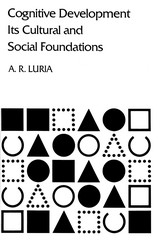 Cognitive Development: Its Cultural and Social Foundations
A. R. Luria
Harvard University Press, 1976 Alexander Romanovich Luria, one of the most influential psychologists of the twentieth century, is best known for his pioneering work on the development of language and thought, mental retardation, and the cortical organization of higher mental processes. Virtually unnoticed has been his major contribution to the understanding of cultural differences in thinking.
In the early 1930s young Luria set out with a group of Russian psychologists for the steppes of central Asia. Their mission: to study the impact of the socialist revolution on an ancient Islamic cotton-growing culture and, no less, to establish guidelines for a viable Marxist psychology. Lev Vygotsky, Luria's great teacher and friend, was convinced that variations in the mental development of children must be understood as a process including historically determined cultural factors. Guided by this conviction, Luria and his colleagues studied perception, abstraction, reasoning, and imagination among several remote groups of Uzbeks and Kirghiz—from cloistered illiterate women to slightly educated new friends of the central government.
The original hypothesis was abundantly supported by the data: the very structure of the human cognitive process differs according to the ways in which social groups live out their various realities. People whose lives are dominated by concrete, practical activities have a different method of thinking from people whose lives require abstract, verbal, and theoretical approaches to reality.
For Luria the legitimacy of treating human consciousness as a product of social history legitimized the Marxian dialectic of social development. For psychology in general, the research in Uzbekistan, its rich collection of data and the penetrating observations Luria drew from it, have cast new light on the workings of cognitive activity. The parallels between individual and social development are still being explored by researchers today. Beyond its historical and theoretical significance, this book represents a revolution in method. Much as Piaget introduced the clinical method into the study of children's mental activities, Luria pioneered his own version of the clinical technique for use in cross-cultural work. Had this text been available, the recent history of cognitive psychology and of anthropological study might well have been very different. As it is, we are only now catching up with Luria's procedures.
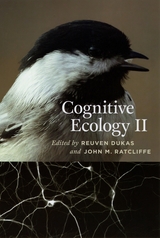 Cognitive Ecology II
Edited by Reuven Dukas and John M. Ratcliffe
University of Chicago Press, 2009 Merging evolutionary ecology and cognitive science, cognitive ecology investigates how animal interactions with natural habitats shape cognitive systems, and how constraints on nervous systems limit or bias animal behavior. Research in cognitive ecology has expanded rapidly in the past decade, and this second volume builds on the foundations laid out in the first, published in 1998. Cognitive Ecology II integrates numerous scientific disciplines to analyze the ecology and evolution of animal cognition. The contributors cover the mechanisms, ecology, and evolution of learning and memory, including detailed analyses of bee neurobiology, bird song, and spatial learning. They also explore decision making, with mechanistic analyses of reproductive behavior in voles, escape hatching by frog embryos, and predation in the auditory domain of bats and eared insects. Finally, they consider social cognition, focusing on alarm calls and the factors determining social learning strategies of corvids, fish, and mammals. With cognitive ecology ascending to its rightful place in behavioral and evolutionary research, this volume captures the promise that has been realized in the past decade and looks forward to new research prospects.
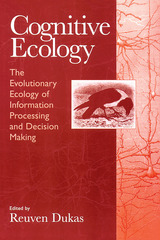 Cognitive Ecology: The Evolutionary Ecology of Information Processing and Decision Making
Edited by Reuven Dukas
University of Chicago Press, 1998 How does the environment shape the ways an animal processes information and makes decisions? How do constraints imposed on nervous systems affect an animal's activities? To help answer these questions, Cognitive Ecology integrates evolutionary ecology and cognitive science, demonstrating how studies of perception, memory, and learning can deepen our understanding of animal behavior and ecology.
Individual chapters consider such issues as the evolution of learning and its influence on behavior; the effects of cognitive mechanisms on the evolution of signaling behavior; how neurobiological and evolutionary processes have shaped navigational activities; functional and mechanical explanations for altered behaviors in response to changing environments; how foragers make decisions and how these decisions are influenced by the risks of predation; and how cognitive mechanisms affect partner choice.
Cognitive Ecology will encourage biologists to consider how animal cognition affects behavior, and will also interest comparative psychologists and cognitive scientists.
Cognitive Economy: The Economic Dimension of the Theory of Knowledge
Nicholas Rescher
University of Pittsburgh Press, 1989 Cost, expected benefits, and risks are paramount in grant agencies' decisions to fund scientific research. In Cognitive Economy, Nicholas Rescher outlines a general theory for the cost-effective use of intellectual resources, amplifying the theories of Charles Sanders Pierce, who stressed an “economy of research.” Rescher discusses the requirements of cooperation, communication, cognitive importance, cognitive economy, as well as the economic factors bearing on induction and simplicity. He then applies his model to several case studies and to clarifying the limits imposed on science by economic considerations.
 Cognitive Fictions
Joseph Tabbi
University of Minnesota Press, 2002 The first comprehensive look at the effect of new technologies on contemporary American fiction Bringing together cognitive science and literary analysis to map a new "media ecology," Cognitive Fictions limns an evolutionary process in which literature must find its place in an artificial environment partly produced and thoroughly mediated by technological means. Joseph Tabbi provides a penetrating account of a developing consciousness emerging from the struggle between print and electronic systems of communication. Central to Tabbi’s work is the relation between the arrangement of communicating "modules" that cognitive science uses to describe the human mind and the arrangement of visual, verbal, and aural media in our technological culture. He looks at particular literary works by Thomas Pynchon, Richard Powers, David Markson, Lynne Tillman, Paul Auster, and others as both inscriptions of thought consistent with distributed cognitive models, and as self-creations out of the media environment. The first close reading of contemporary American writing in the light of systems theory and cognitive science, Cognitive Fictions makes needed sense of how the moment-by-moment operations of human thought find narrative form in a world increasingly defined by competing and often incompatible representations.
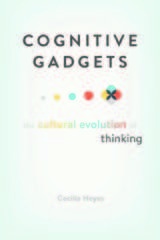 Cognitive Gadgets: The Cultural Evolution of Thinking
Cecilia Heyes
Harvard University Press, 2018 “This is an important book and likely the most thoughtful of the year in the social sciences… Highly recommended, it is likely to prove one of the most thought-provoking books of the year.”—Tyler Cowen, Marginal Revolution
How did human minds become so different from those of other animals? What accounts for our capacity to understand the way the physical world works, to think ourselves into the minds of others, to gossip, read, tell stories about the past, and imagine the future? These questions are not new: they have been debated by philosophers, psychologists, anthropologists, evolutionists, and neurobiologists over the course of centuries. One explanation widely accepted today is that humans have special cognitive instincts. Unlike other living animal species, we are born with complicated mechanisms for reasoning about causation, reading the minds of others, copying behaviors, and using language.
Cecilia Heyes agrees that adult humans have impressive pieces of cognitive equipment. In her framing, however, these cognitive gadgets are not instincts programmed in the genes but are constructed in the course of childhood through social interaction. Cognitive gadgets are products of cultural evolution, rather than genetic evolution. At birth, the minds of human babies are only subtly different from the minds of newborn chimpanzees. We are friendlier, our attention is drawn to different things, and we have a capacity to learn and remember that outstrips the abilities of newborn chimpanzees. Yet when these subtle differences are exposed to culture-soaked human environments, they have enormous effects. They enable us to upload distinctively human ways of thinking from the social world around us.
As Cognitive Gadgets makes clear, from birth our malleable human minds can learn through culture not only what to think but how to think it.
Cognitive Harmony: The Role of Systemic Harmony in the Constitution of Knowledge
Nicholas Rescher
University of Pittsburgh Press, 2005
This novel approach to epistemological discourse explains the complex but crucial role that systematization plays-not just for the organization of what we know, but also for its validation. Cognitive Harmony argues for a new conception of the process philosophers generally call induction.
Relying on the root definition of harmony, a coherent unification of component parts (systemic integrity) in such a way that the final object can successfully accomplish what it was meant to do (evaluative positivity), Rescher discusses the role of harmony in cognitive contexts, the history of cognitive harmony, and the various features it has in producing human knowledge. The book ends on the issue of philosophy and the sort of harmony required of philosophical systems.
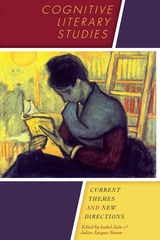 Cognitive Literary Studies: Current Themes and New Directions
Edited by Isabel Jaén and Julien Jacques Simon
University of Texas Press, 2012 In the first decade of the twenty-first century, our understanding of the cognition of literature was transformed by scientific discoveries, such as the mirror neuron system and its role in empathy. Addressing questions such as why we care so deeply about fictional characters, what brain activities are sparked when we read literature, and how literary works and scholarship can inform the cognitive sciences, this book surveys the exciting recent developments in the field of cognitive literary studies and includes contributions from leading scholars in both the humanities and the sciences. Beginning with an overview of the evolution of literary studies, the editors trace the recent shift from poststructuralism and its relativism to a growing interdisciplinary interest in the empirical realm of neuroscience. In illuminating essays that examine the cognitive processes at work when we experience fictional worlds, with findings on the brain’s creativity sites, this collection also explores the impact of literature on self and society, ending with a discussion on the present and future of the psychology of fiction. Contributors include Literature and the Brain author Norman N. Holland, on the neuroscience of metafiction reflected in Don Quixote; clinical psychologist Aaron Mishara on the neurology of self in the hypnagogic (between waking and sleeping) state and its manifestations in Kafka’s stories; and literary scholar Brad Sullivan’s exploration of Romantic poetry as a didactic tool, applying David Hartley’s eighteenth-century theories of sensory experience.
Cognitive Models of Science
Ronald Giere
University of Minnesota Press, 1992 Delineates the emerging impact the cognitive sciences are having on the content and methods of philosophy.
The Cognitive Paradigm
Marc De Mey
University of Chicago Press, 1992 In this study of the cognitive paradigm, De Mey applies the study of computer models of human perception to the philosophy and sociology of science.
"A most stimulating, and intellectually delightful book."—John Goldsmith
"[De Mey] has brought together an unusually wide range of material, and suggested some interesting lines of thought, about what should be an important application of cognitive science: The understanding of science itself."—Cognition and Brain Theory
"It ought to be on the shelf of every teacher and researcher in the field and on the reading list of any student or practitioner seriously interested in how those they serve are likely to set about knowing."—ISIS
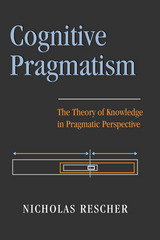 Cognitive Pragmatism: The Theory of Knowledge in Pragmatic Perspective
Nicholas Rescher
University of Pittsburgh Press, 2001
Nicholas Rescher tackles the major questions of philosophical inquiry, pondering the nature of truth and existence. In the authoritative voice and calculated manner that we’ve come to expect from this distinguished philosopher, Rescher argues that the development of knowledge is a practice, pursued by humans because we have a need for its products. This pragmatic approach satisfies our innate urge as humans to make sense of our surroundings.
Taking his discussion down to the level of particular details, and addressing such topics as inductive validation, hypostatization fallacies, and counterfactual reasoning, Rescher abandons abstract generalities in favor of concrete specifics. For example, philosophers usually insist that to reason logically from a counterfactual, we must imagine a possible world in which the statement is fact. But Rescher argues that there’s no need to attempt to accept the facts of a world outside our cognition in order to reason from them. He shows us how we can use our own natural system of prioritizing, our own understanding of the fundamental, to resolve the inconsistencies in such statements as, “If the Eiffel Tower were in Manhattan, then it would be in New York State.”
In using dozens of real-world examples such as these, and in arguing in his characteristically succinct style, Rescher casts light on a wide variety of concrete issues in the classical theory of knowledge, and reassures us along the way that the inherent limitations on our knowledge are no cause for distress. In pragmatic theory and inquiry, we must accept that the best we can do is good enough, because we only have a certain (albeit large) set of tools and conceptualizations available to us.
A unique synthesis, this endeavor into pragmatic epistemology will be of interest to scholars and students of philosophy and cognitive science.
Cognitive Radio Engineering
Charles W. Bostian
The Institution of Engineering and Technology, 2016 A cognitive radio is a transceiver which is aware of its environment, its own technical capabilities and limitations, and those of the radios with which it may communicate; is capable of acting on that awareness and past experience to configure itself in a way that optimizes its performance; and is capable of learning from experience. In a real sense, a cognitive radio is an intelligent communications system that designs and redesigns itself in real time.
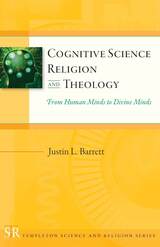 Cognitive Science, Religion, and Theology: From Human Minds to Divine Minds
Justin L. Barrett
Templeton Press, 2011 Cognitive Science, Religion, and Theology is the eighth title published in the Templeton Science and Religion Series, in which scientists from a wide range of fields distill their experience and knowledge into brief tours of their respective specialties. In this volume, well-known cognitive scientist Justin L. Barrett offers an accessible overview of this interdisciplinary field, reviews key findings in this area, and discusses the implications of these findings for religious thought and practice. Cognitive science is the interdisciplinary study of minds and mental activity, and as such, it addresses a fundamental feature of what it is to be human. Further, as religious traditions concern ideas and beliefs about the nature of humans, the nature of the world, and the nature of the divine, cognitive science can contribute directly and indirectly to these theological concerns. Barrett shows how direct contributions come from the growing area called cognitive science of religion (CSR), which investigates how human cognitive systems inform and constrain religious thought, experience, and expression. CSR attempts to answer questions such as: Why do humans tend to be religious? And why are specific ideas (e.g., the possibility of an afterlife) so cross-culturally recurrent? Barrett also covers the indirect implications that cognitive science has for theology, such as human similarities and differences with the animal world, freedom and determinism, and the relationship between minds and bodies. Cognitive Science, Religion, and Theology critically reviews the research on these fascinating questions and discusses the many implications that arise from them. In addition, this short volume also offers suggestions for future research, making it ideal not only for those looking for an overview of the field thus far but also for those seeking a glimpse of where the field might be going in the future.
Cognitive Sensing Technologies and Applications
G.R. Sinha
The Institution of Engineering and Technology, 2023 Cognitive sensing systems combined with IoTs and smart technologies are used in countless applications such as industrial robotics, computer-aided diagnosis, brain-computer interface (BCI), human-computer interaction (HCI), telemedicine, driverless cars and smart energy systems.
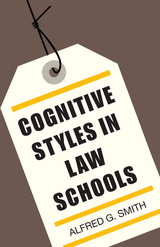 Cognitive Styles in Law Schools
By Alfred G. Smith
University of Texas Press, 1979 People differ in their cognitive styles—their ways of getting and using information to solve problems and make decisions. Alfred G. Smith and his associates studied these differences in a selected group of over 800 students at a score of law schools throughout the United States. Two major cognitive styles were identified: that of the monopath, who follows a single route of established principles and procedures, and that of the polypath, who takes many routes, as circumstances suggest. A battery of both original and standard tests was administered to both law students and their professors to investigate differences in cognitive style and their relationships to self-image, anxiety, and academic achievement. This also revealed differences in prevailing styles at different schools. The results will be of special interest to readers concerned with legal education, to psychologists, and to behavioral scientists. The research format developed here will serve equally well for raising significant questions about the professions of medicine, education, social work, and others in which cognitive and communication styles play a central role in determining outcomes.
 The Coherence of Kant's Doctrine of Freedom
Bernard Carnois
University of Chicago Press, 1987 The term freedom appears in many contexts in Kant's work, ranging from the cosmological to the moral to the theological. Can the diverse meanings Kant gave to the term be ordered systematically? To ask that question is to test the consistency and coherence of Kant's thought in its entirety.
Widely praised when first published in France, The Coherence of Kant's Doctrine of Freedom articulates and interrelates the disparate senses of freedom in Kant's work. Bernard Carnois organizes all Kant's usages into a logical "grammar," isolating and defining the individual meanings and pointing out their implications and limits. In a first step, he shows how Kant's notion of intelligible character makes possible a synthesis of transcendental freedom, as a problematic concept of theoretical reason, and practical freedom, as a fact demonstrated by experience. He then develops the concept of freedom under the rubric of the will's autonomy in the context of the moral law. And finally, Carnois persistently explores the role of negativity in Kant's idea of freedom. For within the magisterial coherence of the system the imperfection of human finitude is inscribed. This introduces the "history" of our freedom—a freedom which posits itself, but then inevitably denies itself, even while preserving the possibility of its regeneration.
The only work in English to consider in detail all of Kant's writings on freedom, this book also introduces French Kant scholars whose works have often been unavailable to English-speaking readers. As both an interpretation of Kant and a trenchant analysis of the relationship between ethical commitments and metaphysical assumptions, it will be a useful addition to moral, religious, and political philosophy as well as to Kant scholarship.
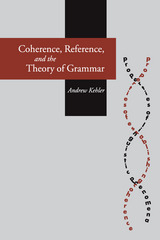 Coherence, Reference, and the Theory of Grammar
Andrew Kehler
CSLI, 2001 A natural language discourse is more than an arbitrary sequence of utterances; a discourse exhibits coherence. Despite its centrality to discourse interpretation, coherence rarely plays a role in theories of linguistic phenomena that apply across utterances.
In this book, Andrew Kehler provides an analysis of coherence relationships between utterances that is rooted in three types of 'connection among ideas' first articulated by the philosopher David Hume—Resemblance, Cause or Effect, and Contiguity. Kehler then shows how these relationships affect the distribution of a variety of linguistic phenomena, including verb phrase ellipsis, gapping, extraction from coordinate structures, tense, and pronominal reference. In each of these areas, Kehler demonstrates how the constraints imposed by linguistic form interact with those imposed by the process of establishing coherence to explain data that has eluded previous analyses. his book will be of interest to researchers from the broad spectrum of disciplines from which discourse is studied, as well as those working in syntax, semantics, computational linguistics, psycholinguistics, and philosophy of language.
 A Coin in Nine Hands: A Novel
Marguerite Yourcenar
University of Chicago Press, 1994 During the space of a day in Rome in 1933, a ten-lira coin passes through the hands of nine people—including an aging artist, a prostitute, and a would-be assassin of Mussolini. The coin becomes the symbol of contact between human beings, each lost in private passions and nearly impenetrable solitude.
"A Coin in Nine Hands has . . . passages that move close to poetry and a story that belongs in both literature and history."—Doris Grumbach, Los Angeles Times Book Review
"What lingers at the end of A Coin in Nine Hands is the shadowiness and puppetlike vagueness of the Dictator, and the compelling specificity of the so-called 'common people' revolving all around him."—Anne Tyler, The New Republic
"Within a few pages we have met half the major characters in this haunting, brilliantly constructed novel. . . . The studied perfection, the structural intricacy and brevity remind one of Camus. Yet by comparison, Yourcenar's prose is lavish, emotional and imagistic."—Cynthia King, Houston Post
"Transcends its specific time and place to become a portrait of vividly delineated characters caught in the vise of a tragically familiar political situation."—Publisher's Weekly
Best known as the author of Memoirs of Hadrian and The Abyss, Marguerite Yourcenar (1903-87) achieved countless literary honors and was the first woman ever elected to the Académie Française.
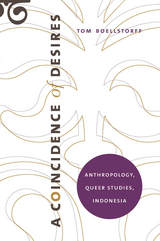 A Coincidence of Desires: Anthropology, Queer Studies, Indonesia
Tom Boellstorff
Duke University Press, 2007 In A Coincidence of Desires, Tom Boellstorff considers how interdisciplinary collaboration between anthropology and queer studies might enrich both fields. For more than a decade he has visited Indonesia, both as an anthropologist exploring gender and sexuality and as an activist involved in HIV prevention work. Drawing on these experiences, he provides several in-depth case studies, primarily concerning the lives of Indonesian men who term themselves gay (an Indonesian-language word that overlaps with, but does not correspond exactly to, the English word “gay”). These case studies put interdisciplinary research approaches into practice. They are preceded and followed by theoretical meditations on the most productive forms that collaborations between queer studies and anthropology might take. Boellstorff uses theories of time to ask how a model of “coincidence” might open up new possibilities for cooperation between the two disciplines. He also juxtaposes his own work with other scholars’ studies of Indonesia, Thailand, the Philippines, Malaysia, and Singapore to compare queer sexualities across Southeast Asia. In doing so, he asks how comparison might be understood as a queer project and how queerness might be understood as comparative. The case studies contained in A Coincidence of Desires speak to questions about the relation of sexualities to nationalism, religion, and globalization. They include an examination of zines published by gay Indonesians; an analysis of bahasa gay—a slang spoken by gay Indonesians that is increasingly appropriated in Indonesian popular culture; and an exploration of the place of warias (roughly, “male-to-female transvestites”) within Indonesian society. Boellstorff also considers the tension between Islam and sexuality in gay Indonesians’ lives and a series of incidents in which groups of men, identified with Islamic fundamentalism, violently attacked gatherings of gay men. Collectively, these studies insist on the primacy of empirical investigation to any queer studies project that wishes to speak to the specificities of lived experience.
 Coining for Capital: Movies, Marketing, and the Transformation of Childhood
Kapur, Jyotsna
Rutgers University Press, 2005 "This book is a welcome addition to the literature on children and the media, and a most stimulating application of social theory to questions of the child in contemporary film and consumer culture."—Ellen Seiter, author of The Internet Playground: Children's Access, Entertainment and Mis-Education Since the 1980s, a peculiar paradox has evolved in American film. Hollywood’s children have grown up, and the adults are looking and behaving more and more like children. In popular films such as Harry Potter, Toy Story, Pocahantas, Home Alone, and Jumanji, it is the children who are clever, savvy, and self-sufficient while the adults are often portrayed as bumbling and ineffective. Is this transformation of children into "little adults" an invention of Hollywood or a product of changing cultural definitions more broadly? In Coining for Capital, Jyostna Kapur explores the evolution of the concept of childhood from its portrayal in the eighteenth century as a pure, innocent, and idyllic state—the opposite of adulthood—to its expression today as a mere variation of adulthood, complete with characteristics of sophistication, temptation, and corruption. Kapur argues that this change in definition is not a media effect, but rather a structural feature of a deeply consumer-driven society. Providing a new and timely perspective on the current widespread alarm over the loss of childhood, Coining for Capital concludes that our present moment is in fact one of hope and despair. As children are fortunately shedding false definitions of proscribed innocence both in film and in life, they must now also learn to navigate a deeply inequitable, antagonistic, and consumer-driven society of which they are both a part and a target.
Coins and Costume in Late Antiquity
Jutta-Annette Bruhn
Harvard University Press, 1993 This catalogue focuses on numismatic gold jewelry, from pendants set with coins and medallions to stamped pseudo-medallions, or a combination of both. Special attention is given to the technical issues of mounting techniques.
Coins from Seleucia on the Tigris
Robert Harbold McDowell
University of Michigan Press, 1935 Coins from Seleucia on the Tigris features 30,000 coins excavated at Seleucia-on-the-Tigris in the 1927–32 excavations under the auspices of the University of Michigan, the Toledo Museum of Art, and the Cleveland Museum of Art. Half of the included coins came from definite provinces; photographs were taken by Michigan’s George Swain, after treatment of many coins by the American Numismatic Society’s ET Newell.
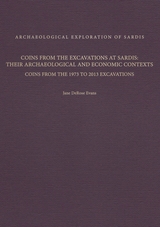 Coins from the Excavations at Sardis: Their Archaeological and Economic Contexts: Coins from the 1973 to 2013 Excavations
Jane DeRose Evans
Harvard University Press, 2018 Sardis, capital city of the Lydian and Persian kings, stronghold of the Seleukid kings, metropolis of Roman Asia, and episcopal see in the Byzantine period, has been the focus of archaeological research since the early 1900s. This monograph focuses on the over 8,000 coins minted in the Lydian, Hellenistic, Roman, and Byzantine periods that were excavated between 1973 and 2013 in the Harvard-Cornell Expedition.
The book places coins within eastern Mediterranean historical, cultural, and economic contexts, in order to better understand the monetized economy of Sardis. It adds important archaeological context to shed light on the uses of coins and the nature of the deposits, with attention paid to the problems of monetary circulation and chronological development of the deposits, especially in the Late Roman period. Statistical analyses, including a new method of analyzing the deposits, help define the nature and chronological horizons of the strata. A catalog of the coins concludes the main body of the study, followed by appendices on countermarks, monograms, and statistical analyses.
 Coins, Trade, and the State: Economic Growth in Early Medieval Japan
Ethan Isaac Segal
Harvard University Press, 2011 Framed by the decline of the Heian aristocracy in the late 1100s and the rise of the Tokugawa shogunate in the early 1600s, Japan’s medieval era was a chaotic period of diffuse political power and frequent military strife. This instability prevented central authorities from regulating trade, issuing currency, enforcing contracts, or guaranteeing property rights. But the lack of a strong central government did not inhibit economic growth. Rather, it created opportunities for a wider spectrum of society to participate in trade, markets, and monetization.
Peripheral elites—including merchants, warriors, rural estate managers, and religious leaders—devised new ways to circumvent older forms of exchange by importing Chinese currency, trading in local markets, and building an effective system of long-distance money remittance. Over time, the central government recognized the futility of trying to stifle these developments, and by the sixteenth century it asserted greater control over monetary matters throughout the realm.
Drawing upon diaries, tax ledgers, temple records, and government decrees, Ethan Isaac Segal chronicles how the circulation of copper currency and the expansion of trade led to the start of a market-centered economy and laid the groundwork for Japan’s transformation into an early modern society.
 Coire Sois, The Cauldron of Knowledge: A Companion to Early Irish Saga
Tomás Ó Cathasaigh
University of Notre Dame Press, 2014
Coire Sois, The Cauldron of Knowledge: A Companion to Early Irish Saga offers thirty-one previously published essays by Tomás Ó Cathasaigh, which together constitute a magisterial survey of early Irish narrative literature in the vernacular.
Ó Cathasaigh has been called “the father of early Irish literary criticism,” with writings among the most influential in the field. He pioneered the analysis of the classic early Irish tales as literary texts, a breakthrough at a time when they were valued mainly as repositories of grammatical forms, historical data, and mythological debris. All four of the Mythological, Ulster, King, and Finn Cycles are represented here in readings of richness, complexity, and sophistication, supported by absolute philological rigor and yet easy for the non-specialist to follow. The book covers key terms, important characters, recurring themes, rhetorical strategies, and the narrative logic of this literature. It also surveys the work of the many others whose explorations were launched by Ó Cathasaigh's first encounters with the literature.
As the most authoritative single volume on the essential texts and themes of early Irish saga, this collection will be an indispensable resource for established scholars, and an ideal introduction for newcomers to one of the richest and most under-studied literatures of medieval Europe.
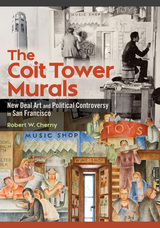 The Coit Tower Murals: New Deal Art and Political Controversy in San Francisco
Robert W. Cherny
University of Illinois Press, 2024 Created in 1934, the Coit Tower murals were sponsored by the Public Works of Art Project (PWAP), the first of the New Deal art programs. Twenty-five master artists and their assistants worked there, most of them in buon fresco, Nearly all of them drew upon the palette and style of Diego Rivera. The project boosted the careers of Victor Arnautoff, Lucien Labaudt, Bernard Zakheim, and others, but Communist symbols in a few murals sparked the first of many national controversies over New Deal art. Sixty full-color photographs illustrate Robert Cherny’s history of the murals from their conception and completion through their evolution into a beloved San Francisco landmark. Cherny traces and critiques the treatment of the murals by art critics and historians. He also probes the legacies of Coit Tower and the PWAP before surveying San Francisco’s recent controversies over New Deal murals. An engaging account of an artistic landmark, The Coit Tower Murals tells the full story behind a public art masterpiece.
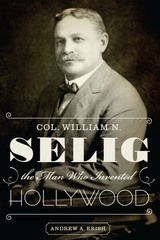 Col. William N. Selig, the Man Who Invented Hollywood
By Andrew A. Erish
University of Texas Press, 2012 All histories of Hollywood are wrong. Why? Two words: Colonel Selig. This early pioneer laid the foundation for the movie industry that we know today. Active from 1896 to 1938, William N. Selig was responsible for an amazing series of firsts, including the first two-reel narrative film and the first two-hour narrative feature made in America; the first American movie serial with cliffhanger endings; the first westerns filmed in the West with real cowboys and Indians; the creation of the jungle-adventure genre; the first horror film in America; the first successful American newsreel (made in partnership with William Randolph Hearst); and the first permanent film studio in Los Angeles. Selig was also among the first to cultivate extensive international exhibition of American films, which created a worldwide audience and contributed to American domination of the medium. In this book, Andrew Erish delves into the virtually untouched Selig archive at the Academy of Motion Picture Arts and Sciences Library to tell the fascinating story of this unjustly forgotten film pioneer. He traces Selig’s career from his early work as a traveling magician in the Midwest, to his founding of the first movie studio in Los Angeles in 1909, to his landmark series of innovations that still influence the film industry. As Erish recounts the many accomplishments of the man who first recognized that Southern California is the perfect place for moviemaking, he convincingly demonstrates that while others have been credited with inventing Hollywood, Colonel Selig is actually the one who most deserves that honor.
Colbert, Mercantilism, and the French Quest for Asian Trade
Glenn J. Ames
Northern Illinois University Press, 2016 This examination of French trade with Asia analyzes France’s attempt to establish a mercantile empire in the East by breaking into the lucrative market of the Indian Ocean. Between 1664 and 1674, France advanced a vigorous strategy of commerce and colonization. It founded the powerful East India Company and constructed a large royal fleet as the principal instrument for entrenching French power in Asia. Drawing on archival sources, Ames offers a new interpretation of France’s mercantilism in the context of the rise of the world market economy of the early modern period. This study sheds new light on the reign of Louis XIV, the mercantilist theories of Colbert, the origins of the Dutch War, and the Asian trading empires of the French, Dutch, English, and Portuguese during the late seventeenth century.
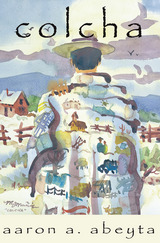 Colcha
Aaron Abeyta
University Press of Colorado, 2001 Winner of a 2002 American Book Award
Winner of the 2002 Colorado Book Award in Poetry "The natural voice at work in the poetry sings of one human life as if it were our own. I loved listening."
—Rita Kiefer, author of Nesting Doll "This just may be one of the best books of poetry I have ever read. . . . This is the kind of writing that give poetry a good name."
—Mike Nobles, Tulsa World "Abeyta's poetry amazingly captures this struggle with poems that are simultaneously tortured and thankful, celebratory and melancholy, earthly and ethereal. . . . Poet Abeyta beautifully captures the hardships of living in rural Colorado."
—Blue Sky Quarterly "Abeyta writes about family, friends, and famous (and infamous) locals. His approach is intimate and daring while avoiding the self-absorbed, coffee-house clichés we fear. Yes, death plays a role in the connection of community and the land, but these poems are sly rather than dark, modulated rather than graphic, sweet rather than maudlin."
—Wayne Sheldrake, Colorado Central Magazine In Colcha, Aaron Abeyta blends the contrasting rhythms of the English and Spanish languages, finding music in a simple yet memorable lyricism without losing the complexity and mystery of personal experience. His forty-two poems take the reader on a journey through a contemplative personal history that explores communal, political and societal issues as well as the individual experiences of family and friends. With his distinctive voice, Abeyta invites people of all cultures to enter his poems by exploring the essence of humanity as expressed by his particular Hispanic culture and heritage. Marked by intimacy and deep sentiment, Colcha not only acquaints us with the land of Abeyta's people, but also reveals the individuals from his life and family history in the most colorful and delicate detail. We meet his abuelitos (grandparents) in poems such as "colcha" and "3515 Wyandot," and hear of their connection to the tierra and its seasons, their labor and its bounty presented both viscerally and lovingly. We also meet the nameless people: the rancheros and the herders and the farmers, the locals in their pick-up trucks, and the women who make the tortillas. Abeyta's reflections on the plight, loves, joys, failures, and exploitation of the common person in such poems as "cuando se secan las acequias," "untitled (verde)," and "cinco de mayo" belong to the literary heritage of such poets as Pablo Neruda, Federico Garcia Lorca, and Walt Whitman. Colcha is not just for those who love poetry, but for all people who wish to be moved by the music of language and, while listening, perhaps to gain some personal insight into their own lives and cultural traditions.
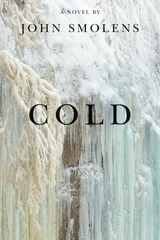 Cold
John Smolens
Michigan State University Press, 2017 Internationally acclaimed, Cold takes us deep into a harsh, frozen world, where love, greed, and the promise of a second chance compel six people toward a chilling and inevitable reckoning.
In the frozen reaches of Michigan’s Upper Peninsula, fierce winter storms hit without warning. The white opacity of one such blizzard allows Norman Haas to walk away from his prison work detail. Dangerously close to freezing to death, Norman is given shelter by Liesl Tiomenen, a middle-aged woman who lives in a house she and her late husband built in the woods. Armed with a rifle, she tries to turn him in, but when they set out on snowshoes, she suffers a fall, allowing him to flee again. Thus begins Norman’s journey back to his past, back to the woman he loved who betrayed him, back to the brother who helped put him away, back to a dangerous web of family allegiances, deceptions, and intrigue.
After finding Liesl injured and abandoned in the woods, Yellow Dog Township’s sole full-time law enforcement officer Del Maki pursues Norman through a storm of mythic proportions.
Cold as Thunder
Jerry Apps
University of Wisconsin Press, 2018 Since the Eagle Party took power in the United States, all schools and public utilities have been privatized, churches and libraries closed, and independent news media shut down. Drones buzz overhead in constant surveillance of the populace, and the open internet has been replaced by the network of the New Society Corporation. Environmental degradation and unchecked climate change have brought raging wildfires to the Western states and disastrous flooding to Eastern coastal regions.
In the Midwest, a massive storm sends Lake Michigan surging over the Door County peninsula, and thousands of refugees flee inland. In the midst of this apocalypse, a resourceful band of Wisconsin sixty-somethings calling themselves the Oldsters lays secret plans to fight the ruling regime's propaganda and show people how to think for themselves.
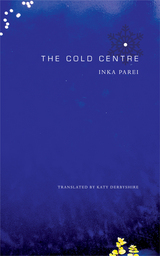 The Cold Centre
Inka Parei
Seagull Books, 2014 Inka Parei’s novel The Cold Centre begins with a man who receives a startling call from his ex-wife. She’s in the hospital, awaiting a cancer diagnosis. His mind races as he suddenly realizes he must find out whether she was contaminated by fallout from the 1986 Chernobyl nuclear disaster. Quickly returning to the city, he tries to reconstruct the events of a few days so many years ago, and he revisits and questions his own memories of working in the chilling “cold centre”—the air conditioning plant for the East German party newspaper. Did she come in contact with a contaminated truck from the Ukraine? Was he a cog at the heart of the system, failing to prevent a tragic accident? Can he find out what happened before it’s too late? He soon begins to lose control over his days in Berlin, entering into a desperate search for orientation over a fracture in his own life—one he has never gotten over.
Written in Parei’s characteristically precise prose, The Cold Centre is a timely reminder of how we react to accidents—nuclear and otherwise— and a bleakly realistic description of East Berlin before the Wall fell. Its tight and dizzying structure keeps readers on the edge of their seats as the narrator tries to solve his mystery.
Cold Comfort
Maggie Anderson
University of Pittsburgh Press, 1986 <I>Cold Comfort</I> is a book of poems written out of deep affection and concern for the world in a dangerous time. An urbane stylist, Anderson characteristically focuses on rural and small-town America, where the events of personal history intersect those of the larger world.
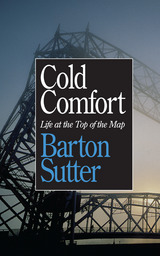 Cold Comfort: Life at the Top of the Map
Barton Sutter
University of Minnesota Press, 2000 A whimsical look at the pleasures and challenges of living in the far north-now in paperback! A whimsical look at the pleasures and challenges of living in the far north-now in paperback! "Sutter knows Duluth and the hinterlands to the North the way Garrison Keillor knows Lake Wobegon and the prairies. With a nimble wit and a roving eye for detail, Sutter goes beneath the veneer of the North Country to expose its attraction, its quirks, and its characters. There isn’t a clinker in the collection, and even if you’ve lived your entire life in Duluth or the North Country, you’ll see your home place with new insight after reading Cold Comfort." Duluth News-Tribune"Mostly whimsical, sometimes meditative, but most often warmhearted, these essays explore Lake Superior, its neighboring rivers and streams, duck hunting, cross-country skiing, bridges, cider-pressing parties, and camping out in the family car. Sutter’s prose is clean, straightforward, and sometimes mirthful." Chicago New City "An oddly brilliant and lovely little book. . . . Resonant, evocative, and splendidly written." Jim HarrisonTemperatures that dive to forty degrees below zero are only part of life in northern Minnesota, according to award-winning writer Barton Sutter. Cold Comfort is his temperamental tribute to the city of Duluth, Minnesota, where bears wander the streets and canoe racks are standard equipment. Winner of a 1998 Northeast Minnesota Book AwardWinner of a 1998 Minnesota Book Award for Creative Nonfiction
Cold Deck: A Novel
H. Lee Barnes
University of Nevada Press, 2013 Jude is a Las Vegas casino dealer who barely survived the deadly MGM fire in 1980. More than two decades later, he’s still dealing, a tired, middle-aged man, divorced, struggling with debt, and trying to be a good father to his children. Then he loses his job and his car is totaled in an accident. When an attractive woman friend offers to help him get another job, Jude is happy to go along. Gradually, he realizes that his new job is part of an elaborate scheme to cheat a casino and that his own fate and that of his children depend on his finding the courage and ingenuity to extricate himself.
Cold Deck is the exciting story of an ordinary man who finds himself in extraordinary circumstances. Moving from Las Vegas’s mean streets to the insider’s world of casino workers, this is a story of survival set against the greed, fears, and glitz of Sin City.
Cold Flashes: Literary Snapshots of Alaska
Edited by Michael Engelhard
University of Alaska Press, 2010 As the old adage goes, "if you can't say it in a few pages, you won't in a hundred." The selections in Cold Flashes—very short prose and black-and-white photographs—embody perfectly this transparency, thrift, and restraint. Found here are highly polished micro-narratives, both fiction and nonfiction, and a series of eloquent and artistic halftones that capture their sizeable subjects in a nutshell. By minimizing the exposition, the selections stimulate the imagination to reflect on the rich diversity of people and places that make up Alaska. To be savored piecemeal at coffee shops, on the bus, or while waiting in line, the images and text in Cold Flashes will resonate with both the reader and each other, fusing into something profound yet elusive.
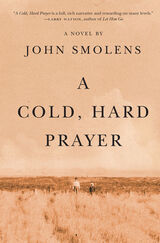 A Cold, Hard Prayer
John Smolens
Michigan State University Press, 2023 In 1924, an orphan train passes through the Midwest, and two teenagers, seeking a new life, find nothing but hardship when taken in to live on a farm in Michigan. Mercy, a teenage girl of mixed race, and a boy nicknamed Rope, who lost fingers in a factory accident, become virtual prisoners of Harlan and Estelle Nau, whose children died during the Spanish flu epidemic. After facing abuse, Mercy and Rope flee, making an arduous journey into sparsely populated northern Michigan, where Mercy believes she will find her aunt. After Harlan is found murdered on his farm, police captain Jim Kincaid pursues Mercy and Rope to the cold, barren villages on the Mackinac Straits, but his efforts are complicated by the reemergent Ku Klux Klan, which has formed a coalition with the police deputy Milt Waters and the Dingley brothers, who run a local bootleg operation. Resolute and intrepid, Mercy and Rope develop a bond of mutual trust that helps them navigate a stark American landscape shaped by prejudice, hypocrisy, and fear.
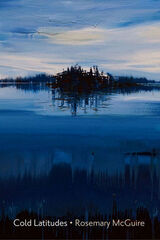 Cold Latitudes
Rosemary McGuire
University of Alaska Press, 2021 Cold Latitudes is a memoir in essay form based on years of working in the Alaska Arctic and Antarctica. The author was privileged to see first-hand worlds that few will ever know, while participating in cutting-edge research at high latitudes. From solo voyages down the Yukon and part of the Northwest Passage, to working with humpback whales in the Southern Ocean, to chilling encounters with polar bears, Rosemary McGuire’s stories are told in spare, graceful prose. It is her friendships with local people, and with scientific researchers, that form the core of her experiences. Through these local contacts and traditional knowledge, she learns humility and a sense of wonder at the natural world, while at the same time coming to appreciate the gritty determination of the field researchers whose work she shares. Throughout, she examines human relationships with wilderness, and our growing effects on a fragile planet. And so, as she writes, “In the end, this is a love story for a threatened place.”
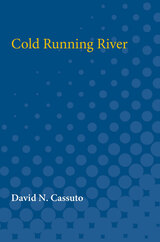 Cold Running River
David N. Cassuto
University of Michigan Press, 1994 At a mere glance, Cold Running River has obvious regional and environmental appeal, but it goes far beyond those interests. Besides the fact that the Pere Marquette is a well-known, National Scenic River, and besides the fact that ecosystem management is a monumentally important and far-reaching topic, this book happens to read like a cold river runs: fast, refreshing, exuberant. It is special because David Cassuto has a beautiful way with the English language. Only he can make a chapter on lamprey eel infestation a gripping read. His style is so affecting, so warm, so "Norman Macleany"—you might be sitting on the river's bank, hearing the locals tell their tales of the river's history.That's what this book is: the river's history. It follows the miraculous course of the Pere Marquette: from its tumultuous glacial birth; to its devastation in the nineteenth century by unsustainable logging practices; to its recovery due to benign neglect. Cassuto approaches the river as both microcosm and metaphor; the controversies surrounding it speak to environmental and human dilemmas the world over.
 Cold Spell
Deb Vanasse
University of Alaska Press, 2014 With precise and evocative prose, Cold Spell tells the story of a mother who risks everything to start over and a daughter whose longings threaten to undo them both.
From the moment Ruth Sanders rips a glossy photo of a glacier from a magazine, she believes her fate is intertwined with the ice. Her unsettling fascination bewilders her daughter, sixteen-year-old Sylvie, still shaken by her father’s leaving. When Ruth uproots Sylvie and her sister from their small Midwestern town to follow her growing obsession—and a man—to Alaska, they soon find themselves entangled with an unfamiliar wilderness, a divided community, and one another. As passions cross and braid, the bond between mother and daughter threatens to erode from the pressures of icy compulsion and exposed secrets.
Inspired by her own experience arriving by bush plane to live on the Alaska tundra, Deb Vanasse vividly captures the reality of life in Alaska and the emotional impact of loving a remote and unforgiving land.
 Cold Tyranny and the Demonic North of Early Modern England
Anne Cotterill
Amsterdam University Press, 2024 The seventeenth and early eighteenth centuries were among the worst years of the Little Ice Age. This volume attends to English texts from this period to trace associations between wintry physical landscapes and an icy inner landscape of human cruelty and tyranny whose rigors promote the ultimate chill of rigor mortis. Sailors seeking a polar route to the East brought terrifying reports of northern icescapes, long popularly linked with the devil. Simultaneously, concerns about increasingly cold winters at home in Britain overlapped with increased scrutiny of kingship and the church and fear of tyranny from both. Such fears were reflected in ongoing struggles between king and Parliament during the period, leading to revolution and war. The binding power of ice and the power of northern winters to deface, kill, and bury life suggested the Fall’s human parallel to winter: cold-hearted humans as tyrannical winters who deal in death.
 The Cold War and After: Capitalism, Revolution and Superpower Politics
Richard Saull
Pluto Press, 2007 The Cold War is often presented as an international power struggle between the Soviet Union and the US. Richard Saull challenges this assumption. He broadens our understanding of the defining political conflict of the twentieth-century by stressing the social and ideological differences of the superpowers and how these differences conditioned their international behaviour.
Saull argues that US-Soviet antagonism was part of a wider conflict between capitalism and communism involving states and social forces other than the superpowers. The US was committed to containing revolutionary and communist movements that emerged out of uneven capitalist development.
In highlighting the socio-economic and ideological dimensions of the Cold War, Saull not only provides a richer history of the Cold War than mainstream approaches, but is also able to explain why revolutionary domestic transformations caused international crises. Tracing the origins of new resistance to American global power, Saull's book provides an ideal alternative perspective on the Cold War and its end.
Cold War and Decolonisation: Australia's Policy towards Britain's End of Empire in Southeast Asia
Andrea Benvenuti
National University of Singapore Press, 2017 In this book, Andrea Benvenuti discusses the development of Australia’s foreign and defense policies toward Malaya and Singapore in light of the redefinition of Britain’s imperial role in Southeast Asia and the formation of new postcolonial states. Benvenuti sheds light on the impact of Britain on Australia’s political and strategic interests in Southeast Asia during the Cold War. It will be of interest to historians of Australia’s foreign relations, Southeast Asia, and the British Empire and decolonization.
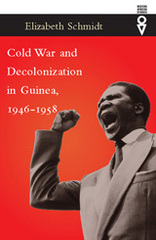 Cold War and Decolonization in Guinea, 1946–1958
Elizabeth Schmidt
Ohio University Press, 2007 In September 1958, Guinea claimed its independence, rejecting a constitution that would have relegated it to junior partnership in the French Community. In all the French empire, Guinea was the only territory to vote “No.” Orchestrating the “No” vote was the Guinean branch of the Rassemblement Démocratique Africain (RDA), an alliance of political parties with affiliates in French West and Equatorial Africa and the United Nations trusts of Togo and Cameroon. Although Guinea’s stance vis-à-vis the 1958 constitution has been recognized as unique, until now the historical roots of this phenomenon have not been adequately explained. Clearly written and free of jargon, Cold War and Decolonization in Guinea argues that Guinea’s vote for independence was the culmination of a decade-long struggle between local militants and political leaders for control of the political agenda. Since 1950, when RDA representatives in the French parliament severed their ties to the French Communist Party, conservative elements had dominated the RDA. In Guinea, local cadres had opposed the break. Victimized by the administration and sidelined by their own leaders, they quietly rebuilt the party from the base. Leftist militants, their voices muted throughout most of the decade, gained preeminence in 1958, when trade unionists, students, the party’s women’s and youth wings, and other grassroots actors pushed the Guinean RDA to endorse a “No” vote. Thus, Guinea’s rejection of the proposed constitution in favor of immediate independence was not an isolated aberration. Rather, it was the outcome of years of political mobilization by activists who, despite Cold War repression, ultimately pushed the Guinean RDA to the left. The significance of this highly original book, based on previously unexamined archival records and oral interviews with grassroots activists, extends far beyond its primary subject. In illuminating the Guinean case, Elizabeth Schmidt helps us understand the dynamics of decolonization and its legacy for postindependence nation-building in many parts of the developing world. Examining Guinean history from the bottom up, Schmidt considers local politics within the larger context of the Cold War, making her book suitable for courses in African history and politics, diplomatic history, and Cold War history.
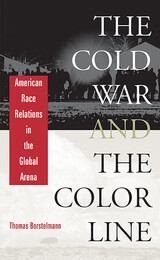 The Cold War and the Color Line: American Race Relations in the Global Arena
Thomas Borstelmann
Harvard University Press, 2003 After World War II the United States faced two preeminent challenges: how to administer its responsibilities abroad as the world’s strongest power, and how to manage the rising movement at home for racial justice and civil rights. The effort to contain the growing influence of the Soviet Union resulted in the Cold War, a conflict that emphasized the American commitment to freedom. The absence of that freedom for nonwhite American citizens confronted the nation’s leaders with an embarrassing contradiction.
Racial discrimination after 1945 was a foreign as well as a domestic problem. World War II opened the door to both the U.S. civil rights movement and the struggle of Asians and Africans abroad for independence from colonial rule. America’s closest allies against the Soviet Union, however, were colonial powers whose interests had to be balanced against those of the emerging independent Third World in a multiracial, anticommunist alliance. At the same time, U.S. racial reform was essential to preserve the domestic consensus needed to sustain the Cold War struggle.
The Cold War and the Color Line is the first comprehensive examination of how the Cold War intersected with the final destruction of global white supremacy. Thomas Borstelmann pays close attention to the two Souths—Southern Africa and the American South—as the primary sites of white authority’s last stand. He reveals America’s efforts to contain the racial polarization that threatened to unravel the anticommunist western alliance. In so doing, he recasts the history of American race relations in its true international context, one that is meaningful and relevant for our own era of globalization.
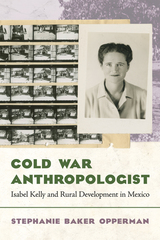 Cold War Anthropologist: Isabel Kelly and Rural Development in Mexico
Stephanie Baker Opperman
University of Arizona Press, 2024 As an archaeologist, anthropologist, scholar, educator, and program evaluator for the U.S. State Department during the early Cold War era, Dr. Isabel T. Kelly’s (1906–1983) career presents a distinctive vantage point on the evolving landscape of U.S. foreign policy, Mexican rural welfare initiatives, and the discipline of anthropology. Her trajectory illuminates a shift toward pragmatic, culturally sensitive approaches in technical assistance programs for Mexico’s rural areas, departing from traditional U.S.-centric developmental paradigms.
Kelly’s transition from a prominent archaeologist to a key figure in applied anthropology is meticulously chronicled, unveiling her pivotal role in shaping rural development strategies in Mexico amidst the geopolitical context of the Cold War. Through an extensive examination of her correspondence, archival material, and scholarly output, Kelly’s evolving viewpoints offer profound insights into the intricate dynamics of U.S.-Mexico relations and the challenges encountered by female academics during this era.
Organized chronologically, each chapter of this work delves into distinct facets of Kelly’s international journey, with a particular emphasis on her involvement in cooperative programs aimed at fostering diplomatic relations with Mexico. Through this narrative framework, readers are immersed in a compelling exploration of Kelly’s enduring impact on both the field of anthropology and the realm of international diplomacy.
This book is indispensable for historians, anthropologists, and individuals intrigued by the nuanced complexities of Cold War politics, presenting pioneering research at the intersection of history and anthropology. Opperman skillfully brings to light the previously untold narratives of Isabel Kelly, unveiling her influence on mid-twentieth-century Mexico.
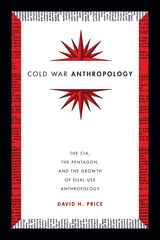 Cold War Anthropology: The CIA, the Pentagon, and the Growth of Dual Use Anthropology
David H. Price
Duke University Press, 2016 In Cold War Anthropology, David H. Price offers a provocative account of the profound influence that the American security state has had on the field of anthropology since the Second World War. Using a wealth of information unearthed in CIA, FBI, and military records, he maps out the intricate connections between academia and the intelligence community and the strategic use of anthropological research to further the goals of the American military complex. The rise of area studies programs, funded both openly and covertly by government agencies, encouraged anthropologists to produce work that had intellectual value within the field while also shaping global counterinsurgency and development programs that furthered America’s Cold War objectives. Ultimately, the moral issues raised by these activities prompted the American Anthropological Association to establish its first ethics code. Price concludes by comparing Cold War-era anthropology to the anthropological expertise deployed by the military in the post-9/11 era.
 Cold War at 30,000 Feet: The Anglo-American Fight for Aviation Supremacy
Jeffrey A. Engel
Harvard University Press, 2007 In a gripping story of international power and deception, Jeffrey Engel reveals the “special relationship” between the United States and Great Britain in a new and far more competitive light. As allies, they fought communism. As rivals, they locked horns over which would lead the Cold War fight. In the quest for sovereignty and hegemony, one important key was airpower, which created jobs, forged ties with the developing world, and, perhaps most importantly in a nuclear world, ensured military superiority.Only the United States and Britain were capable of supplying the post-war world’s ravenous appetite for aircraft. The Americans hoped to use this dominance as a bludgeon not only against the Soviets and Chinese, but also against any ally that deviated from Washington’s rigid brand of anticommunism. Eager to repair an economy shattered by war and never as committed to unflinching anticommunism as their American allies, the British hoped to sell planes even beyond the Iron Curtain, reaping profits, improving East-West relations, and garnering the strength to withstand American hegemony.Engel traces the bitter fights between these intimate allies from Europe to Latin America to Asia as each sought control over the sale of aircraft and technology throughout the world. The Anglo–American competition for aviation supremacy affected the global balance of power and the fates of developing nations such as India, Pakistan, and China. But without aviation, Engel argues, Britain would never have had the strength to function as a brake upon American power, the way trusted allies should.
Cold War Broadcasting: Impact on the Soviet Union and Eastern Europe
R. Eugene Parta
Central European University Press, 2010 The book examines the role of Western broadcasting to the Soviet Union and Eastern Europe during the Cold War, with a focus on Radio Free Europe and Radio Liberty. It includes chapters by radio veterans and by scholars who have conducted research on the subject in once-secret Soviet bloc archives and in Western records. It also contains a selection of translated documents from formerly secret Soviet and East European archives, most of them published here for the first time.
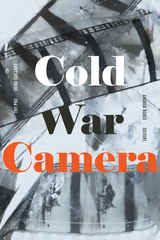 Cold War Camera
Thy Phu, Erina Duganne, and Andrea Noble, editors
Duke University Press, 2023 Cold War Camera explores the visual mediation of the Cold War and illuminates photography’s role in shaping the ways it was prosecuted and experienced. The contributors show how the camera stretched the parameters of the Cold War beyond dominant East-West and US-USSR binaries and highlight the significance of photography from across the global South. Among other topics, the contributors examine the production and circulation of the iconic figure of the “revolutionary Vietnamese woman” in the 1960s and 1970s; photographs connected with the coming of independence and decolonization in West Africa; family photograph archives in China and travel snapshots by Soviet citizens; photographs of apartheid in South Africa; and the circulation of photographs of Inuit Canadians who were relocated to the extreme Arctic in the 1950s. Highlighting the camera’s capacity to envision possible decolonialized futures, establish visual affinities and solidarities, and advance calls for justice to redress violent proxy conflicts, this volume demonstrates that photography was not only crucial to conducting the Cold War, it is central to understanding it.
Contributors. Ariella Azoulay, Jennifer Bajorek, Erina Duganne, Evyn Lê Espiritu Gandhi, Eric Gottesman, Tong Lam, Karintha Lowe, Ángeles Donoso Macaya, Darren Newbury, Andrea Noble, Sarah Parsons, Gil Pasternak, Thy Phu, Oksana Sarkisova, Olga Shevchenko, Laura Wexler, Guigui Yao, Donya Ziaee, Marta Ziętkiewicz
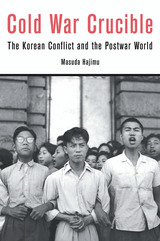 Cold War Crucible: The Korean Conflict and the Postwar World
Masuda Hajimu
Harvard University Press, 2014 The end of World War II did not mean the arrival of peace. The major powers faced social upheaval at home, while anticolonial wars erupted around the world. American–Soviet relations grew chilly, but the meaning of the rivalry remained disputable. Cold War Crucible reveals the Korean War as the catalyst for a new postwar order. The conflict led people to believe in the Cold War as a dangerous reality, a belief that would define the fears of two generations.
In the international arena, North Korea’s aggression was widely interpreted as the beginning of World War III. At the domestic level, the conflict generated a wartime logic that created dividing lines between “us” and “them,” precipitating waves of social purges to stifle dissent. The United States allowed McCarthyism to take root; Britain launched anti-labor initiatives; Japan conducted its Red Purge; and China cracked down on counterrevolutionaries. These attempts to restore domestic tranquility were not a product of the Cold War, Masuda Hajimu shows, but driving forces in creating a mindset for it. Alarmed by the idea of enemies from within and faced with the notion of a bipolar conflict that could quickly go from chilly to nuclear, ordinary people and policymakers created a fantasy of a Cold War world in which global and domestic order was paramount.
In discovering how policymaking and popular opinion combined to establish and propagate the new postwar reality, Cold War Crucible offers a history that reorients our understanding of what the Cold War really was.
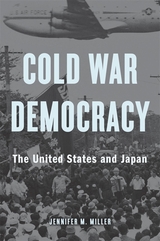 Cold War Democracy: The United States and Japan
Jennifer M. Miller
Harvard University Press, 2019 A fresh reappraisal of Japan’s relationship with the United States, which reveals how the Cold War shaped Japan and transformed America’s understanding of what it takes to establish a postwar democracy.
Is American foreign policy a reflection of a desire to promote democracy, or is it motivated by America’s economic interests and imperial dreams? Jennifer Miller argues that democratic ideals were indeed crucial in the early days of the U.S.–Japanese relationship, but not in the way most defenders claim. American leaders believed that building a peaceful, stable, and democratic Japan after a devastating war required much more than elections or a new constitution. Instead, they saw democracy as a psychological and even spiritual “state of mind,” a vigilant society perpetually mobilized against the false promises of fascist and communist anti-democratic forces. These ideas inspired an unprecedented crusade to help the Japanese achieve the individualistic and rational qualities deemed necessary for democracy.
These American ambitions confronted vigorous Japanese resistance. Activists mobilized against U.S. policy, surrounding U.S. military bases and staging protests to argue that a true democracy must be accountable to the Japanese people. In the face of these protests, leaders from both the United States and Japan maintained their commitment to building a psychologically “healthy” democracy. During the occupation, American policymakers identified elections and education as the wellsprings of a new consciousness, but as the extent of Japan’s remarkable economic recovery became clear, they increasingly placed prosperity at the core of a revised vision for their new ally’s future. Cold War Democracy reveals how these ideas and conflicts informed American policies, including the decision to rebuild the Japanese military and distribute U.S. economic assistance and development throughout Asia.
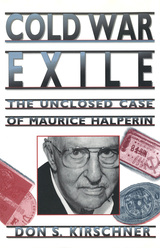 Cold War Exile: The Unclosed Case of Maurice Halperin
Don S. Kirschner
University of Missouri Press, 1995 In 1953 Maurice Halperin was called before the Senate Internal Security Subcommittee to defend himself on charges of espionage. He was accused of having supplied Soviet sources with classified material from the Office of Strategic Services while he was an employee during World War II. The Cold War was in full force. McCarthyism was at its peak. Caught up in the rapids of history, Maurice Halperin's life spun out of control. Denying the charges but knowing he could never fully clear his name, Halperin fled to Mexico and then, to avoid extradition, to Moscow. Among the friends he made there were British spy Donald MacLean and Cuban revolutionary leader Che Guevara. Disenchanted with socialism in the Soviet Union, he accepted Guevara's invitation to come to Havana in 1962. There he worked for Castro's government for five years before political tension forced him to leave for Vancouver, Canada, where he now resides. Was Halperin a spy or a scapegoat? Was he a victim of Red- baiting or a onetime Communist espionage agent who eventually lost faith in Communism? Halperin's accuser was Elizabeth Bentley, a confessed Soviet courier who accused more than one hundred Americans of spying. Yet Bentley had no proof, and Halperin continues to maintain his innocence. One of them was lying. As Kirschner unravels the engrossing facts of the case--utilizing FBI files and dozens of interviews, including extensive interviews with Halperin himself--the reader becomes the investigator in a riveting real-life spy mystery. Along the way Kirschner offers new material on the OSS and further disturbing information about J. Edgar Hoover's use of his considerable power. Maurice Halperin has lived a life like few Americans in our century. A left-wing American exile, he experienced two socialist worlds from the inside. In recounting the unclosed case of Maurice Halperin, Cold War Exile is both a gripping account of that remarkable life and a significant contribution to our understanding of a fascinating and controversial era in American political history.
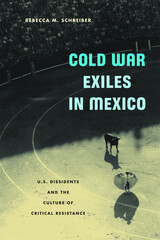 Cold War Exiles in Mexico: U.S. Dissidents and the Culture of Critical Resistance
Rebecca M. Schreiber
University of Minnesota Press, 2008 The onset of the Cold War in the 1940s and 1950s precipitated the exile of many U.S. writers, artists, and filmmakers to Mexico. Rebecca M. Schreiber illuminates the work of these cultural exiles in Mexico City and Cuernavaca and reveals how their artistic collaborations formed a vital and effective culture of resistance.
As Schreiber recounts, the first exiles to arrive in Mexico after World War II were visual artists, many of them African-American, including Elizabeth Catlett, Charles White, and John Wilson. Individuals who were blacklisted from the Hollywood film industry, such as Dalton Trumbo and Hugo Butler, followed these artists, as did writers, including Willard Motley. Schreiber examines the artists’ work with the printmaking collective Taller de Gráfica Popular and the screenwriters’ collaborations with filmmakers such as Luis Buñuel, as well as the influence of the U.S. exiles on artistic and political movements.
The Cold War culture of political exile challenged American exceptionalist ideology and, as Schreiber reveals, demonstrated the resilience of oppositional art, literature, and film in response to state repression.
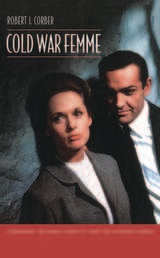 Cold War Femme: Lesbianism, National Identity, and Hollywood Cinema
Robert J. Corber
Duke University Press, 2011 In his bestselling book The Grapevine: A Report on the Secret World of the Lesbian (1965), Jess Stearn announced that, contrary to the assumptions of many Americans, most lesbians appeared indistinguishable from other women. They could mingle “congenially in conventional society.” Some were popular sex symbols; some were married to unsuspecting husbands. Robert J. Corber contends that The Grapevine exemplified a homophobic Cold War discourse that portrayed the femme as an invisible threat to the nation. Underlying this panic was the widespread fear that college-educated women would reject marriage and motherhood as aspirations, weakening the American family and compromising the nation’s ability to defeat totalitarianism. Corber argues that Cold War homophobia transformed ideas about lesbianism in the United States. In the early twentieth century, homophobic discourse had focused on gender identity: the lesbian was a masculine woman. During the Cold War, the lesbian was reconceived as a woman attracted to other women. Corber develops his argument by analyzing representations of lesbianism in Hollywood movies of the 1950s and 1960s, and in the careers of some of the era’s biggest female stars. He examines treatments of the femme in All About Eve, The Children’s Hour, and Marnie, and he explores the impact of Cold War homophobia on the careers of Joan Crawford, Bette Davis, and Doris Day.
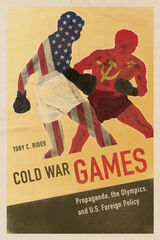 Cold War Games: Propaganda, the Olympics, and U.S. Foreign Policy
Toby C Rider
University of Illinois Press, 2016 It is the early Cold War. The Soviet Union appears to be in irresistible ascendance and moves to exploit the Olympic Games as a vehicle for promoting international communism. In response, the United States conceives a subtle, far-reaching psychological warfare campaign to blunt the Soviet advance. Drawing on newly declassified materials and archives, Toby C. Rider chronicles how the U.S. government used the Olympics to promote democracy and its own policy aims during the tense early phase of the Cold War. Rider shows how the government, though constrained by traditions against interference in the Games, eluded detection by cooperating with private groups, including secretly funded émigré organizations bent on liberating their home countries from Soviet control. At the same time, the United States utilized Olympic host cities as launching pads for hyping the American economic and political system. Behind the scenes, meanwhile, the government attempted clandestine manipulation of the International Olympic Committee. Rider also details the campaigns that sent propaganda materials around the globe as the United States mobilized culture in general, and sports in particular, to fight the communist threat. Deeply researched and boldly argued, Cold War Games recovers an essential chapter in Olympic and postwar history.
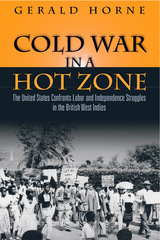 Cold War in a Hot Zone: The United States Confronts Labor and Independence Struggles in the British West Indies
Gerald Horne
Temple University Press, 2007 Beginning just before the start of World War II and ending during the Cold War, Gerald Horne's masterful examination of British Guiana and the British West Indies details the collapse of British colonial structures and the corresponding rise of U.S. regional influence. Horne reveals the realities of race and color in the Caribbean under colonial rule, while the colonizers-Britain, France, Germany, Japan, and the United States-battled each other for hegemony on the world stage. Horne seamlessly weaves a variety of untapped archival sources-including personal correspondence and newspaper stories from three continents-with a wide range of scholarly publications, journals and memoirs to illustrate an important, yet underexamined, regional history in a global context. Highlighting the centrality of the "labor question" in relation to colonial rule, Cold War in a Hot Zone is a compelling exposé of the racial dimensions of U.S. foreign policy and anti-communist initiatives during WWII and the Cold War that followed.
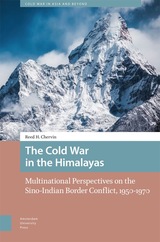 The Cold War in the Himalayas: Multinational Perspectives on the Sino-Indian Border Conflict, 1950-1970
Reed Chervin
Amsterdam University Press, 2024 Extensive in scope and drawing on newly available evidence from multinational archives, this book reconsiders Sino-Indian border issues during the middle Cold War using multiple established analytical frameworks. It demonstrates how key countries perceived and engaged with the border conflict by aiding the two main participants morally and materially. Before, during, and after the 1962 Sino-Indian border war, multinational political actors pursued their foreign policy goals (e.g., trade, security, and prestige) concerning the frontier, and often tried to destabilize spheres of influence and bolster alliances. Therefore, this contest signified a variation of the Anglo-Russian Great Game in Asia during the nineteenth century, and the theater of operations encompassed not only the border itself, but also the Himalayan kingdoms, Tibet, and Burma. A reevaluation of the border conflict between India and China is necessary given current, ongoing clashes at their still unresolved border as well as the fact that these two countries now possess enhanced technology and weapons.
 Cold War on the Airwaves: The Radio Propaganda War against East Germany
Nicholas J. Schlosser
University of Illinois Press, 2015 Founded as a counterweight to the Communist broadcasters in East Germany, Radio in the American Sector (RIAS) became one of the most successful public information operations conducted against the Soviet Bloc. Cold War on the Airwaves examines the Berlin-based organization's history and influence on the political worldview of the people--and government--on the other side of the Iron Curtain. Nicholas J. Schlosser draws on broadcast transcripts, internal memoranda, listener letters, and surveys by the U.S. Information Agency to profile RIAS. Its mission: to undermine the German Democratic Republic with propaganda that, ironically, gained in potency by obeying the rules of objective journalism. Throughout, Schlosser examines the friction inherent in such a contradictory project and propaganda's role in shaping political culture. He also portrays how RIAS's primarily German staff influenced its outlook and how the organization both competed against its rivals in the GDR and pushed communist officials to alter their methods in order to keep listeners. From the occupation of Berlin through the airlift to the construction of the Berlin Wall, Cold War on the Airwaves offers an absorbing view of how public diplomacy played out at a flashpoint of East-West tension.
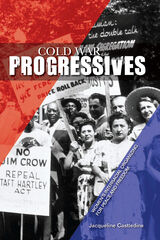 Cold War Progressives: Women's Interracial Organizing for Peace and Freedom
Jacqueline Castledine
University of Illinois Press, 2012 In recognizing the relation between gender, race, and class oppression, American women of the postwar Progressive Party made the claim that peace required not merely the absence of violence, but also the presence of social and political equality. For progressive women, peace was the essential thread that connected the various aspects of their activist agendas. This study maps the routes taken by postwar popular front women activists into peace and freedom movements of the 1960s and 1970s. Historian Jacqueline Castledine tells the story of their decades-long effort to keep their intertwined social and political causes from unraveling and to maintain the connections among peace, feminism, and racial equality. Postwar progressive women and their allies often saw themselves as members of a popular front promoting the rights of workers, women, and African Americans under the banner of peace. However, the Cold War indelibly shaped the contours of their activism. Following the Progressive Party's demise in the 1950s, these activists reentered social and political movements in the early 1960s and met the inescapable reality that their agenda was a casualty of the left-liberal political division of the early Cold War era. Many Americans now viewed peace as a leftist concern associated with Soviet sympathizers and civil rights as the favored cause of liberals. Faced with the dilemma of working to reunite these movements or choosing between them, some progressive women chose to lead such New Left organizations as the Jeannette Rankin Brigade while others became leaders of liberal "second wave" feminist movements. Whether they committed to affiliating with groups that emphasized one issue over others or attempted to found groups with broad popular-front type agendas, Progressive women brought to their later work an understanding of how race, class, and gender intersect in women's organizing. These women's stories demonstrate that the ultimate result of Cold War-era McCarthyism was not the defeat of women's activism, but rather its reconfiguration.
 Cold War Puerto Rico: Anti-Communism in Washington’s Caribbean Colony
Steve Howell
University of Massachusetts Press, 2026 A gripping history of FBI surveillance, political repression, and the fight for Puerto Rican independence
In the 1940s, with the construction of a naval base and a bombing range, Puerto Rico became a major geo-political military outpost for the United States. For a power claiming global leadership in a decolonizing world, however, the archipelago’s colonial condition underscored the dissonance between American democratic rhetoric and its imperial reality. The solution was a deal that, in 1952, gave Puerto Rico a degree of self-government without changing its legal status as an “unincorporated” US territory. The US then publicly claimed Puerto Rico was now more autonomous while using repressive tactics such as FBI surveillance, arrests, destabilization, and other methods developed in Washington to silence activists and political parties pushing for full independence.
In Cold War Puerto Rico, Steve Howell examines how J. Edgar Hoover and the FBI targeted Puerto Rican communists as part of an offensive against pro-independence parties and activists generally. Howell’s US-born father, who fell afoul of Hoover for producing radical cartoons while working in San Juan in the 1940s, remained on the FBI’s watch list long after exiling himself in Britain. His close friends, the Puerto Rican author Cesar Andreu Iglesias and Jane Speed de Andreu, were meanwhile arrested and imprisoned three times during the 1950s. Drawing on a wealth of new sources, including interviews and FBI files, Howell tells their stories along with those of other activists who battled indictment in 1954 under the Smith Act, challenged the jurisdiction of the House Un-American Activities Committee in San Juan in 1959, and revived the Puerto Rican independence movement in the 1960s, despite the FBI deploying the covert tactics of COINTELPRO against them.
Puerto Rico is virtually invisible in histories of what is generally called McCarthyism, yet anti-communist repression was in many ways more intense there than in the mainland US. Now, with Puerto Rico’s future currently hanging in the balance, Howell’s compelling history demonstrates why we need to understand the long enforcement of its colonial status.
 Cold War Puerto Rico: Anti-Communism in Washington’s Caribbean Colony
Steve Howell
University of Massachusetts Press, 2026 A gripping history of FBI surveillance, political repression, and the fight for Puerto Rican independence
In the 1940s, with the construction of a naval base and a bombing range, Puerto Rico became a major geo-political military outpost for the United States. For a power claiming global leadership in a decolonizing world, however, the archipelago’s colonial condition underscored the dissonance between American democratic rhetoric and its imperial reality. The solution was a deal that, in 1952, gave Puerto Rico a degree of self-government without changing its legal status as an “unincorporated” US territory. The US then publicly claimed Puerto Rico was now more autonomous while using repressive tactics such as FBI surveillance, arrests, destabilization, and other methods developed in Washington to silence activists and political parties pushing for full independence.
In Cold War Puerto Rico, Steve Howell examines how J. Edgar Hoover and the FBI targeted Puerto Rican communists as part of an offensive against pro-independence parties and activists generally. Howell’s US-born father, who fell afoul of Hoover for producing radical cartoons while working in San Juan in the 1940s, remained on the FBI’s watch list long after exiling himself in Britain. His close friends, the Puerto Rican author Cesar Andreu Iglesias and Jane Speed de Andreu, were meanwhile arrested and imprisoned three times during the 1950s. Drawing on a wealth of new sources, including interviews and FBI files, Howell tells their stories along with those of other activists who battled indictment in 1954 under the Smith Act, challenged the jurisdiction of the House Un-American Activities Committee in San Juan in 1959, and revived the Puerto Rican independence movement in the 1960s, despite the FBI deploying the covert tactics of COINTELPRO against them.
Puerto Rico is virtually invisible in histories of what is generally called McCarthyism, yet anti-communist repression was in many ways more intense there than in the mainland US. Now, with Puerto Rico’s future currently hanging in the balance, Howell’s compelling history demonstrates why we need to understand the long enforcement of its colonial status.
Cold War Rhetoric: Strategy, Metaphor, and Ideology
Martin J. Medhurst
Michigan State University Press, 1997 Cold War Rhetoric is the first book in over twenty years to bring a sustained rhetorical critique to bear on central texts of the Cold War. The rhetorical texts that are the subject of this book include speeches by Presidents Eisenhower and Kennedy, the Murrow- McCarthy confrontation on CBS, the speeches and writings of peace advocates, and the recurring theme of unAmericanism as it has been expressed in various media throughout the Cold War years. Each of the authors brings to his texts a particular approach to rhetorical criticism—strategic, metaphorical, or ideological. Each provides an introductory chapter on methodology that explains the assumptions and strengths of their particular approach.
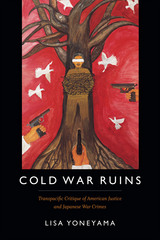 Cold War Ruins: Transpacific Critique of American Justice and Japanese War Crimes
Lisa Yoneyama
Duke University Press, 2016 In Cold War Ruins Lisa Yoneyama argues that the efforts intensifying since the 1990s to bring justice to the victims of Japanese military and colonial violence have generated what she calls a "transborder redress culture." A product of failed post-World War II transitional justice that left many colonial legacies intact, this culture both contests and reiterates the complex transwar and transpacific entanglements that have sustained the Cold War unredressability and illegibility of certain violences. By linking justice to the effects of American geopolitical hegemony, and by deploying a conjunctive cultural critique—of "comfort women" redress efforts, state-sponsored apologies and amnesties, Asian American involvement in redress cases, the ongoing effects of the U.S. occupation of Japan and Okinawa, Japanese atrocities in China, and battles over WWII memories—Yoneyama helps illuminate how redress culture across Asia and the Pacific has the potential to bring powerful new and challenging perspectives on American exceptionalism, militarized security, justice, sovereignty, forgiveness, and decolonization.
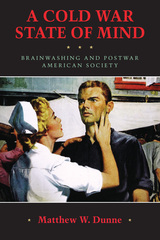 A Cold War State of Mind: Brainwashing and Postwar American Society
Matthew W. Dunne
University of Massachusetts Press, 2013 First popularized during the 1950s, the concept of "brainwashing" is often viewed as an example of Cold War paranoia, an amusing relic of a bygone era. Yet as Matthew W. Dunne shows in this study, over time brainwashing came to connote much more than a sinister form of Communist mind control, taking on broader cultural and political meanings.
Moving beyond well-known debates over Korean War POWs and iconic cultural texts like The Manchurian Candidate, Dunne explores the impact of the idea of brainwashing on popular concerns about freedom, individualism, loyalty, and trust in authority. By the late 1950s the concept had been appropriated into critiques of various aspects of American life such as an insistence on conformity, the alleged "softening" of American men, and rampant consumerism fueled by corporate advertising that used "hidden" or "subliminal" forms of persuasion. Because of these associations and growing anxieties about the potential misuse of psychology, concerns about brainwashing contributed to a new emphasis on individuality and skepticism toward authority in the 1960s. The notion even played an unusual role in the 1968 presidential race, when Republican frontrunner George Romney's claim that he had been "brainwashed" about the Vietnam War by the Johnson administration effectively destroyed his campaign.
In addition to analyzing the evolving meaning of brainwashing over an extended period of time, A Cold War State of Mind explores the class and gender implications of the idea, such as the assumption that working-class POWs were more susceptible to mind control and that women were more easily taken in by the manipulations of advertisers.
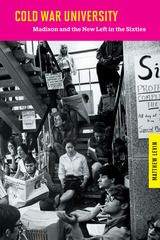 Cold War University: Madison and the New Left in the Sixties
Matthew Levin
University of Wisconsin Press, 2013 As the Cold War between the United States and the Soviet Union escalated in the 1950s and 1960s, the federal government directed billions of dollars to American universities to promote higher enrollments, studies of foreign languages and cultures, and, especially, scientific research. In Cold War University, Matthew Levin traces the paradox that developed: higher education became increasingly enmeshed in the Cold War struggle even as university campuses became centers of opposition to Cold War policies. The partnerships between the federal government and major research universities sparked a campus backlash that provided the foundation, Levin argues, for much of the student dissent that followed. At the University of Wisconsin in Madison, one of the hubs of student political activism in the 1950s and 1960s, the protests reached their flashpoint with the 1967 demonstrations against campus recruiters from Dow Chemical, the manufacturers of napalm. Levin documents the development of student political organizations in Madison in the 1950s and the emergence of a mass movement in the decade that followed, adding texture to the history of national youth protests of the time. He shows how the University of Wisconsin tolerated political dissent even at the height of McCarthyism, an era named for Wisconsin's own virulently anti-Communist senator, and charts the emergence of an intellectual community of students and professors that encouraged new directions in radical politics. Some of the events in Madison—especially the 1966 draft protests, the 1967 sit-in against Dow Chemical, and the 1970 Sterling Hall bombing—have become part of the fabric of "The Sixties," touchstones in an era that continues to resonate in contemporary culture and politics.
|
|
